THE RISE AND RISE OF ARGON & CO

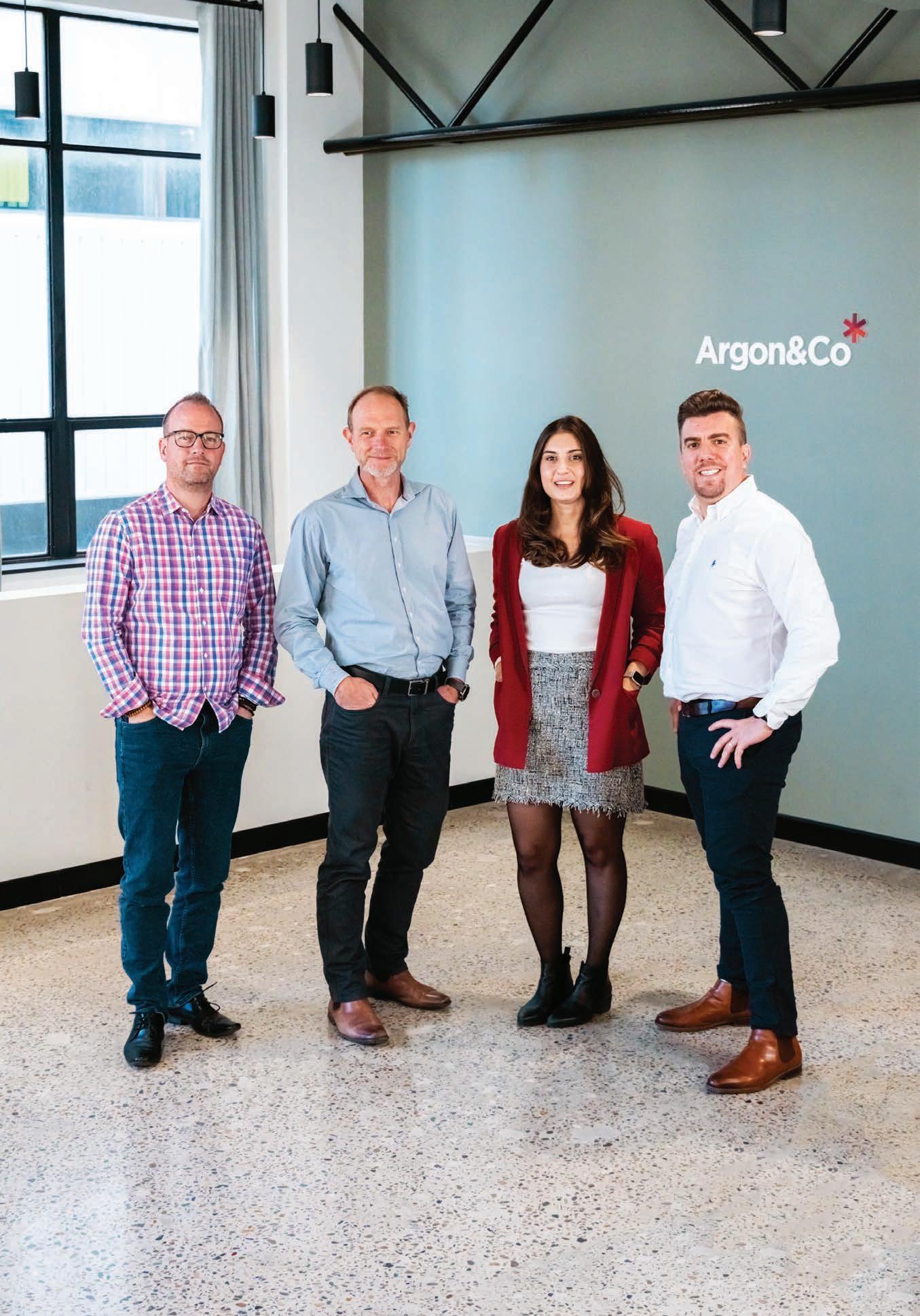
The transformation consultancy on its history, new acquisitions, and the future of intralogistics in ANZ
GIVING FOOD A VOICE
How Escavox is making the food supply chain visible LOGOS on the hottest industrial property opportunity in Australia
MOOREBANK INTERMODAL PRECINCT
AUGUST 2023
COVER STORY ™
Delays happen, but a bad customer experience should not.
We surveyed more than 2,200 consumers, across eight countries to learn more about their expectations between clicking ‘buy’ and when the product reaches their door.

To learn exactly what today’s customers expect and gain insight on how to make a loyal customer for life download our 2023 State of Shipping and Returns report. koerber-supplychain.com

Scan to Download
what factors customers rank #1 when it comes to shopping online
Learn
MHD
Supply Chain Solutions

CONTACT
MHD Supply Chain Solutions is published by Prime Creative Media
379 Docklands Drive, Docklands VIC 3008
Telephone: (+61) 03 9690 8766
Website: www.primecreative.com.au
THE TEAM
CEO: John Murphy
Chief Operating Officer: Christine Clancy
Managing Editor: Syed Shah
Editor: Edward Cranswick
Journalist: Joseph Misuraca
Business Development Manager: Beth Jarvis
Design Production Manager: Michelle Weston
Art Director: Blake Storey
Graphic Designers: Louis Romero, Kerry Pert
Client Success Manager: Janine Clements
FOR ADVERTISING OPTIONS
Contact: Beth Jarvis
beth.jarvis@primecreative.com.au
SUBSCRIBE
Australian Subscription Rates (inc GST)
1yr (6 issues) for $78.00
2yrs (12 issues) for $120.00 – Saving 20%
3yrs (18 issues) for $157.50 – Saving 30%
To subscribe and to view other overseas rates visit: www.mhdsupplychain.com.au or Email: subscriptions@primecreative.com.au
ACKNOWLEDGEMENT
MHD Supply Chain Solutions magazine is recognised by the Australian Supply Chain Institute, the Chartered Institute of Logistics and Transport Australia, the Supply Chain and Logistics Association of Australia and the Singapore Logistics and Supply Chain Management Society.


INNOVATION UNCHAINED
With August upon us, and the year’s end approaching rapidly, team MHD’s enthusiasm remains undimmed – having just recently returned from CeMAT 2023, which took place in Sydney from July 25-27. The excitement and energy were palpable as industry leaders, innovators, and stakeholders congregated, all of them bursting with fresh perspectives and visions for the future.
Trade shows like CeMAT are the lifeblood of our industry. They’re where connections are forged, partnerships are strengthened, and innovative ideas are showcased. The floor buzzes with the sound of collaboration, as professionals exchange insights and demonstrate their solutions.
This edition of MHD is brimming with riveting stories that underscore these themes of connection, innovation, and growth. While we wish we could spotlight each one in this space, I’ll draw your attention to three must-read features.
In “Introducing Mushiny Australia” we trace the journey of Mushiny from its ambitious origins to its strategic growth into the Australia-New Zealand market. Watch out for a deep dive into how this tech-centric company is transforming warehouse operations with their local team and robot-driven strategies.
Next, our feature “Giving Food a Voice” brings to light a problem that hits close to home for many suppliers – food wastage. The piece presents an in-depth conversation with Luke Wood, CEO of Escavox, who is tackling this issue head-on with an innovative food visibility solution.

And don’t miss our Cover Story this month, which pulls back the curtain on global management consulting firm Argon & Co. From its recent merger with ‘Warehouse Wizards’ Fuzzy LogX and New Zealand’s Studio Logistic, the story traces Argon’s journey, its corporate culture, and how these additions have fortified its intralogistics offering – particularly in New Zealand.
ARTICLES
All articles submitted for publication become the property of the publisher. The Editor reserves the right to adjust any article to conform with the magazine format.
COPYRIGHT
MHD magazine is owned by Prime Creative Media. All material in MHD is copyright and no part may be reproduced or copied in any form or by any means (graphic, electronic or mechanical including information and retrieval systems) without written permission of the publisher. The Editor welcomes contributions but reserves the right to accept or reject any material. While every effort has been made to ensure the accuracy of information Prime Creative Media will not accept responsibility for errors or omissions or for any consequences arising from reliance on information published. The opinions expressed in MHD are not necessarily the opinions of, or endorsed by the publisher unless otherwise stated.
While these are some highlights, remember that there’s a wealth of knowledge in the other stories we’ve got for you this issue. As always, our aim is to inspire you, challenge you, and keep you informed about the rapidly changing world of supply chain solutions.
Happy reading. See you next month.
Edward Cranswick Editor
edward.cranswick@primecreative.com.au
MHD AUGUST 2023 | 3
MHD FROM THE EDITOR




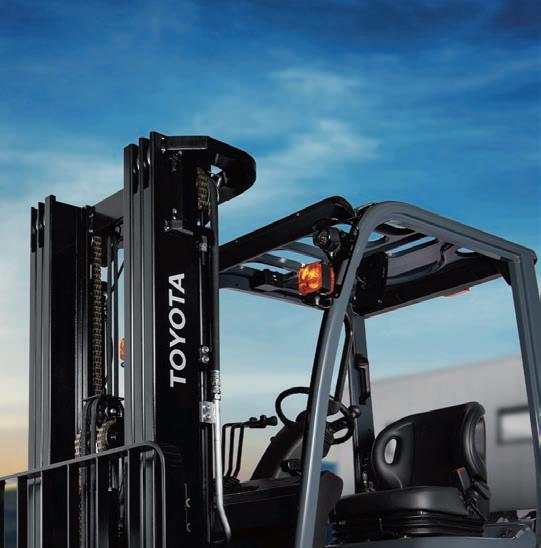
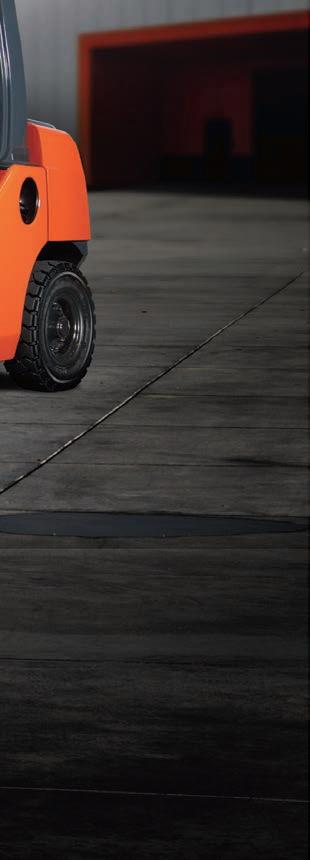
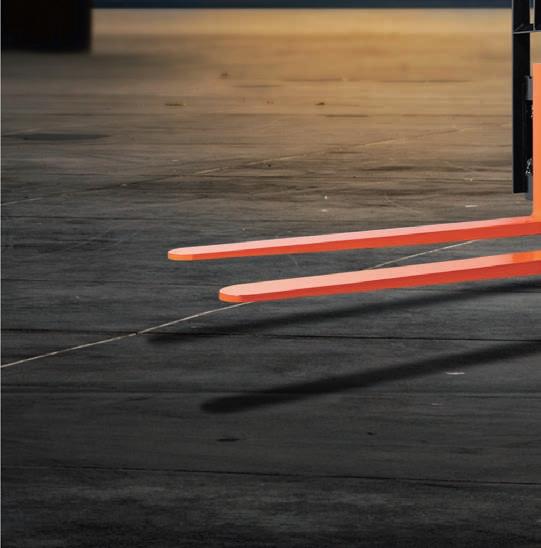
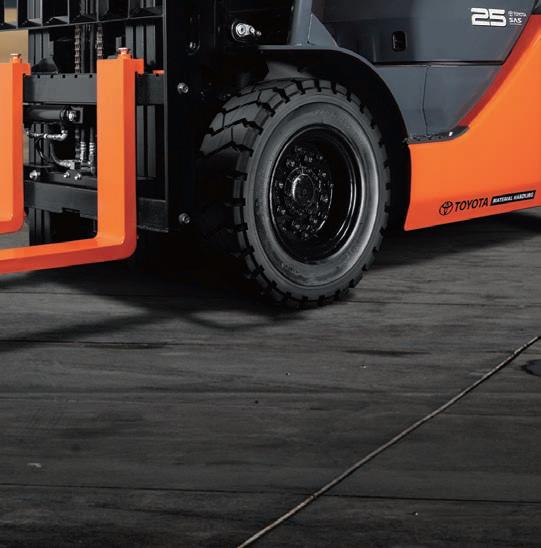

forklift we sell is built with the same precision and famous advanced manufacturing technologies as Toyota’s automotive products. But we don’t just say it, we’ve demonstrated it for over 50 years. That’s why when you choose to partner with Toyota Material Handling, you’re choosing our legendary quality, durability and reliability, and that’s just part of the Toyota Advantage. LEGENDARY RELIABILITY ANOTHER GREAT TOYOTA FORKLIFT ADVANTAGE toyotamaterialhandling.com.au 1800 425 438 SOLUTIONS FOR EVERY PALLET ®
Every
COVER STORY

18 The new and improved Argon & Co
REGULAR COLUMNS
22 Property Focus on midyear review
24 Logical Outlook on AI and supply chain

SUPPLY CHAIN
26 Project44 connecting supply chain dots with APIs
33 Körber unpacks shipping survey findings
37 Hai Robotics’ GM for ANZ in MHD Q&A
46 DLL on financing before automating
51 Dematic keeping it cool with its AGVs
54 Escavox preventing food spoils with visibility solution
73 Addverb unveils Bot-Verse in India
MATERIALS HANDLING

30 TMHA growing a NSW business and opening shop in Cairns
77 Hubtex moving refrigerated goods with forklifts
INDUSTRIAL PROPERTY
48 LOGOS spotlights Moorebank Intermodal Precinct

WAREHOUSING
28 NORD minimising TOCs for supply chain

41 Tompkins Robotics speaks about its configurable software
44 Richmond rolling out robotic solutions with ForwardX

56 Mushiny enters ANZ market
59 Microlistics on the future of warehousing
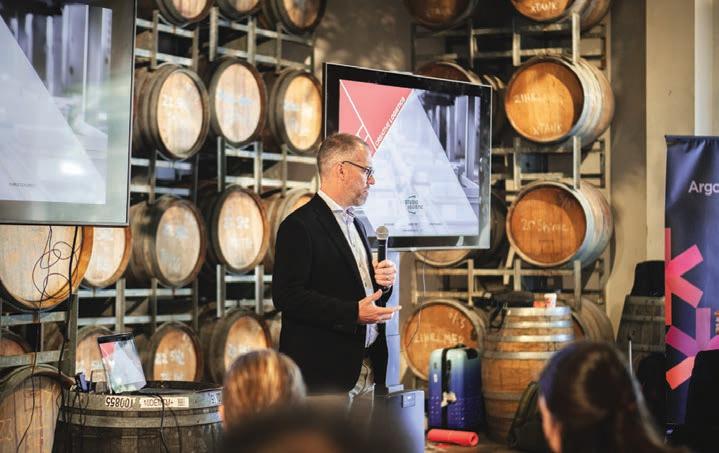
63 GPC opens DC in Melbourne’s north
67 Vanderlande automating with ADAPTO and FASTPICK ASSOCIATIONS,
MHD AUGUST 2023 | 5
EVENTS, AND REGULARS
News
holding construction event
SCLAA’s roundtable on Pathway to Progress
Product Showcase
People on the Move How Escavox is making the food supply chain visible LOGOS on the hottest industrial property opportunity in Australia MOOREBANK INTERMODAL PRECINCT AUGUST 2023 GIVING FOOD A VOICE The transformation consultancy on its history, new acquisitions, and the future of intralogistics in ANZ THE RISE AND RISE OF ARGON & CO COVER STORY
THE COVER
delves into the Argon & Co story – where it’s been, how it’s changed, and where it’s going
2023
31
STORY 16 ISSUE #7 VOLUME 53 47
06 Industry
80 PCM
82
84
85
ON
MHD
AUGUST
THIS ISSUE
COVER
DHL APPOINTS NEW ANZ CFO
DHL Supply Chain has announced the appointment of Brindha Pillay as Chief Financial Officer (CFO) of Australia and New Zealand (ANZ), who will now succeed Craig Roberts.

The contract logistics solutions company says Craig has been an invaluable member of the DHL Group for almost three decades and he will relocate to undertake a DHL role overseeing Europe, the Middle East and Africa (EMEA).
It adds that Brindha has been a strong contributor to the organisation for more than 15 years, having started her DHL career as Australia’s finance manager.
“I have every confidence in Brindha’s abilities to step into the CFO role with her strong business acumen, developed in key finance roles both in Australia and internationally,” says Kwok-wai Lee, CFO, Asia Pacific, DHL Supply Chain.
“I have worked closely with Brindha and Craig over the years and have seen first-hand their excellent contributions to the DHL Supply
Chain business.”
Prior to this role, DHL notes Brindha was the Senior Vice President, Global Head of Accounting and Process Digitalisation Finance at DHL.
“I am excited to take on the role of CFO for DHL Supply Chain in ANZ and continue to champion excellence in the office of finance across the business,” Brindha says.
“Craig has built a strong finance organisation, and I’m committed to driving value for the organisation – focusing on strong financial performance, process innovation, and transformative growth.”
During Brindha’s time at DHL, she has championed a number of strategic initiatives, including the creation and implementation of the first key milestones of the overall strategy for the Accounting Function, globally.
“It gives me great pleasure to pass the torch to Brindha, whose exceptional skills and dedication will undoubtedly drive continued success for DHL Supply Chain in ANZ,” says Craig.
“I couldn’t think of a better person to succeed me and have full confidence in her ability to continue driving strategic value for the business. I’ve been working very closely with Brindha to ensure a smooth and successful transition.”
Craig has been a valued member of the DHL group for nearly 30 years, first joining in 1995 as a Financial Accountant in South Africa.
He held various CFO positions in APAC and EMEA before relocating to Australia in 2017 to lead the financial operations across ANZ.
INDUSTRIAL PROPERTY SECTOR REMAINS STRONG DESPITE RENTAL INCREASES
Colliers says industrial property sector proves resilient to continued economic headwinds, as average national prime industrial values move from $3300 per sqm in Q1 to $3420 per sqm in Q2.
It adds that this has happened despite yields softening by almost 18 basis points over the same period.
According to Colliers’ Head of Industrial Capital Markets Gavin Bishop, rents are mitigating the impact of average national prime yields of 5.27 per cent, ensuring industrial values are now on par with where they sat at the beginning of 2022, prior to interest rate and broader economic market
fluctuations.
“Following a contraction in average capital values through parts of 2022 as yield expansion outpaced rental growth, the situation has now reversed,” he adds.
“Average prime national rental growth of 40 per cent over the last 18 months has established the industrial sector as a stalwart in the broader commercial real estate investment market.
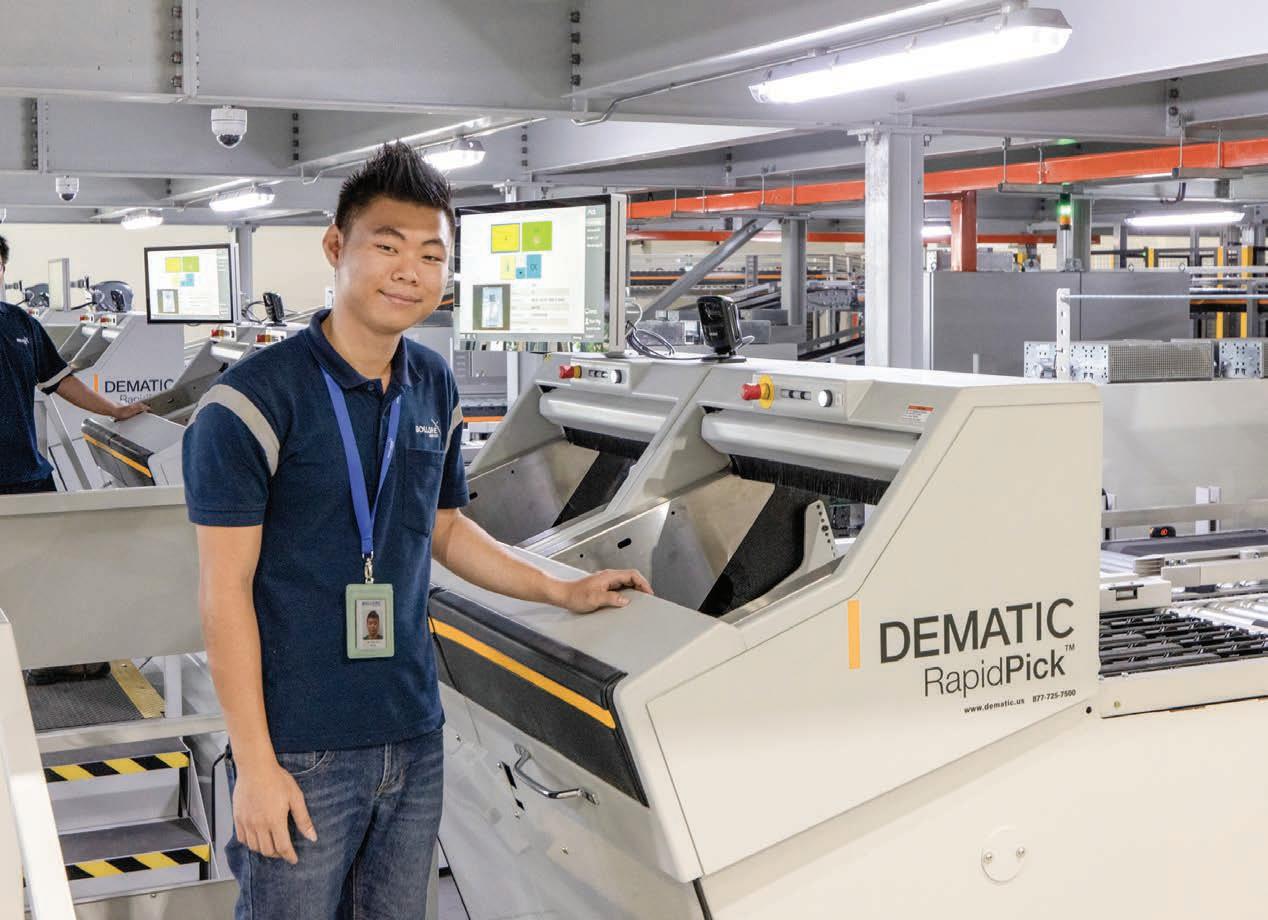
“As attention is drawn to industrial yields, it’s important to note their diluted impact on values has continued to attract new institutional and offshore investors. More recently, this included Cadillac Fairview partnering with
Gateway Capital to create a $1 billion logistics fund.”
Colliers’ research shows Sydney and Melbourne’s prime industrial assets continue to carry the mantle of the sector’s most prized investments, with average rental growth of 48.0 per cent and 29.9 per cent, respectively, since Q1 2022.
Rents underpinned an 8.9 per cent increase in Sydney’s prime industrial values over the same period, despite yields moving to 4.5 per cent to 4.75 per cent. They also shielded Melbourne’s industrial values, which have declined by a minor 2.8 per cent, in the face of current prime yields moving to 4.75 per
6 | MHD AUGUST 2023 MHD INDUSTRY NEWS & OPINION
Brindha was formerly DHL’s Senior Vice President, Global Head of Accounting and Process Digitalisation Finance.
to go in 20 minutes
It takes just 20 minutes for an order to be picked at Bolloré Logistics’ Blue Hub facility, tailor-built to handle online and store orders for perfumes and cosmetics. A Dematic Goodsto-Person system enables these superior customer service levels for Bolloré clients, optimising order fulfilment speed and accuracy while delivering very high productivity.
With space a premium in Singapore, the Dematic Multishuttle® high-throughput, high-density storage engine provides a 400% increase in capacity. The result: Flexibility, capacity and a superior service for Bolloré Logistics’ clients.

Read more and see it in action at www.dematic.com/bollore


Omni-Channel Speed, Productivity, Accuracy and Capacity for Bolloré Logistics. Ready
Dematic.com/bollore
9486 5555 info.anz@dematic.com Scan to watch the video!
02
cent to 5.00 per cent.
“While industrial leasing demand has subdued slightly due to economic conditions, the sector would need to jump from the current vacancy rate of 0.8 per cent to the equilibrium of 4.5 per cent, before market rental growth could be questioned,” Luke Crawford, Director of Research, says.
“For the sector to get back to a vacancy rate of 4.5 per cent, an
additional 2.9 million sqms of vacant stock would need to become available, which hasn’t occurred since we began tracking vacancy levels 10 years ago.
“Since 65 per cent of stock currently under construction is committed, and rental growth has continued to outpace historical averages, we expect it to remain elevated throughout 2023.”
While value-add investors looking to reposition or upgrade their assets
drove the jump in industrial transaction momentum from $440 million in Q1 to almost $1.3 billion in Q2 this year, leasing enquiry levels have normalised following record demand in 2021 and 2022.
Increasing by 7.3 per cent in Q2 and 28.3 per cent over the past year, Colliers notes some industrial markets may witness more than 30 per cent rental growth for the 2023 calendar year.
AUSTRALIA POST OPENS NEW REGIONAL HUB
Australia Post has officially opened its new parcel delivery centre in Ballarat, in what it says is deepening its long-term investment into the key regional hub.
The national postal service company notes the modern 13,024 sqm centre has been built to accommodate parcel volume growth in the region, as well as improve turnaround times, and help process more than 8000 parcels a day, and up to 20,000 during peak periods like Christmas.
Australia Post Executive General Manager Network Operations, Rod Barnes, says the multi-million-dollar investment into Ballarat and its surrounds including Birchip, Kaniva, Maryborough, and Daylesford, reflects Australia Post’s commitment to improving services for the community.
“As one of Victoria’s biggest regional cities, we’ve seen parcel delivery volumes increase by 80 per cent over the past three years, with data indicating that four in five Ballarat households are now shopping online.
“We expect this trend to continue, as the needs of local and other e-commerce businesses grow. Our new centre will enable faster parcel processing and turnaround times, getting deliveries to customers’ doors sooner.”
The Ballarat centre will introduce the latest in automated parcel sortation technology, which will be installed early next year.
This new parcel sorter will have the ability to sort a further 3000 parcels per hour, boosting the site’s overall
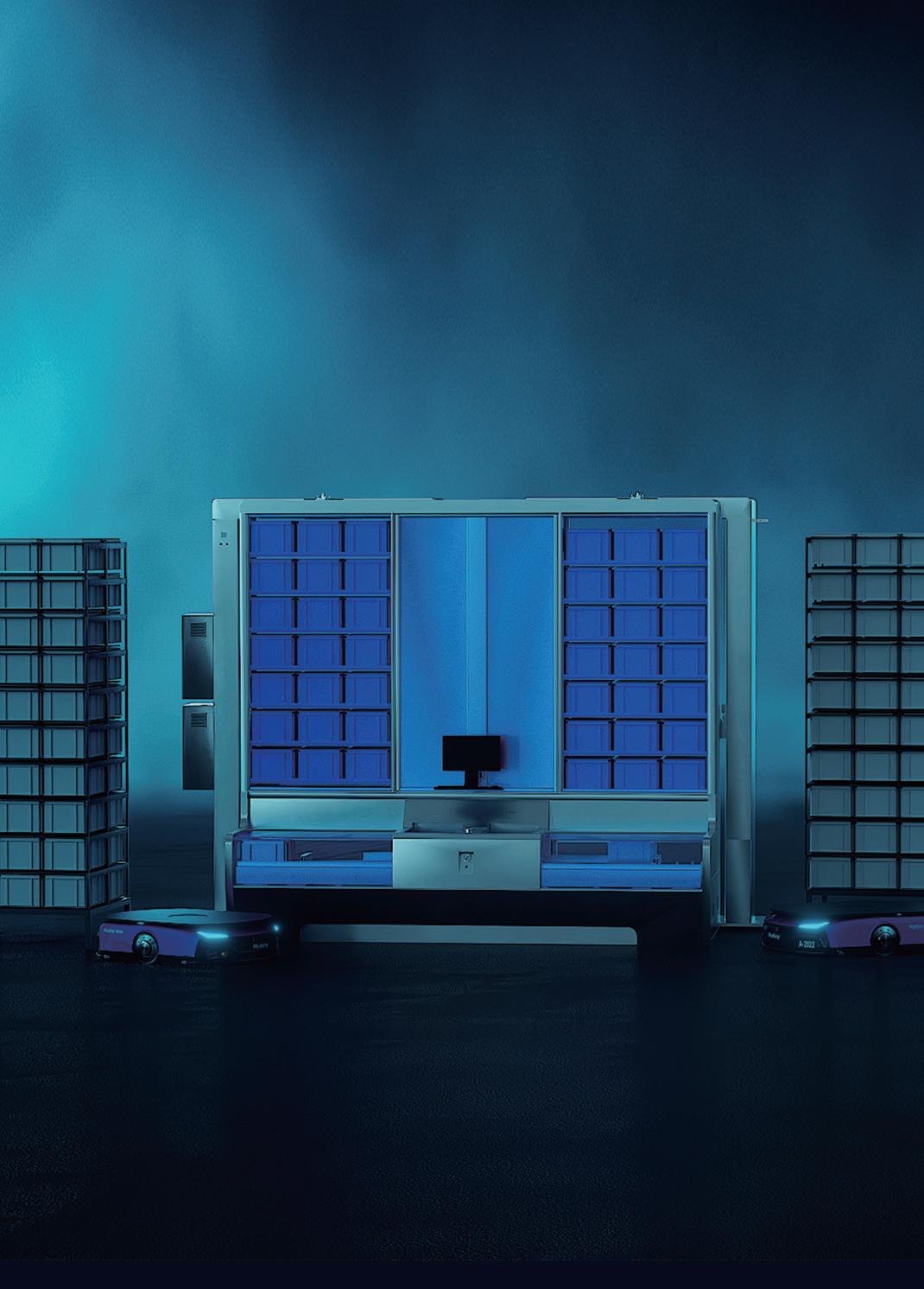
capacity with automation reducing manual handling and improving safety for team members.
Minister for Infrastructure and Member for Ballarat, Hon Catherine King MP, who officially opened the new parcel delivery centre, says Australia’s Post’s latest investment was a vote of confidence in the future of the company in regional Victoria.
“Australia Post and its hardworking staff have been at the heart of the Ballarat community since our first Post Office opened in a tent In Golden Point way back in 1851.
“This investment will give local Ballarat workers the facilities they deserve, as well as helping ensure our parcels and letters arrive safely and on time.”
Replacing two former temporary delivery centres at Bakery Hill and Wendouree, the larger, consolidated centre provides Australia Post team members with indoor space to load their vans and deliver the parcels promptly to customers.
The new centre will accommodate almost 160 Australia Post team members in the region.
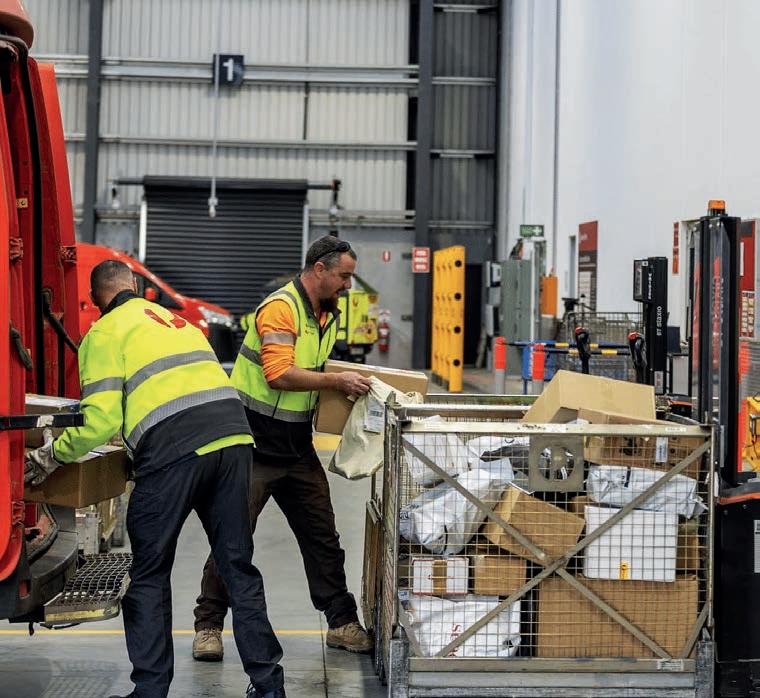
8 | MHD AUGUST 2023 MHD INDUSTRY NEWS & OPINION
The Ballarat centre will introduce the latest in automated parcel sortation technology.

AVOIDING COSTLY MISTAKES: THE IMPORTANCE OF ACCURATE PARCEL DIMENSIONING


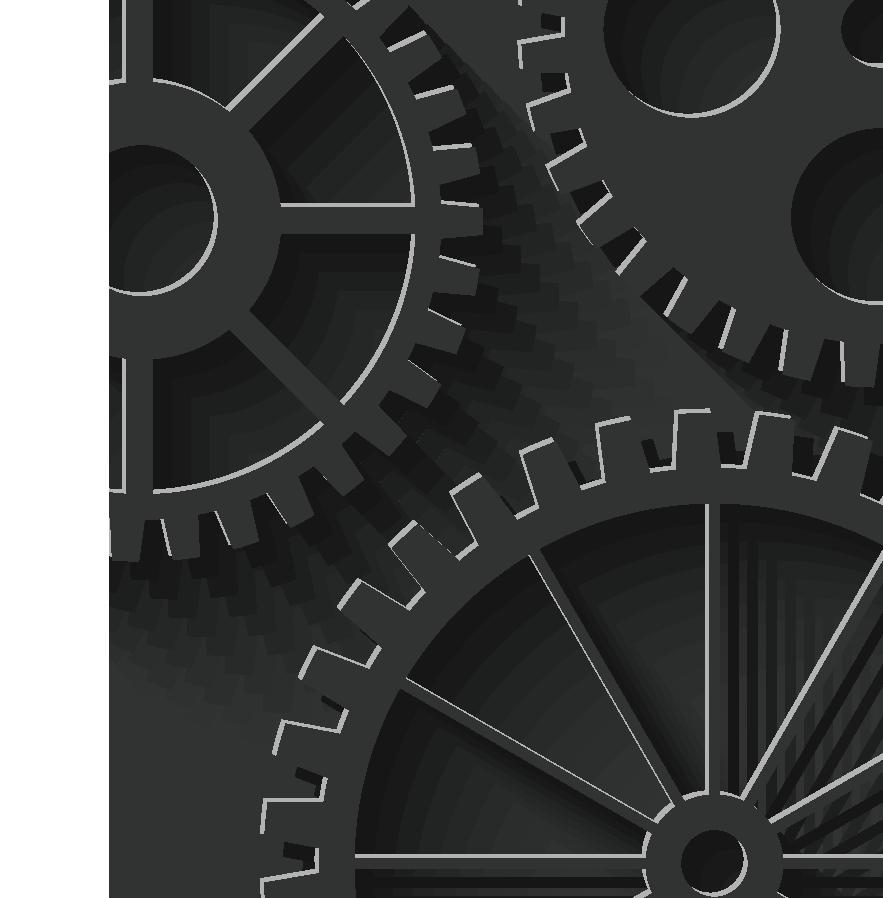
Zebra tells MHD about its Dimensioning Certified Mobile Parcel solution, which it says streamlines the shipping and logistics process, helping businesses ship packages and avoid incurring unnecessary costs.
Your revenue is directly tied to parcel dimensions. Accurate parcel dimensions during inbound operations also directly affect overhead costs and profitability. Yet, chances are accurate dimensions aren’t captured until parcels reach the central hub — where it is often too expensive to recapture small billing inaccuracies, and too late to reduce costs through improved utilisation of warehouse space and vehicles. The result? Millions of dollars in lost revenue and substantial increases in overhead costs, reducing profitability. Have you ever found yourself having to run additional trucks because parcel volume was not calculated properly? Or perhaps you incorrectly charged a customer for a package and had to spend time and money correcting it? Have you ever had to return a package due to insufficient postage, or made the tough decision to just ‘eat the loss’ because someone miscalculated size and therefore shipping? If you answered yes to any of the above, you’ll appreciate Zebra
Dimensioning Mobile Solutions’


Certified Mobile Parcel.
Zebra Dimensioning’s
Certified Mobile Parcel is an industry first from Zebra — an internationally certified, fully integrated handheld mobile dimensioning solution. You can get an accurate parcel or package measurement in a split second,

no matter where items are picked up or dropped off. This innovative technology streamlines the shipping and logistics process, ensuring you can confidently ship packages and avoid unnecessary expenses. Built for Zebra mobile computers, Certified Mobile Parcel is international weights and measures pre-certified by NTEP (US), OIML (EU/EFTA), MC (Canada), NMI (Australia) and MBIE (New Zealand). These valuable certifications enable mobile dimensioning that is certified as legal for trade, enabling accurate calculation of shipping charges at the point of parcel pickup and beyond — from homes and businesses to parcel shops, satellite pick-up points and more.
This solution offers advanced features that put it in a class of its own. Its fast measurements can capture dimensions in less than five seconds. Full integration means there are no snap-on accessories to impact ergonomics, ease of use, durability, calibration, or reliability. And since it’s a fully mobile solution, dimensions can be captured wherever it will benefit your
business — from doorstep collection in homes and businesses to parcel drop-off locations, warehouses, depots, and hubs. Integration is fast and easy — this complete solution has everything you need to get up and running: the integrated Time of Flight sensor, pre-installed and sealed Zebra Dimensioning Service and application and a Zebra Mobile Dimensioning Application Programming Interface (API) that makes integrating the capture of parcel dimensions into enterprise backend systems as easy as the capture of barcodes. Capture a wide range of box sizes and types in practically any lighting condition and background. Boxes can be plain, wrapped or printed with graphics. With flexible aiming, you can just point the red aiming dot on the top surface of the parcel for first-time, every-time capture of accurate dimensions — even if there are other parcels visible in the camera window. And since you can aim straight down or at an angle, parcels can be on the floor or a counter.
Now, the same Zebra mobile computers that streamline everyday processes for drivers, employees in parcel shops, warehouse workers and more can also capture accurate parcel dimensioning in seconds. The result is increased workforce productivity and efficiency, better customer service, increased revenue, and reduced disputes and damage claims. By leveraging this technology, you can better utilise your warehouse and delivery vehicle fleet, ultimately extracting more value from the Zebra mobile devices that power your operations.
10 | MHD AUGUST 2023 MHD INDUSTRY NEWS & OPINION
Zebra Dimensioning’s Certified Mobile Parcel is an industry first from Zebra.




















HOW TO AVOID THESE THREE COMMON AUTOMATION MISTAKES
While most organisations accept the need to automate their warehouse operations, they don’t know what steps to take or when to take them. Here, Rhyce Dawson, Senior Consultant at TMX Global, reveals the most common automation mistakes – and how to avoid them.

Organisations often don’t know where to begin their digital transformation or automation journey. The business must change, but it may not have the people, processes, or capability. There may be a lack of project formality, or inhouse skillsets to usefully comprehend the information moving through the organisation’s supply chain operation every day.
Sticking to key, guiding principles upfront can help make it a less daunting undertaking. Here is how your organisation can avoid the most common missteps.
Mistake
1 – Going it alone.
Instead: Establish a cross-functional team and be inclusive.
Many organisations underestimate the diverse skillsets needed to extract, share, and apply valuable insights. Often projects are led by a traditional procurement department with a black-and-white mentality, where bureaucratic layers stall critical project progression and momentum. A committed, cross-functional team who are supported to succeed is essential.
Secondly, where the organisation doesn’t employ skillsets such as engineering, or they exist but a largescale automation project is new, it’s important to engage specialists.
If design and implementation go wrong, they do so with spectacular cost. Therefore, it’s essential to protect yourself and de-risk your projects by engaging external parties or upskilling your employees – often both.
In the same vein, at Gartner’s recent Supply Chain Symposium, Caroline Chumakov, Director Analyst of Gartner’s Supply Chain Practice spoke of the need for CSCOs to break down projects into component tasks and seek skills needed for those tasks across the entire organisation.
Mistake 2 – Assuming you need to invest big.
Instead: Don’t rush and start small. What, when, and how to automate depends on where you are now and where you want to be in the future. Businesses need to ask themselves: “What is A, what is B, and how do l get from A to B?”
Companies may assume automation necessitates long lead times and multi-million-dollar investments. But, if due diligence is carried out upfront, opportunities for tactical initiatives pop up.
Take the process of selecting an automation vendor or solution: how can an organisation evaluate the options without knowing where they are, where they need to be, and then assessing the costs, challenges, and risks associated with any decisionmaking?
It does not always have to be a large-scale transformation. Often, incremental change in a warehouse results in automated solutions because they are the optimal choice.
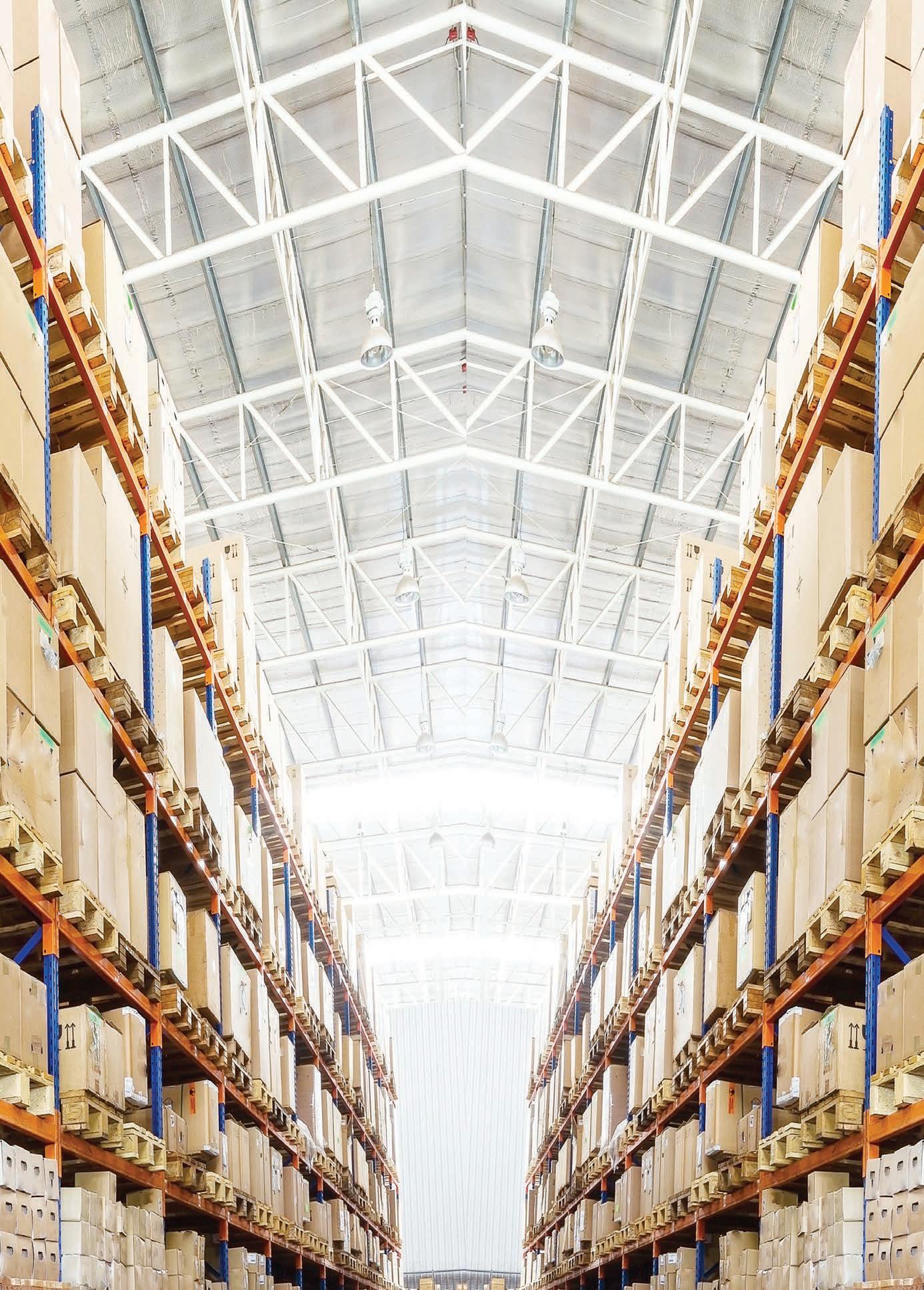
But if an organisation ploughs ahead with a transformation plan and automation vendors, they may invest in a solution that does not drive the best outcome for their business – and at a significant cost.
An initial investment in an operational diagnostic often saves hundreds of thousands in operational costs through tactical operational improvements, and millions in preventative capital investments. Remember, automation is not always the answer.
Mistake 3 – Hesitating.
Instead: Accept uncertainty and pull the trigger with a high degree of confidence.
Every operation changes gradually and can unintentionally become inefficient, unpredictable, and unsuitable for automation.
Data can predict where this might happen, but far too often these “what if” moments paralyse a project.
An operation is fluid regardless of the manual or automated status of the site. Vendors test the sensitivity of their designs, but the only thing that is certain is that design projections are never guaranteed. Project teams may increase their contingency plans or aim for perfection – both of which can kill the project.
Systems can be made up of a wonderful mechanical maze of conveyors; however, they can be modified, manipulated, and adapted in the future.
Use the data to drive the best solution for the organisation, and carry out due diligence independently, objectively, and accurately.
Case study: Automation at a national scale
TMX partnered with Coles Group, one of Australia’s largest supermarkets, on a five-year automated fulfilment project. The investment in two of the largest
12 | MHD AUGUST 2023 MHD INDUSTRY NEWS & OPINION
Rhyce Dawson, Senior Consultant at TMX Global.

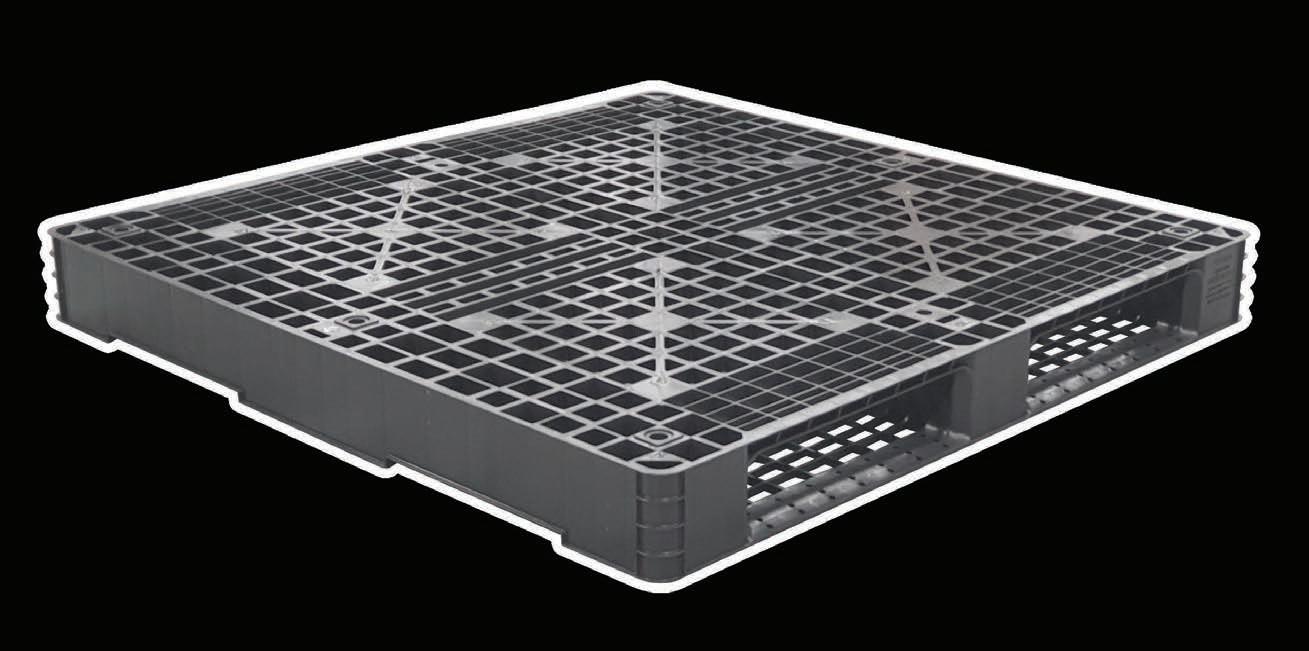

For more information, visit www.plasticpallet.com.au or call +61 (0) 2 9672 8588 NCHNEW A b LWR-116 SWL 1,000kg Reusable - Returnable - Recyclable Lower cost - Lighter weight Made in Australia
and most productive automated distribution centres in the world (the first of which opened in Redbank, Queensland, this year) enables Coles to efficiently service 219 supermarkets and deliver higher service levels for customers. Working with Coles and additional partners WITRON
Group, Goodman, and Richard Crooks Construction, TMX was engaged to develop highly technical design and architectural plans, procure property, and project manage the delivery of the facility – including integration of the automation.
Coles Group Chief Operating Officer,
Matt Swindells says: “Compared to a manual warehouse, these new automated warehouses will be able to handle twice the amount of volume of goods on half the footprint. It’s game changing.”
Rhyce Dawson, Senior Consultant at TMX Global
A NEW CONSULTANCY COLLABORATION OFFERING AGILE SOLUTIONS
Four consultants with diverse talents are teaming up to deliver a new approach to assessing client needs and tailoring solutions.
In today’s business environment, there are so many consultants selling solutions and optimisation strategies that it’s hard to keep track of them all. How do you sort the wheat from the chaff?
With so many things you could be doing, how do you know what you should be doing – and the order in which to do them?
To address this challenge, four consultants are teaming up to offer a collaborative approach that cuts to the core of the challenges facing SMEs today.
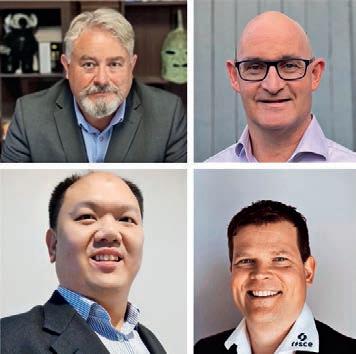
Reto Fuhrer, Brendan O’Keeffe, Tony Taslim, and Chris Baker – each of whom brings deep expertise and unique talents to the table – call their approach ‘X-RAY’, taking a snapshot
of businesses and tailoring solutions that target improvement in their priority areas.
The X-RAY approach focuses on four key dimensions: supply chain and logistics, lean and continuous improvement, data management and business systems, and circular economy and sustainability.

The team are excited by X-RAY’s value proposition, with the approach projected to pay for itself multiple times over – typically within the first year of engagement.
The X-RAY methodology hinges on a tried-and-tested roadmap. The journey commences with a comprehensive business assessment across key functional areas. The team employs value stream mapping as their tool of choice, documenting and visualising the flow of work and information throughout the organisation.
This aids in pinpointing the key opportunities for improvement, before collaborating with the client’s subject matter experts to dive deeper into specific issues to maximise these opportunities.
The result? A detailed report and an
14 | MHD AUGUST 2023 MHD INDUSTRY NEWS & OPINION
Chris Baker, Brendan O’Keeffe, Tony Taslim and Reto Fuhrer.
improvement plan, tailored to be executed by the client’s project teams, with ongoing support and guidance provided by Reto, Tony, Brendan, and Chris.
So – what does this mean in practice? Here’s a snapshot of the deliverables that X-RAY guarantees:
• Shorter Lead Times and Increased Capacity: Lean process improvements can unlock your company’s hidden potential, resulting in expedited lead times and increased throughput, often without the need for additional resources.
• Improved Quality: Implementing a quality system minimises losses and enhances client relationships by reducing defects and other quality problems. X-RAY aims for flawless delivery—right the first time, every time.

• Better Supply Chain Performance: Optimise your supply chain, synchronising your demand forecast with your supply plan. This avoids inventory excess or shortage, protecting both your output and bottom line.
• Optimised Data Performance: Transform raw data into actionable insights with streamlined business systems. The X-RAY method makes managing data effective and efficient, improving the reporting of key performance indicators (KPIs).
• Sustainability and Circularity Objectives: Transition towards a circular economy, creating cost savings, reducing waste, and enhancing resource efficiency.
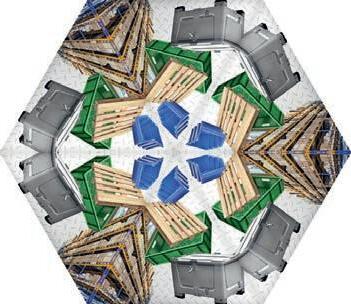
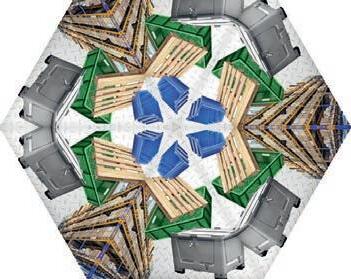


• Compliance and Risk Mitigation: Align your business with major clients’ compliance requirements and future sustainability and circular economy regulations, reducing the risk of penalties and legal issues associated with non-compliance, ensuring long-term business stability.
“Efficiency of processes is a key success factor for modern businesses,” says Reto Fuhrer. “The X-RAY concept offers a holistic approach for business process improvement. And as an expert in supply chain management and logistics, my skills contribute significantly to influence the bottom-line result by reducing costs while increasing service levels and revenue. I’m proud to be part of this new model.”
“I’m delighted to be a key partner in this collaboration where my expertise integrates and complements these business streams; supporting circularity & sustainability pillars with critical deliverables on profit and growth,” says Brendan O’Keeffe.
“X-RAY is a service that has a huge ROI potential for the client,” adds Chris Baker. “By working with Reto, Tony and Brendan, the increases in throughput and quality that I can bring as a process specialist are supercharged, so X-RAY starts paying for itself in the first few months.”
“Technology solves most challenges when used responsibly and ethically,” notes Tony Taslim. “X-RAY integrates a relevant technology assessment which intrinsically supports sustainable global supply chain and continuous improvements methodologies.”
This collaboration presents a unique opportunity for SMEs to benefit from the collective experience of a group of industry specialists. With a clear focus on results, X-RAY’s multi-dimensional approach – backed by four consultants with diverse yet complementary talents – offers an exciting new approach for unlocking growth.
NORD Drivesystems (AU) Pty Ltd I Fon +61 3 9394 0500 info@nord.com.au I www.nord.com OUR SOLUTION. YOUR SUCCESS. Extensive expertise for your application. Worldwide availability and service Reliable partner with fast response times Energy-efficient solutions based on a modular product concept
SAVING MILLIONS? ALL IN A FEW DAYS’ WORK FOR EXTOLLA
services including robotics and technology systems, software, network design, strategic sourcing, inventory strategy, ESG strategy planning, and automated DC optimisation and design.
“It’s about giving our clients’ supply chains the ‘X-factor’ that makes their business stand out and, ultimately, more than satisfies their customers,” says Peter.
“That could involve automation and robotics, supplier sourcing, de-risking, or improving network efficiency. But we don’t just show and tell. We show and do. Our focus is results, not PowerPoint presentations. We make it happen.”
It’s not just solutions and implementation capabilities where Extolla has an advantage. Its team has lived and worked in global brand supply chains across Asia Pacific, the Americas, Middle East, Africa, and Europe, giving its consultants the real-world expertise to navigate geographical and cultural sensitivities.
Meet the industry experts scoring instant seven-figure supply chain savings for APAC businesses.
How long does it take to see supply chain optimisation results? Just days, according to Extolla, the newest name in supply chain solutions.
Their secret? Insider knowledge. Extolla’s consultants are all supply chain and logistics experts who have worked in the same types of businesses and industries as their clients.
The result? Immediate, bottomline impact for Extolla’s customers across Australia, New Zealand, and Southeast Asia.
“One of our consultants saved a client $2 million within the project’s first week. That’s how quickly we can make a difference,” says Extolla CEO Peter Kendall, who formed
the business following a 20-plus year career in global supply chain leadership, including as Managing Director of enVista APAC.
“And that’s because we have hands-on experience and a deep understanding of client supply chain challenges. Our team makes Extolla unique – you’re partnering with people who have lived and breathed the issues you’re facing, except they have the tools, systems, and tech to solve them.”
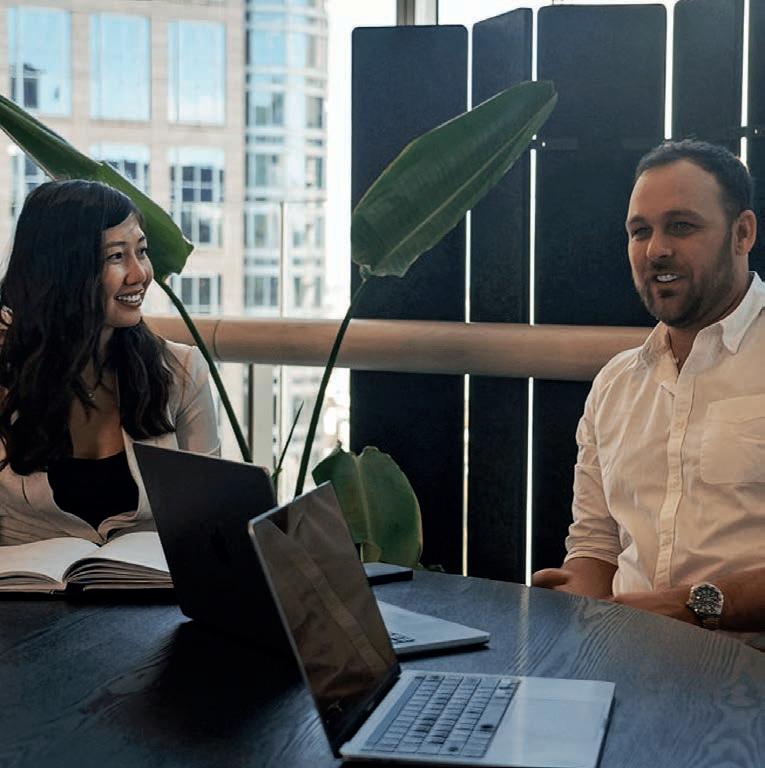
Transforming the supply chains of manufacturers, distributors, 3PLs, and omni-channel retailers through a technology-agnostic approach, Extolla engineers its platformneutral solutions for immediate impact and sustainable supply chain improvement.
The company provides key
“Each country has its way of doing business – any supply chain solution we provide has to fit in with that,” says Peter. “We’re fortunate to have a great team of people who bring a global array of life experiences and logistics skills to the table.”
Extolla’s stellar Exec team includes Director of Operations Chris Linden, an expert in WMS, TMS, and ERP supply chain technology and Chief Commercial Officer David Harrison, a global supply chain strategist and deal negotiator known for his ability to exceed performance targets and objectives.
“Our name ‘Extolla’ describes us perfectly,” summarises Peter. “It means to elevate, to advance. That’s what we do for our clients and for the people we work with. It’s a true team effort.”
16 | MHD AUGUST 2023 MHD INDUSTRY NEWS & OPINION
The company provides key services including robotics and technology systems, software, network design, and more.
ARGON & CO OFFERING INTRALOGISTICS
Argon & Co, the global management consultancy specialising in operations strategy and transformation, has announced the launch of its new ANZ Intralogistics service offering.
Intralogistics refers to the optimisation, integration, automation and management of the information and material flows within the four walls of a fulfilment or distribution centre.
The new service offering will cover several sub-services including: Intralogistics concept to go-live management, Intralogistics advanced analytics, Intralogistics process excellence benchmarking, Warehouse management and control systems, and Automation health check and rescue.
“The launch of Intralogistics as an additional service offering for Argon & Co in APAC will add deep technical expertise to an area, which is becoming increasingly relevant for our clients,”
Paul Eastwood, Managing Partner
ANZ, says.
“The addition of Fuzzy LogX and the recruitment of the Studio Logistics team in New Zealand brings an amazing depth of expertise in intralogistics. Combined with our own logistics, operations, and supply chain capabilities – it means together we can turbo-charge our endto-end offering – meeting our clients’ needs with market-leading solutions.”
Fuzzy LogX – who fully integrated with Argon & Co in June 2023 after joining earlier this year – will power the new Intralogistics service offering. It has a market-leading proposition in intralogistics, with expertise in warehouse automation and technology, and a proven track record of delivering large client engagements.

Like Argon & Co, Fuzzy LogX’s in-depth market knowledge delivers process improvements and lasting results for clients around the globe.
“We are delighted to officially be part of the Argon & Co family,” notes
“The joining of our businesses will provide both our clients access to an impressive array of complementary expertise, and this next chapter truly makes us a one-stop-shop for everything a supply chain could ever need.”
Jeffrey Triantafilo, former Partner of Fuzzy LogX and now Associate Partner of Argon & Co ANZ, says with Argon & Co’s and Fuzzy LogX’s combined expertise, they are wellequipped to confidently guide clients through the rapidly changing intralogistics landscape.
“We’ve always been confidently at our clients’ side throughout their entire transformation journey. But now we’re even more confident, at more clients’ side, and can provide an amplified and expanded set of solutions and possibilities.”
MHD INDUSTRY NEWS & OPINION
Bas Schilders, Founder of Fuzzy LogX and now Associate Partner of Argon & Co ANZ.
MHD AUGUST 2023 | 17
The new Intralogistics service will reinforce Argon & Co’s existing logistics capability in ANZ.
UNCOVERING ARGON & CO
In last year’s August edition of MHD Supply Chain Solutions, we told the story of intralogistics experts Fuzzy LogX, and how they came to lead the way in warehouse design and transformation. One year later, Fuzzy LogX – as well as its New Zealand equivalent and sometime collaborator, Studio Logistic – has merged with the global management consulting firm Argon & Co, extending the reach and power of all parties.
The success of the merger lies in the fact that it was a true merger: a meeting and merging of like-minds and cultures.
“We are excited to begin this new chapter,” says Bas Schilders, Associate Partner at Argon & Co, and previously Founder of Fuzzy LogX. “Fuzzy LogX has earned its place as the de facto intralogistics consultancy in ANZ by focusing on our client’s needs and being part of Argon & Co will give our clients access to an impressive array of complementary services.”
Jeff Triantafilo, Associate Partner at Argon & Co (who co-led Fuzzy with Bas) adds: “This is a great opportunity for us to provide specialist services to new clients, to improve their warehouse efficiency. We are now positioned to build a brighter future together for our consultants and clients.”
But to understand how and why the folks from Argon & Co, Fuzzy LogX, and Studio Logistic got together – and what the new Argon & Co brings to the table – we need to go back to the beginning.
ARGON & CO – ORIGIN STORY
“Argon – as it then was named –originated back in 2001 in Paris, with the formation by Yvan Salamon –today CEO of Argon & Co – who started a company focusing on operations and transformation,” says Sean Mitchell, Partner at Argon & Co.

Two years later, across the English Channel, Crimson & Co came into existence, founded by Crispin Mayer. The focus was similar: operations and strategic transformation. “Crimson’s business had a wider geographic
footprint, which included them making an acquisition in Australia of a company called Supply Chain Cover,” Sean says.
In a landmark moment for both companies, Argon and Crimson joined forces in 2018 under a new name: Argon & Co.
Back in Australia, 2016 saw the birth of Pollen, founded by Paul Eastwood (now Managing Partner of Argon & Co ANZ), and for whom Sean previously worked. Pollen was designed to serve as a comprehensive advisory service
18 | MHD AUGUST 2023 MHD COVER STORY
Argon & Co is quickly positioning itself to be the most comprehensive end-to-end operations and transformation consultancy in town, making strategic acquisition after strategic acquisition. Most recently, Argon & Co bolstered its intralogistics team in ANZ by merging with Fuzzy LogX and Studio Logistic. MHD speaks to Argon & Co’s Sean Mitchell and Richard Mahoney to discover the journey the company has taken, and what the new and improved Argon & Co offers the ANZ market today.
for CIOs, and it carved a niche for itself in the manufacturing sector, later expanding its scope into a broader supply chain market.
2021 heralded a key strategic partnership between Argon & Co and Colliers, a move aimed at integrating property into the supply chain offer – crucially important in light of rising property costs. “Building out our property capability – through mergers and the strategic alliance with Colliers – was something we viewed as essential,” says Sean. “Particularly as property has gotten more and more expensive, the move to driving warehouses with online e-commerce really underscored that a lot more work needed to be done in the market.”
Having such a giant property partner in Colliers has been a boon to Argon & Co, but it still had work to do to be able to deliver comprehensive solutions inside the four walls of the warehouse itself.
“We still needed some real local intralogistics muscle on the ground in ANZ,” Sean says.
This recognition led to collaborations with two leading local entities, Fuzzy LogX and Studio Logistic, and their eventual merger into the Argon & Co fold. “Fuzzy and Studio were the
two leading shops on either side of the Tasman in this respect and had the capability and the culture that we needed.”
NEW ZEALAND STUDIO
The tale of Studio Logistic reflects a shared passion for problem-solving in the logistics industry. As Richard Mahoney, the founder of Studio Logistic – now Associate Partner at Argon & Co – explains, the company was established in early 2019 out of a clear need to bridge the gap between theoretical logistics strategy and realworld implementation. “Studio was really there to do what was inside the fence line and that standard supply chain consultants couldn’t deliver,” says Richard.
Studio Logistic was conceived as a company that would effectively realise strategy in the real world, with many of its personnel equipped with engineering backgrounds. It positioned itself at the intersection of industrial engineering, architecture, and management consulting, offering a unique value proposition to the industry.
The uniqueness of Studio Logistic’s position in the market and its dedication to delivering effective logistics solutions led to successful collaborations with Argon & Co.
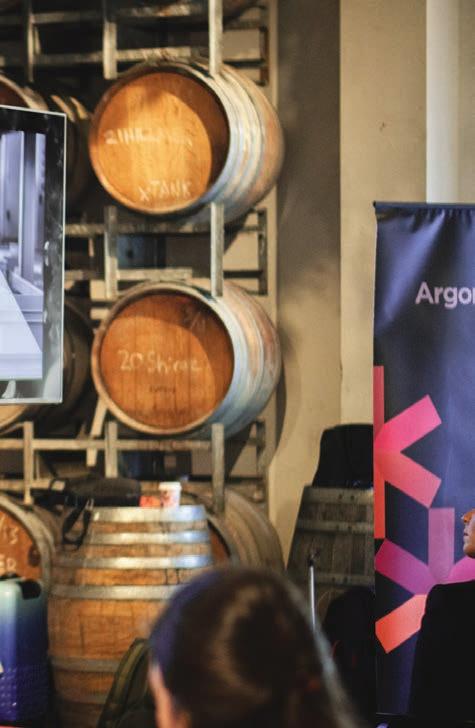
“We saw in each other people that came from similar backgrounds, came from technical and engineering backgrounds, who really cared about that aspect of things and really felt like there was an impact to be made around
it,” Richard recalls.
Separately, there developed a synergy between Studio Logistic in New Zealand, and Fuzzy LogX in Australia. Despite sometimes competing for work, there was a mutual desire to work together, and an impressive level of trust had been established, to the degree that during COVID Fuzzy and Studio formed an agreement that, should one go out of business, each would take on the other’s clients, so there’d be no drop-off in client service.
In the end, the separate decisions of both Studio and Fuzzy to merge with Argon were based on shared values, mutual trust, and a shared vision for what the logistics industry needed. “We really wanted to work with each other, we thought we could make a really big impact,” Richard says. “We also knew how much cooler it would be if we were somehow able to get the company barriers out of the way.
“We believed in a collaborative and inclusive culture, where everyone’s ideas and expertise were valued. That mentality, I think, played a huge part in our ability to merge successfully into Argon & Co.”
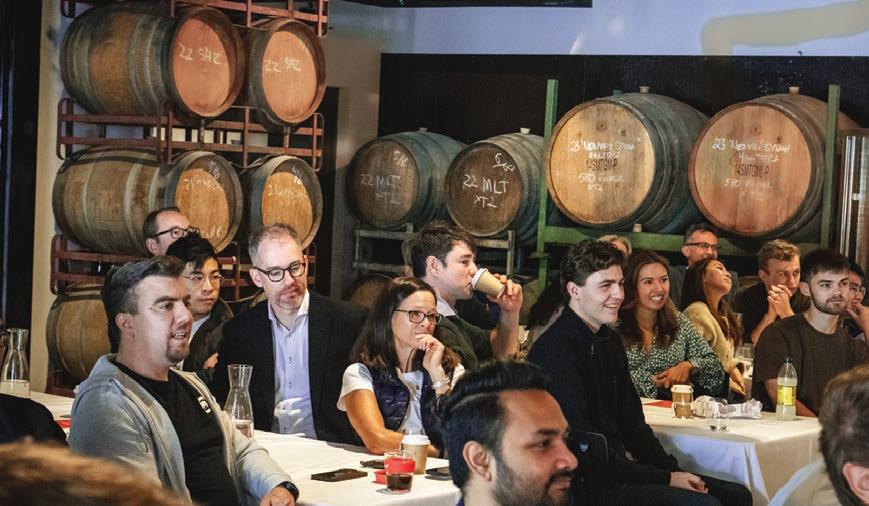
DELIVERING TRANSFORMATIONAL CHANGE
The supply chain and logistics industry’s realities are often vastly different from the theoretical concepts devised in boardrooms and meetings, notes Richard. Argon & Co, with its roster of professionals boasting strong engineering backgrounds, ensures that
MHD AUGUST 2023 | 19 MHD COVER STORY
Richard Mahoney, Associate Partner at Argon & Co, speaking at an event celebrating the merger.
The last two years have seen a massive expansion of Argon & Co’s reach and capabilities.
the gap between theory and practice is bridged through meticulous planning and first principles analysis.
“When you dig a little under the surface, you’ll find many people come from an engineering background, trained from the beginning in first principles,” says Richard. “So, you live in a world that contains things like physics, which you just can’t talk yourself out of. You need to be able to predict, for instance, that the building you’re sitting in will stand up, because it was designed by someone who could make that prediction.”
Many seemingly good ideas are built on faulty assumptions. Argon & Co brings an engineering mindset to bear on problems: thinking systematically and testing rigorously.
At the same time, Argon & Co is committed to delivering transformational change at a pace that significantly impacts the businesses they work with. This commitment also means a higher risk profile, making it imperative that every detail, no matter how minor, is thought through meticulously.
Delivering a successful warehouse or property project hinges on a detailed understanding of the undertaking’s complexity and purpose, a notion Argon & Co understands wholeheartedly, Richard says.

If a project isn’t properly executed, or the underlying details have not been sufficiently scrutinised, the chances of project failure increase: “If you get it wrong and turn on something that doesn’t work, you may not be able to make substantial changes or improvements.”
This is frequently apparent in the planning and construction of distribution centres. The task requires much more than a simple measure of square footage and the procurement of operational staff. Understanding the intricacies of the operation and predicting its functionality are vital steps in the process.
“Many people approach their DC-design process the wrong way around – getting what they can in terms of rough space requirements based on current projections, instead of assessing operations from first principles,” Richard says. “They go to the property market, saying, ‘I have a 10,000 square metre DC now. I think
I need another 10,000, maybe even 12,000. Go find me a 12,000 square metre DC.’ That’s not enough.
“It’s not about space, it’s about service. Can you efficiently pack and supply everything you need to your customers in a dependable way, so they continue to trust you and do business with you?”
He stresses that careful planning and design, coupled with a firm understanding of the operation’s requirements, is paramount. “At Argon we come in and lay out how we’ll set it up, how it will work, how much space it will require,” he says.
Predictability is another crucial factor in these large-scale projects. “It’s about design and planning capability, but also being able to predict results using first principles methods,” Richard says. Confidence in the project is only possible if there is a concrete demonstration of its potential success, especially when dealing with significant investments. “If a client is looking at spending 100 million bucks on automation, they need to be sure that these 100 million dollars are going to work.”
Demonstrating a project’s viability isn’t just about securing funds; it’s also about convincing stakeholders of its value. Richard explains that this involves taking them through the project’s details, reinforcing their belief in it, and giving them the assurance to back the project. “We can point to the things that prove it will work and take people through that journey so they can believe in it,” he says. “That’s a big part of getting the commitment
to do the project over the line with higher-ups.”
The merging of Studio Logistic into Argon & Co offered a plethora of opportunities for growth and improvement that go beyond the capabilities of each company standing alone.
“Importantly for me, Argon is committed to investment in this space,” Richard says. “Before I joined Argon & Co, making a significant investment in the space meant underwriting the whole company personally. There are limits to how much you can fund that way, or how much risk you’re prepared to take.” The merger with Argon & Co changes the dynamic, affording Richard – and Bas and Jeff from Fuzzy – access to investments that would have been impossible were they still operating solo.
Moreover, the merger allowed Studio Logistic to realise a long-held aspiration to have an international footprint, and thereby extend its reach beyond New Zealand’s comparatively small market.

“From a long-term planning perspective, I felt it was important to have a footprint at least in Australia, and probably abroad,” Richard says. “The inherent volatility of a small market makes the potential for expansion particularly valuable, as it allows for greater resilience and diversification.”
The integration of Studio Logistic and Fuzzy LogX into Argon & Co has created a unique synergy that complements Argon’s property
20 | MHD AUGUST 2023 MHD COVER STORY
Sean Mitchell, Partner, Argon & Co.
Richard Mahoney, Associate Partner, Argon & Co.
consultation services, forging a distinctively powerful offering in the market, according to both Sean and Richard.
“Together, we can offer a highly differentiated service,” Sean says. “This service spans from network review to potential warehouse downsizing, stock optimisation, and even considering a shift to third-party logistics in different locations. It’s a harmonious blend of what Argon, Studio Logistic, and Fuzzy LogX individually brought to the table.”
Richard echoes this sentiment, remarking on the importance of the end-to-end capabilities the new team offers: “The offering around the endto-end ability – to bring all those lenses into one project team – was a key part of why we used to collaborate as separate entities, and why bringing them under one name made sense. The merger hasn’t diluted our team’s commitment to tailored solutions –rather, it has heightened our ability to cater to each client’s unique needs.”
And Argon & Co maintains – just as Fuzzy LogX and Studio Logistic always did – a firm commitment to independence and solution agnosticism. “When we joined, we
were clear that we retain independence around solutions,” Richard says. “So, whether that is independent automation or independent property, it is still all about what is genuinely best for the company and best for the project.”
Sean agrees fully, saying simply, “It is the heart of our values and our value proposition at Argon & Co.”
ANTIPODEAN CHALLENGES
For Richard and Sean, the Australian and New Zealand landscapes offer unique challenges for intralogistics solutions.
“The big one is the pace and size of the change needed to keep up with what organisations are being asked to respond to,” Richard notes.
Today’s consumers expect quicker deliveries, transitioning from a tolerance of days to mere hours. This shift in expectations places significant pressure on industries, demanding adept, informed decisions underpinned by a reliable business case. “It requires the ability to work through the various solutions and predict how they will perform,” Richard explains, a feat Argon & Co’s intralogistics service is well-positioned to achieve.
Sean points to other challenges, particularly resource scarcity in the form of labour and physical spaces. “A few years ago, when you mentioned supply chain transformation, there was a bit of lethargy,” Sean says.
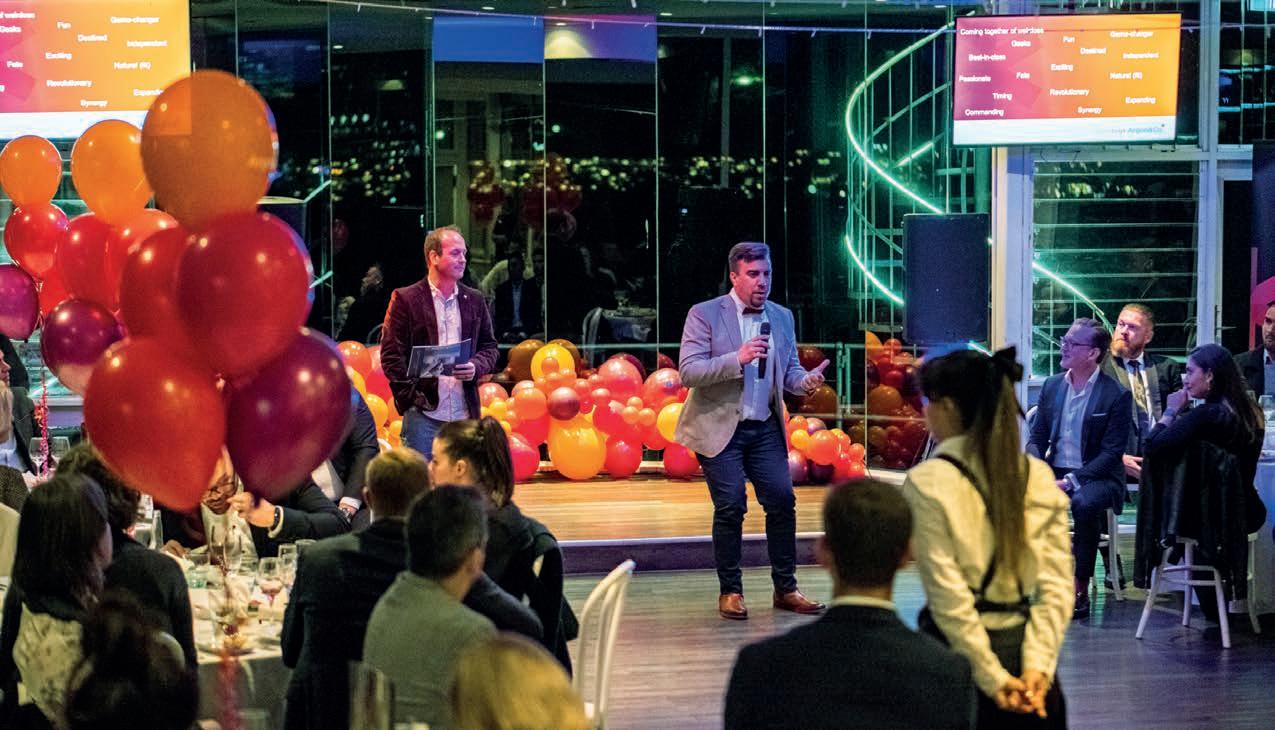
Now, the situation has changed.
“Low unemployment has switched the lens from labour productivity to labour scarcity. Together with historically low industrial vacancy rates, these issues pose significant obstacles to the success of logistics businesses.”
But Sean sees these challenges as drivers of change and opportunity for Argon & Co.
“There’s a culture more attuned to large-scale transformation, and all of that is driving the pace for change that positions us very well. While the challenges are substantial, they provide Argon & Co with a unique opportunity to apply our expertise and create transformational intralogistics – and broader supply chain – solutions.
“It’s a new chapter for Argon & Co in what has been a long story of transformation; transformation of ourselves the better to achieve game-changing transformations for our clients.” ■
MHD AUGUST 2023 | 21 MHD COVER STORY
Cultural and values alignment made possible the merging of Fuzzy LogX and Studio Logistic into Argon & Co.
MID-YEAR REVIEW
Broader macroeconomic factors have provided the backdrop to market volatility for the commercial real estate sector in 2023. Ultimately, this has resulted in asset value write downs for some sectors, particularly those that aren’t able to offset yield decompression with rising rents.
While the industrial and logistics sector has not been immune to higher inflation, rising funding costs and slowing economic growth, it remains in a unique position as fundamentals remain solid. Much of the sector’s strength lies within the occupier market, supported by record low vacancy rates, significant levels of rental growth and a lack of uncommitted supply. While industrial yields have risen, the sector has the benefit of record levels of rental growth which has maintained asset values.
RENTAL GROWTH SHOWING NO SIGNS OF ABATING
As we move to the middle of 2023, the sector’s performance has exceeded the expectations of many, and we are yet to see a slowdown in rental growth across most markets. At the same time, the wave of supply that was due to enter the market was expected to have a more material impact on vacancy rates, similar to what we are seeing in most US markets. However, the take-up of speculative facilities has been substantial, most of which has been expansionary space, and the commitment rate for facilities that will be delivered in 2023 already stands at close to 85%, meaning the structural undersupply of warehouse space will persist.
Globally, industrial rental growth has eased from the heights recorded in 2022 and has eventuated from more modest levels of demand and increased delivery of supply. In the US and UK, rental growth has fallen to high single digits, down from a high of ~25%
through parts of 2022.
Australia has yet to see the same slowdown, and this stems from the high pre-commitment rates of new supply. In the US, 57.8 million sqm of stock is currently under construction, equivalent to 3.6% of current stock.
For Australia, warehouse space under construction represents 2.4% of total stock, albeit with much higher pre-commitment rates –
20% in the US compared to 74% in Australia. As a result, there will remain fewer options for tenants in the Australian market, which will continue to fuel rental growth.
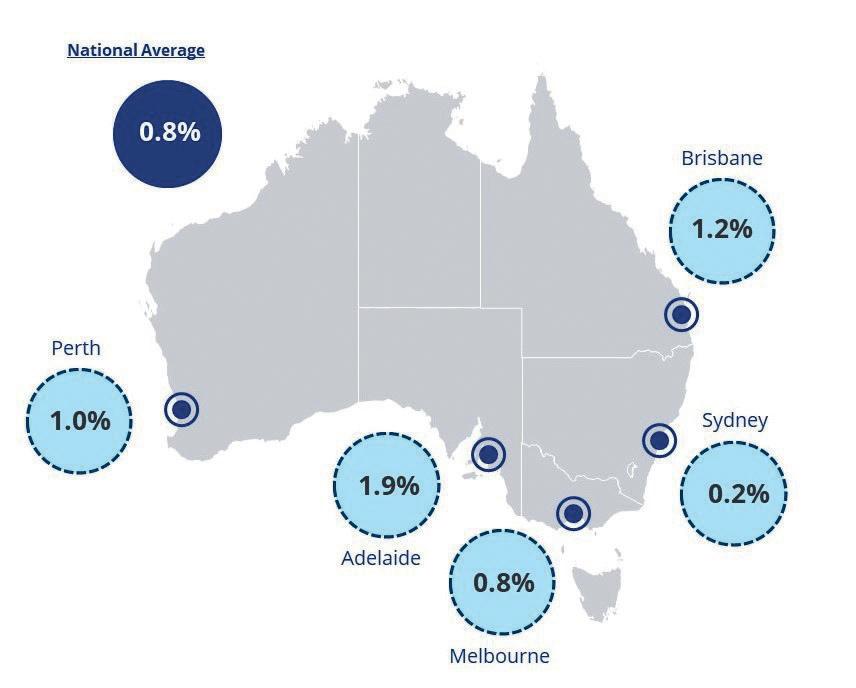
Looking ahead, rental growth for the balance of 2023 is forecast to remain elevated, with some markets predicted to record growth in excess of 30% for the year, noting growth of ~20% has already been recorded in select submarkets.

MHD COLLIERS PROPERTY FOCUS
In this month’s column, Colliers provide MHD with an in-depth analysis and mid year review on the industrial market.
Source: Colliers Research
Source: Colliers Research Data as at Q2 2023
PRIME ANNUAL NET FACE RENTAL GROWTH — Q2 2023
22 | MHD AUGUST 2023
NATIONAL INDUSTRIAL & LOGISTICS VACANCY RATES
MODEST RISE IN VACANCY, YET REMAINS CLOSE TO ALL-TIME LOWS
Nationally, the industrial and logistics vacancy rate increased marginally to 0.8% (up from 0.5% in Q1 2023) and was underpinned by several speculative developments reaching completion and minor backfill options becoming available. However, globally, Australia remains one of the tightest markets and compares to the vacancy rate in the US at 4.0% and the UK at 3.6%.
In our view, the market equilibrium is in the order of 4.5%, at which point rents tend to grow around their longterm average of ~3.5% per annum. For the Australian market to get back to this level of vacancy, an additional 2.9 million square metres of vacant stock would need to become available on top of what is available today, which based on the uncommitted supply in the pipeline and lease expires where we know the tenant is vacating for 2023 and 2024, is not expected to occur.
DEAL ACTIVITY IMPROVING
Further increases in the cash rate and funding costs have continued to impact yields and liquidity within the sector, and asset pricing remains the key theme as buyers and vendors adjust to new market conditions. Nonetheless, transaction activity increased over the past quarter with almost $1.4 billion trading, up from $437.4 million in Q1 2023 ($1.8 billion YTD 2023). At the same point in 2022, $3.7 billion has traded, representing a fall of 54% over the period. There is the potential that overall volumes could reach the levels recorded in 2022 as there is a significant volume
of recapitalisation and portfolio opportunities in the market.
In the first half of the year, value add capital has been the most active in the market and is driven by these groups looking to reposition assets via rental reversions, refurbishment or redevelopment, including for multi-level facilities. Infill markets remain the primary focus, and 70% of assets to trade in the first half of 2023 stemmed from such locations, up from 51% in 2022 and 14% back in 2020. Passive investors, particularly from the APAC region, have been more recently undertaking market and sector due diligence ahead of potential acquisitions and include portfolio and recapitalisation opportunities.
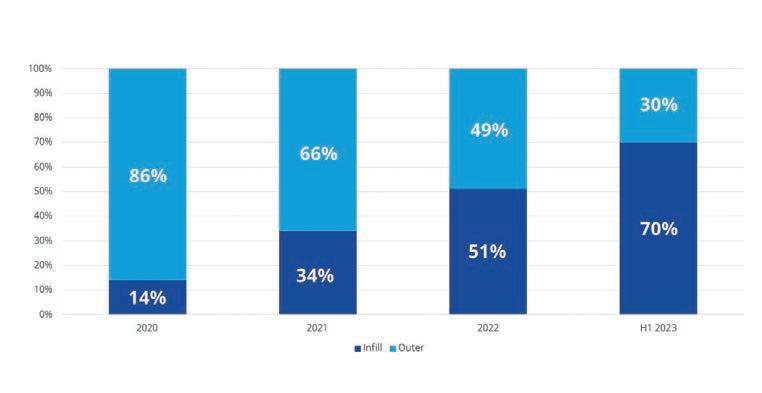
INDUSTRIAL VALUES HOLD STRONG AMID ECONOMIC HEADWINDS

As attention is drawn to commercial real estate yields more broadly, it’s important to note rental growth’s
INNER VS OUTER RING INVESTMENT VOLUMES
impact on asset values in the industrial and logistics sector. In the absence of rental growth, the yield softening recorded to date would ordinarily result in a ~25% reduction in asset values, comparable to recent transactions within the office sector. However, prime rents have increased by 40% on average since yields began increasing, which has more than preserved asset values. The Australian industrial and logistics sector is unique in this respect, as other sectors are not seeing anywhere near the same level of income growth.
The outlook for industrial and logistics yields is very much dependent on the path for inflation and interest rates. Based on the forecasts of the major Australian banks, there will be one additional cash rate rise in the second half of 2023, taking the terminal rate to 4.35%. If this outcome proves true, it is likely that another 20-30 basis points of softening will occur for the sector, resulting in prime core yields in Sydney in the order of 4.75% to 5.25%. Rental growth will continue to mitigate this, and asset values are expected to grow modestly on average over the next six months. ■
Use the QR code to learn more about the industrial market and Colliers research. We welcome any questions about the research and how we can maximise the potential of property for you.

BROUGHT TO YOU BY
Industrial values hold strong amid economic headwinds.
MHD AUGUST 2023 | 23
Source: Colliers Research
IS AI THE FUTURE OF SUPPLY CHAIN?
Peter Jones, Managing Director of Prological, discusses AI’s prospects for improving supply chains, how earlier technological predictions have panned out, and why AI might be less transformative than many of its current boosters think.
In the late 90s and early 2000s, there was a deafening buzz in the supply chain industry about RFID (Radio-Frequency Identification) technology. According to Peter Jones, Managing Director of Prological, every supply chain magazine was brimming with stories about the transformative potential of this technology.
“There was constant talk about its capabilities and how it could transform the industry,” Peter recalls. At that time, the most significant hurdle was the prohibitive cost of smart RFID tags – the ones that can update information on them – as they necessitated an interactive chip to fulfil their touted potential; ‘the cloud’ didn’t yet exist.
Peter points out how industry heavyweights worldwide invested heavily in this promising technology. “Materials handling companies around the world set up their RFID centres,” he says. However, the gap between the hype and the reality soon became evident.
Back then, Peter was a card-carrying RFID booster. He helped organise a project at the University of Wollongong that aimed to quantify the value proposition of incorporating RFID tags into the LG supply chain network in Australia. The project, backed by significant Australian Research Council (ARC) and private funding, focused on Sydney. The synopsis was that an RFID smart tag be added to a product at the production line’s start and traced throughout the LG supply chain all the way to the end consumer.
“The idea was that we could use that RFID tag at the point of sale all the way through to the customer,” he says. “The benefits were perceived as being significant all the way through the value chain, including warranty
and other retailer and customer uses.”
Despite demonstrating about a $2.5 million commercial benefit to LG just in the operation of the Sydney warehouse, RFID technology never quite took off to the degree Peter might once have anticipated.
“We proved its theoretical case, but the operational obstacles and the reality of the world to get it to work were too profound for the market at the time.”
Blockchain, like RFID, evidenced a similar gap between expectations and reality. Despite successful ‘Ocean Protocol’ pilot projects (as just one example of application) by companies such as Roche, Unilever and Johnson and Johnson, blockchain’s adoption in supply chain management has been less transformative than initially projected.
Peter explains the principle behind blockchain. “Once you have a set of data, this data can flow through all required channels from beginning to end without further data entry or data transfers, but the file is added to and updated at every data interchange,” he says. “You can’t modify the data retrospectively, therefore you create one source of truth; and in this is its potential power. This is the theory.”
However, reality checks in when considering the broader applicability of such a system. Peter points out that while blockchain can work effectively in controlled environments – such as a single product, single source of supply, and single destination – it falls short in broader business operations: “Blockchain requires perfect data. No businesses have perfect data across their operations yet and herein lies the gap between the possible and achievable.”
ET TU, AI?
Notwithstanding prior disappointments with RFID and blockchain, the supply chain industry is ready once again for the Next Big Thing. But will AI, too, betray our great hopes?
When asked what people mean when they talk about AI and the supply chain, Peter acknowledges the nebulousness of the term. “Some people think of fully human-like robots (humanoids) with lateral and logical thinking skills; for others it is simply about refined data analysis with machine learning and predictive mechanisms,” he says. “I think – at least in terms of supply chain – we’re more likely to see help coming from AI in the latter rather than in the former.
“The fact is, the basics of supply chain remain the same: there’s a product at point A that needs to get to point B, and people are involved in that process,” Peter says. “Until we have fully automated warehouses and transport systems, we’re a long way from achieving full automation. In other words, we’re not even close to the kind of AI that could think for itself to the degree that humans become unnecessary in supply chain.”
But that doesn’t mean AI isn’t having an impact in discrete areas.
“The area where I believe AI will have a significant impact quickly is in forecasting and inventory management, because these tasks are heavily algorithm-driven,” Peter notes. He cites Amazon’s sophisticated use of big data in combination with AI for inventory management as an example of the potential for AI in this area. “Using AI, they know where those customers live, and they can get even very low-demand items located correctly – say, a pair of socks that
24 | MHD AUGUST 2023
only three people have ever bought –to the right distribution centre before those three customers even know they need a new pair.” Anywhere in supply chain that has a critical predictive element will be well served by AI, and in combination with big data, will support ‘stepped change’ supply chain execution.
The introduction of AI into the supply chain industry prompts questions about its potential impact on the workforce. Will it necessitate new types of roles? Will it attract a younger generation to the supply chain industry? Or will it simply make tasks easier for less skilled individuals?
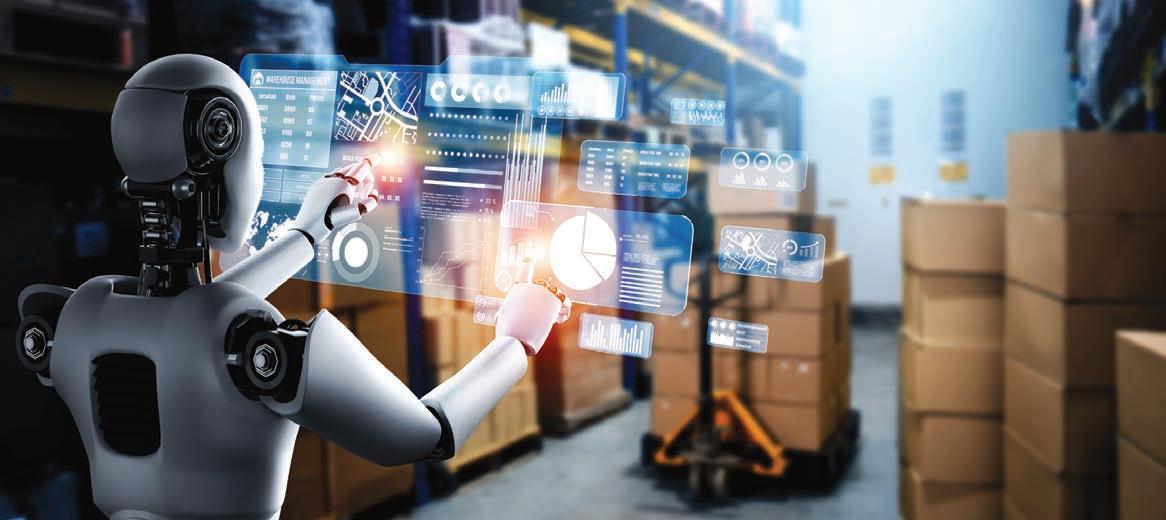
Peter thinks that while AI might lead to the creation of new roles, it’s not necessarily going to reshape the workforce or make the industry more attractive to a younger demographic. Advances in automation and advanced Warehouse Management Systems are already doing this at a rapid pace and it is hard to see AI significantly adding to the pace generated by the current wave of development.
The fundamentals of supply chain remain the same, and so it will attract people with skills and mindsets that have always fit supply chain, Peter says. Changes to the workforce will occur to the degree new workers are required with the technical skills to manage new technology.
“If we have warehouses full of AMRs, the supply chain team now needs engineers and programmers for these AMRs,” he says. “That didn’t
used to exist. They are now part of the supply chain team.”
Reflecting on his own 27 year career, Peter says that – in spite of some promised tech revolutions not panning out – “there have been massive changes I couldn’t have imagined back in the mid-1990s.”
By way of example Peter cites the capabilities of contemporary warehouse management systems (WMS).
“Think about the ability of a WMS to automatically reposition product around your warehouse across the seasonality of your year, getting your WMS preparing space for inbound product that’s still eight weeks away without any human intervention; or interleaving of task allocation by the WMS, leading to reduction in ‘deadrunning’ in the warehouse,” he says. “Advanced WMS will do 95 per cent of these tasks. This is quite amazing, when you reflect on where we were a few decades back.”
Another significant evolution is the integration and convergence of systems. There was a time when connecting two different computer systems was a daunting task. The ability of various systems to seamlessly ‘plug into’ each other has now removed that concern.
“The integration of technology platforms – like an ERP system and a WMS or forecasting system or transport management system – is now as easy as connecting an extension cord,” Peter says. “Well not
quite, but today connectivity is not a systems constraint.”
The capabilities of track and trace technology have also exceeded expectations, with significant advances in the B2C sector. Now, B2B operations are following suit, trying to emulate the B2C approach by providing extensive, real-time tracking information.
“It takes a lot to understand the complexity of the task that goes behind fulfilling an order and getting it to your place on time, seeing how many things had to happen, how many people were involved, and how many exchanges occurred with the product in a journey. And yet, it all happens with 98 or 99 per cent firsttime accuracy – and you have all of that information in your pocket.”
In the end, Peter thinks that it’s those technologies which consistently improve on supply chain fundamentals – rather than trying to revolutionise existing methods – that have the biggest impact.
“As we move forward, it’s these evolutionary advancements, rather than revolutionary disruptions, that will continue over time to bring the constant change.
“As logisticians, until we all have access to a Tardis, we have to work with the ever-evolving tool box we have. AI is now part of that tool kit, but will it become an everyday tool or become that specialist tool used with power, but not very often? Time will tell.” ■
MHD AUGUST 2023 | 25
The impact of AI on supply chain may not be as significant as some optimists – or pessimists – predict.
CONNECTING THE SUPPLY CHAIN DOTS WITH APIs
Product Marketing Manager at project44, Katia Naffa explains to MHD how the supply chain visibility company’s new software Multimodal Rating and Booking APIs, is the connective tissue joining together this
complex network.
Project44 operates the world’s largest end-to-end visibility platform and continues to evolve its software. project44 operates 26 global offices in 17 countries, including the Australia and New Zealand (ANZ) region.
project44 connects to more than 17,000 domestic transport carriers, operating 300,000 assets in the Australasian market and has more than 98 per cent of the ocean tracking carrier market share. The company accomplished all this since entering the ANZ market 18 months ago and serves a range of customers from shippers to 3PLs to carriers, partners, and the end customer.
Among its top customers are brands like Nestlé, Foot Locker, Columbia Sportwear, and CEVA Logistics. These customers partner with project44 across various solutions in domestic tracking, ocean, and air.
As it continues to work on improving supply chain operations for both its customers and other parties in the industry, project44 is expanding its capabilities to include pre-carriage by offering Multimodal Rating and Booking APIs to all regions, including APAC.
CREATING THE SUPPLY CHAIN’S CONNECTIVE TISSUE
Historically, customers’ data may be siloed, processes have been manual, and may use multiple recording systems and applications, which has contributed to unnecessary complexity and confusion. project44 has stepped in to simplify and streamline this process by forming the connective tissue required to link players in the supply chain network. This involves collaboration, visibility,
and automation.
Multimodal Rating and Booking APIs from project44 offer a “one-to-many” API connection, delivering real-time rates and an automated booking process, enabling streamlined rate request and tendering processes, upstream exception management, and access to an expanded visibility-first carrier network.
“For customers who want to manage rating and booking in their system, we can connect directly with their TMS or ERP,” explains Katia Naffa, Product Marketing Manager at project44.
“These APIs allow shippers and 3PLs to request and review rates and book all from a single workflow. Enterprise customers commonly use systems like TMS or ERP to manage these processes. We achieve this through a one-to-many
API connection.”
Shippers or 3PLs use their system of record to request rates via project44’s Rating API. On the back end, the Rating API connects to multiple partners informing them of the request, such as a carrier or broker. The rates are then transmitted back to the TMS, and the customer can review the rates and decide which carrier to move forward with. Bookings are transmitted via the Booking API to the chosen carrier, who can then accept the booking. If the shipper or 3PL is a project44 tracking customer, the booking will automatically transition to tracking.
When customers use rating and booking at the pre-transit phase, the shipment is initialised for tracking upon tender acceptance, unlocking more milestones upstream. All this information is centralised into the platform, giving users the ability to increase tracking percentage and manage any exceptions that might come up when a shipment is in transit.
ACCESSING REAL-TIME MARKET RATES
The Booking API operates the same whether it’s FTL or Ocean bookings. Shippers or 3PLs can transmit bookings or transport orders to their assigned partner (ocean carriers or freight forwarders) for either spot or contracted rates.
“project44 remains neutral and agnostic, and this is all about maintaining and strengthening relationships,” notes Katia.
Use cases are benchmarked against contracted rates versus market rates to ensure contracted rates are competitive.
“Sometimes the biggest challenge
“
” 26 | MHD AUGUST 2023 MHD SUPPLY CHAIN
Our primary goal is giving customers greater control over the pre-shipment process with these APIs so it’s easy for them to set up and standardise the way they manage the rate requests and bookings going forward.
we see is people get trapped in these 12-month contracts,” adds Katia.
“When the market changes, they end up overpaying. We’re giving them the ability to benchmark real-time market rates against their contracted rates so they can make a more informed decision on their loads.
“We find it’s better to use rating, booking, and tracking as one solution and the same with ocean booking, which allows the shipper or 3PL to send the transport or booking order to their assigned carrier, and it will then be sent to freight forwarders or ocean carriers.
EMPOWERING CUSTOMERS OVER PRE-SHIPMENT PROCESSES
Ocean Booking API is available in the APAC region while the other modes such
as FTL and LTL are available in North America and Europe. project44 says these solutions will be made available in the APAC countries like Australia and New Zealand in the future.
project44 is moving into the preshipment phase and remains committed to end-to-end services from pretransit to last mile and sustainability. It’s empowering shippers and capacity providers to find the best carrier or shipment at the best rate and service level in real time.
Eventually, project44 will offer an in-app rating and booking experience for its users, which will help it unify the API, FTL, and LTL systems.
These multimodal offerings are interoperable – or as Katia explains –they act as the pipes connecting the parties, whether they’re the shipper,
partner, or carrier systems.
“We’re uncovering the data throughout the pre-shipment process,” she explains. “Uncovering metrics and insights into the carriers and determining how predictable they are, their punctuality, allows customers to better benchmark against other carriers.
“Our primary goal is giving customers greater control over the pre-shipment process with these APIs so it’s easy for them to set up and standardise the way they manage the rate requests and bookings going forward.” ■
More information of project44’s new multimodal rating and booking APIs can be found at: https://get.project44.com/ multimodal-rating-and-booking-apis/

MHD AUGUST 2023 | 27 MHD SUPPLY CHAIN
project44 Multimodal Rating and Booking API offers a “one-to-many” API connection for mid-market and enterprise shippers and 3PLs.
OPTIMISING TCO IN SUPPLY CHAINS
Utilising efficient drive technology, NORD Drivesystems champions a holistic approach to minimise the Total Cost of Ownership (TCO) in supply chains. Through energy efficiency, version reduction, and condition monitoring, NORD provides a forward-thinking solution to cut costs and improve operational efficiency.
Given the prominence of TCO (Total Cost of Ownership) in the economic lifespan of drive systems, supply chains must go beyond just focusing on the initial investment cost. An impressive 85 percent of TCO stems from downstream processes, including energy, administration, service, maintenance, and more. Reducing these costs demands a keen consideration of the economic aspects tied to the entirety of the lifecycle of the drive systems. NORD Drivesystems offers a unique perspective on this challenge.
Two essential factors in curbing TCO are energy consumption and the number of drive versions used. However, these variables represent conflicting objectives. Optimising a system for energy efficiency leads to diversified drive versions, which, while economically favorable, necessitates management and servicing throughout the lifecycle. On the other hand, reducing the number of drive versions simplifies administration,
service, and warehousing, but at the cost of increased energy expenses. Striking a balance between these competing factors is a crucial part of efficient drive design. Furthermore, NORD Drivesystems recognises the relevance of continuous monitoring and predictive maintenance in the Industry 4.0 landscape. Regular recording of drive and status data can preemptively identify changes and diminish unexpected downtimes. The outcomes include higher system availability, reduced service and material costs, less downtime, and prolonged service life – all contributing to a lower TCO.
NORD’s approach to TCO reduction is holistic, using a suite of optimisation strategies to identify and enhance efficiency potential. This includes the use of modular systems, economical technologies, individual TCO calculations, and intelligent service and maintenance concepts.
A cornerstone of NORD’s approach
are their drive solutions – designed to minimise lifecycle costs. Key examples include the high-efficiency portfolio, featuring patented DuoDrive geared motor, IE5+ synchronous motor, and decentralised frequency inverter NORDAC ON / ON+, and the LogiDrive solution space.
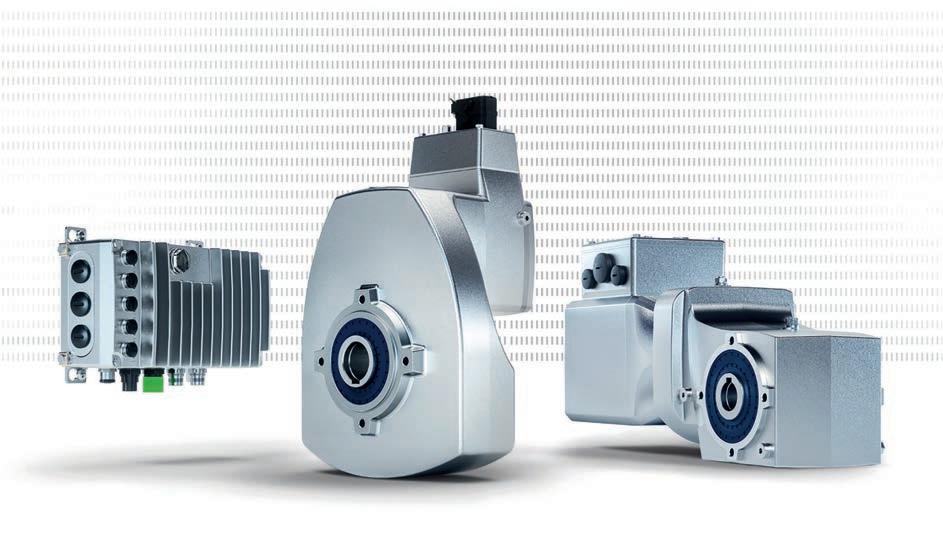
NORD Drivesystems’ approach to lowering TCO encapsulates a deeper understanding of supply chain complexities and the need for comprehensive solutions. By integrating energy efficiency, version reduction, condition monitoring, and a robust portfolio of drive solutions, NORD takes an innovative stance in ensuring operational efficiency and costeffectiveness in supply chains, setting an example for others in the industry to follow. ■
To read NORD’s white paper on TCO, visit www.nord.com/en/solutions/systemsservices/services/white-paper/tco.jsp
28 | MHD AUGUST 2023 MHD WAREHOUSING
NORD’s high efficiency portfolio is a key part of reducing TCO.



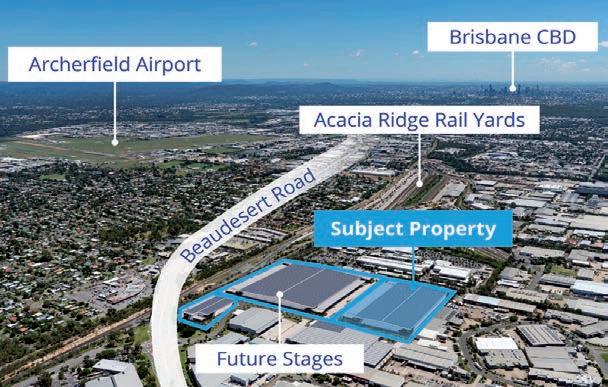








Outlines indicative only 0412 434 738 0408 226 618 Peter Dale Patrick Brush * Approx. colliers.com.au/p-AUS66019159 Clear span high clearance warehouse Building area 5,865m²* 219-225 Woodpark Road, Smithfield, NSW Industrial For Lease High Quality Office / Warehouse For Lease Outlines indicative only 0401 179 036 0417 603 195 Nick Evans Peter Turnbull 0448 517 546 0406 511 441 David Brisk Jack Hardy * Approx. colliers.com.au/p-AUS66020902 Q2-2024 Completion 10,000m²* - 25,783m²* available 30 Fox Road, Acacia Ridge, QLD Industrial For Lease Brand New Industrial Opportunity For Lease 0401 693 450 0455 588 982 Jonathan Mercuri Cameron Stuckey 0425 710 666 0477 888 081 Gordon Code Daniel Kelly * Approx. colliers.com.au/p-AUS66021046 High clearance racked warehouses Building areas: 4,610m²*9,290m²* 3B & 3C 207-219 Browns Rd, Noble Park, VIC Industrial For Lease High Clearance Racked Warehouses with Coolrooms For Lease 0410 807 877 Nick Mallett 0499 888 024 Tom Barnier * Approx. colliers.com.au/p-AUS66020995 Newly refurbished Total building area: 564m²* Unit 20, 198-222 Young Street, Waterloo, NSW Industrial For Lease Outstanding Office, Showroom + Warehouse For Lease Accelerating success.
Industrial Solutions 2023 Start your search
FORKLIFT BOOSTS WOOL BUSINESS
grab, allowing easy transportation of multiple large wool bales.
Gordon says the durability and reliability of Toyota products were big reasons for him developing an exclusive relationship with TMHA, however there were also other factors that played a part.
As a wool broker, he spends significant amounts of time in large wool stores, where Toyota forklifts can be found in abundance.
“I really like the build quality and reliability; they are just a better machine to use,” he says.
Gordon Litchfield Wool, based in both Cooma and Yass, provides wool brokering services to sheep farmers both large and small, and uses a fleet of eight Toyota forklifts to transport and store wool bales, sourced from distributor Toyota Material Handling Australia (TMHA).
The company has used Toyota forklifts for the majority of its existence, first purchasing a 6-Series forklift back in the 1990s and since adding 7- and 8-Series as the business grew.
Owner Gordon Litchfield says his relationship with Toyota forklifts started early in the business’s life and has only become stronger as time goes by.
“Very early we bought our first Toyota when we moved to our current store in Cooma; we needed extra forks, so we bought a new Toyota fork,” Gordon says.
“After using it we sold our other one straight away and bought a used
Toyota fork. We had one or two in the first few years, but we cottoned on to Toyota very early in the piece.”
A testament to the build quality of Toyota forklift products, the first 6-Series forklift purchased by Gordon Litchfield Wool is still being used by the company almost 30 years later.
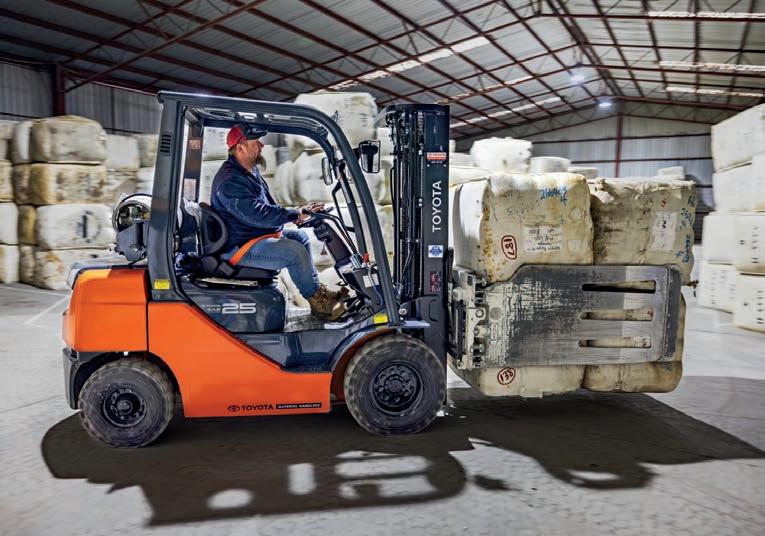
Gordon says that despite buying a new Toyota forklift every few years, if the current fleet is still performing to standards then he doesn’t see the need to replace them.
“We’ve still got one of the originals – I think it was actually the first one we ever bought,” he says. “It has been such a great fork; we’ve got it here as a backup.
“It’s been a magnificent machine; I think we put a new head gasket on it a few years ago and just said, ‘Let’s keep it’.”
Gordon Litchfield Wool recently took delivery of a new 32-8FG25 LPG forklift, which like all other forks on his fleet has been fitted with a wool
“And I did my homework elsewhere – they were very popular at other wool stores. I looked at the big wool stores in Sydney, the bigger brokers at the time and what they were doing, I just noticed that the Toyotas seemed to be very commonplace, and I’m a fair fan of the quality of Toyota, having come from the bush.”
The volatility and inconsistency of the wool industry means a huge amount of wool may need to be moved at any given time, meaning the reliability of the forklifts is paramount to a wool business’s success.
“I don’t find them overly complicated,” Gordon says. “They’re well-made and I’ve never had any major problems, they’re easy to work on for servicing, things like that. And we’ve never had any major reliability problems.”
Having bought Toyota models over the course of nearly 30 years, Gordon has also seen the evolution of Toyota safety technologies that ensure the best possible protection for occupants.
Strong safety credentials are important to the company, and Gordon has been pleased with the Toyota System of Active Stability (SAS) safety system.
30 | MHD AUGUST 2023 MHD MATERIALS HANDLING
A rural New South Wales-based wool broker has used the legendary reliability and durability of Toyota forklifts to grow its business over the course of nearly 30 years.
Gordon Litchfield Wool has used Toyota forklifts for most of its existence.
“I’ve always been impressed that as each model has improved, the safety requirements have really kept up to date really well,” he says.
With such strong brand loyalty, Gordon Litchfield Wool has developed a prosperous relationship with the local TMHA branch led by Area Sales Manager Mark Elvins.
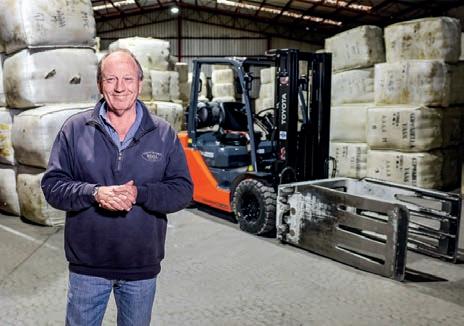
“I don’t shop around, simple as that,” Gordon says. “I just ring Mark and say, ‘I need another forklift’, to put it bluntly.
“Mark understands our business very well. And regularly drops in when he’s in the area, keeps me up to date when there’s a good deal on. He’s my forklift man and that’s it.”
Gordon says he has spoken highly of Mark to other local businesses in the area, thanks to both the service
provided and the performance of the products.
“I’ve recommended Mark and his group to several others in the area,” he says. “He keeps me up to date with things, drops in regularly, he’s a hell of a nice bloke.
“It’s a side of our business that isn’t complicated. We can be really busy at times; our business is seasonal, and we have to move a lot of wool at times, and that’s one thing we don’t have problems with.”
Gordon and his wife Kate started Gordon Litchfield Wool in a small shed in 1995 and has since grown to employ 15 people across its two facilities in Cooma and Yass.
The company can assist and advise clients from classing their wool in the shearing shed, to testing
and cataloguing for sale at auction to all markets internationally.
Gordon has also championed the wool industry over the years, working with Australian Wool Innovation to help promote local wool growers and their products. ■
NEW CAIRNS TMHA BRANCH
racking for parts and pre-delivery storage, a freight dispatch bay, machine storage areas and a generous office space including a board room that can be used for training.
TMHA branch manager Mitchell Ryan says the addition of the new Cairns branch would help the brand establish its footprint in Far North Queensland, helping it to better service customers.
Toyota Material Handling
Australia (TMHA) is excited to strengthen its footprint in Far North Queensland with the addition of a brand-new branch to service its valued customers in Cairns and its surrounding regions.
The new facility sits on roughly 1000m2 of land in Woree, consisting of a 430m2 workshop and 260m2 office.
TMHA previously had a presence in Cairns with a storage facility that supported up to three service technicians and a salesperson, however the growth of the brand in the area
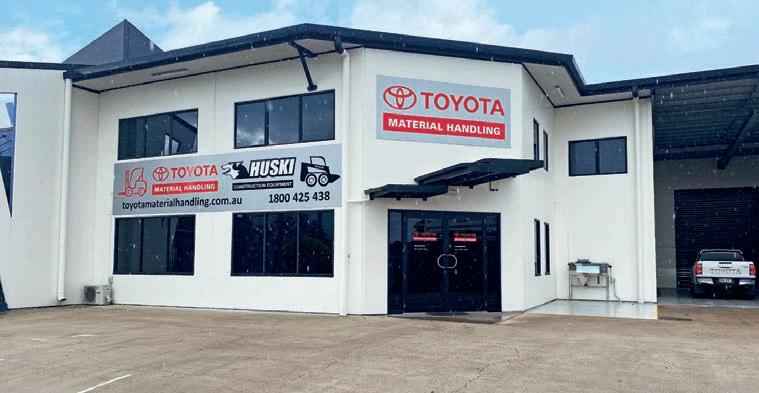
has prompted the need for an upgrade to a more comprehensively fitted-out facility.
The new facility is also designed to support further growth in the FNQ region for TMHA’s range of Toyota forklifts, Huski Construction Equipment, and other allied products.
The new regional branch features a fully functional workshop capable of handling both pre-delivery and general service work, a large wash down bay, fabrication bay and two general workshop bays.
Furthermore, it also includes pallet
“We are thrilled to be adding a new dedicated regional branch in Cairns, which will help improve the service we offer our valued customers while increasing our base in the area,” Mitchell says.
“The ability to effectively and efficiently support our product from within the specific region is a very exciting opportunity for us.
“Furthermore, this larger facility provides us with room to grow the business and bring on more customers, which we will certainly be looking to do.”
For existing Cairns-based customers, the new branch will allow for increased parts and service capabilities, with sales teams also able to house greater levels of stock in the region. ■
MHD AUGUST 2023 | 31 MHD MATERIALS HANDLING
Owner Gordon Litchfield.
The new Cairns branch helps TMHA better service its FNQ customers.



Healthcare Logistics healthcaresales@tollgroup.com www.tollgroup.com/solutions/industries/government-defence/healthcare-logistics We move the businesses that move the world. With our supply chain expertise, network support and technological backing, we deliver integrated logistics solutions for the healthcare sector.
THE TIME IS NOW
On the heels of Körber’s 2023 Shipping and Returns Survey, Nikki Jones unpacks some
In the digitally driven era of immediacy and convenience, supply chains have evolved far beyond their traditional function of simple product conveyance. They now serve as the central nervous system of the customer experience, intricately weaving together numerous elements to meet and exceed consumer expectations.
These elevated expectations, while heralding significant opportunities for companies, also present sizable challenges. To deliver on their promise, businesses must grapple with managing larger inventories, deploying complex systems to handle burgeoning order volumes, and accommodating a wide array of fulfilment options – all under the strain of mounting pressures on warehouses, shipping facilities, and human resources.
To delve deeper into this critical issue, Körber and Roland Berger conducted a comprehensive survey in late 2021. Featuring responses from more than 200 companies across Asia Pacific, North America and Europe, the Körber 2022 Supply Chain Benchmarking Survey sought to identify best practices amid the intensifying complexities of the industry. The survey revealed a glaring disconnect: while 92 per cent of respondents acknowledged the pivotal role supply chain performance plays in customer satisfaction, less than a third were able to rank as leaders in end-customer experience. This data served as a stark reminder that, while the connection between supply chains and customer satisfaction is understood, the ability to deliver optimal customer experiences still eludes many.
Keen to unpack the finer points of consumer post-purchase expectations, Körber turned its analytical gaze towards the customer-end of the spectrum. The company launched the 2023 State of Shipping and Returns
survey, collecting responses from more than 2200 consumers spread across eight global regions. The study aimed to shed light on the nuanced landscape of consumers’ expectations from the moment they click “buy” until the product is in their hands, and how companies should navigate any unexpected challenges along the way.
The results of the 2023 Shipping and Returns Survey offer an updated and in-depth understanding of end consumers’ views on various facets of the post-purchase experience –from shipping delays and returns management to packaging concerns. It serves as a key piece of evidence that in today’s high-stakes, customercentric marketplace, effective supply chain management is not merely a business necessity – it is a strategic differentiator.
“The survey reveals that 70 per cent of consumers have experienced a delayed online order in the last six months, affecting their overall view of
the brand,” says Nikki Jones, Marketing Director at Körber Business Area Supply Chain, underscoring the considerable impact that shipping delays can have on customer sentiment.

To combat this industry-wide challenge, Körber is leveraging the power of technology, helping its customers operate their supply chains at maximum efficiency to meet and exceed consumer expectations.
According to Nikki, the company recognises that in the current marketplace, “supply chains play a central role in creating a great customer experience and driving customer loyalty.”
Navigating the often-tumultuous waters of supply chain management necessitates the use of advanced systems such as Warehouse Management Systems (WMS) and orchestrating systems such as Körber’s Unified Control System (UCS). Nikki explains, “WMS and UCS are key to improving order accuracy and speed.”

MHD AUGUST 2023 | 33 MHD SUPPLY CHAIN
of the findings, as well as what properly integrated supply chain software can do to address challenges and realise opportunities.
Körber launched the 2023 State of Shipping and Returns survey, collecting responses from more than 2200 consumers spread across eight global regions.
Beyond efficiency and precision, these systems also furnish invaluable analytics that can help track and enhance the operational impact on customer experience.
Nikki elaborates on the benefits of centralised order management systems – particularly for companies operating across multiple sites. These solutions, she argues, have a direct and profound impact on customer satisfaction, and industry leaders are capitalising on them. “Leading businesses are ahead in implementing these solutions to promote repeat purchases and build brand loyalty,” Nikki observes.
Nikki points out that while many companies have turned to supply chain software to bolster essential functions such as warehousing and transportation, these systems often operate in silos. The lack of integration prevents complete process automation – a significant roadblock in the quest for efficiency and optimisation. “The e-com age requires holistic visibility and optimisation by looking beyond the traditional levers of supply chain optimisation,” she says.
Learning from the early adopters of omnichannel fulfilment, particularly those in the e-commerce and food and beverage sectors, Körber has uncovered the immense potential that lies in the interconnected layers of network collaboration. Nikki emphasises the transformative role software and automation technologies play in this context, propelling the supply chain to a new level of integration and insight. “The technology-enabled supply chain brings a new level of integration and insight that only digital enablement and automated processes can achieve,” she notes.
GREAT EXPECTATIONS
The heightened expectations of
today’s consumers cast a spotlight on the need for both shipping visibility and accountability in supply chain management. As Nikki says: “We are all consumers at the end of the day, and our expectations continue to expand.”
“We not only expect flexibility in how and where we shop, but also faster deliveries, tracking notifications, as well as greater choice to decide where an order will be delivered,” she points out.
The path to meeting these increasing expectations isn’t linear, but rather requires a seamless integration of different elements of the supply chain.
At the core of these expectations is the requirement for visibility, which Nikki identifies as being now firmly rooted at the centre of accountability and customer communication. From a retailer’s perspective, it is paramount to provide customers with a transparent, timely overview of their order’s journey.
BOOSTING SUSTAINABLE SUPPLY CHAINS
As the tides of the corporate world continue to shift, sustainability has emerged as a significant driving force behind business success. The move towards greener practices extends well beyond the company walls, reaching deep into the arteries of supply chains.
“The growing pressure on companies to take action on sustainability means their supply chains are expected to be greener too.”
As large corporations publicly commit to more eco-friendly practices, their suppliers are held to these new standards as well, reinforcing the notion that sustainability is a collective effort. “As larger companies make public promises to become more ecofriendly, they hold their suppliers to the same standards,” Nikki explains.
In line with this, Körber is playing a key role in adding sustainable value throughout the supply chain. Nikki elucidates that there are ample opportunities for implementing sustainable practices, “be it reduced energy resources, paperless processes, or optimised warehouse or transportation routes to reduce carbon emissions.”
Technology, she adds, serves as a powerful ally in these sustainability efforts, supporting companies not only in minimising their
environmental impact but also in broader Environmental, Social, and Governance (ESG) initiatives, such as enhancing worker safety and engagement. “Technology can support companies in all aspects of sustainability and corporate ethics,” she says.

ONLY AS STRONG AS THE WEAKEST LINK
As the tides of commerce continue to turn towards digital channels, the importance of delivering a seamless customer experience becomes ever more crucial. E-commerce is projected to account for a staggering 95 per cent of total sales worldwide by 2040, transforming supply chains into the lifeblood of commercial success. But any “supply chain is only as strong as its weakest link,” Nikki says.
In this new world order, technology holds the key to delivering the fast, efficient, and flexible services that customers demand, including features like same-day or next-day deliveries. As technology resources become increasingly intertwined, seamless integration and communication stand out as critical factors in the success of warehouse operations.
“Standardised integration platforms or integration tools turnkey to enable holistic supply chain information sharing to stay agile, efficient, and competitive,” Nikki says.
This idea underscores Körber’s commitment to helping its clients harness technology to navigate the complexities of modern supply chains, ensuring that every link in the chain is robust and prepared for the demands of the future.
While the challenges of modern supply chains are undeniable, with partners like Körber, companies can turn these complexities into competitive advantages. The time to invest in a smarter, more integrated supply chain is now.
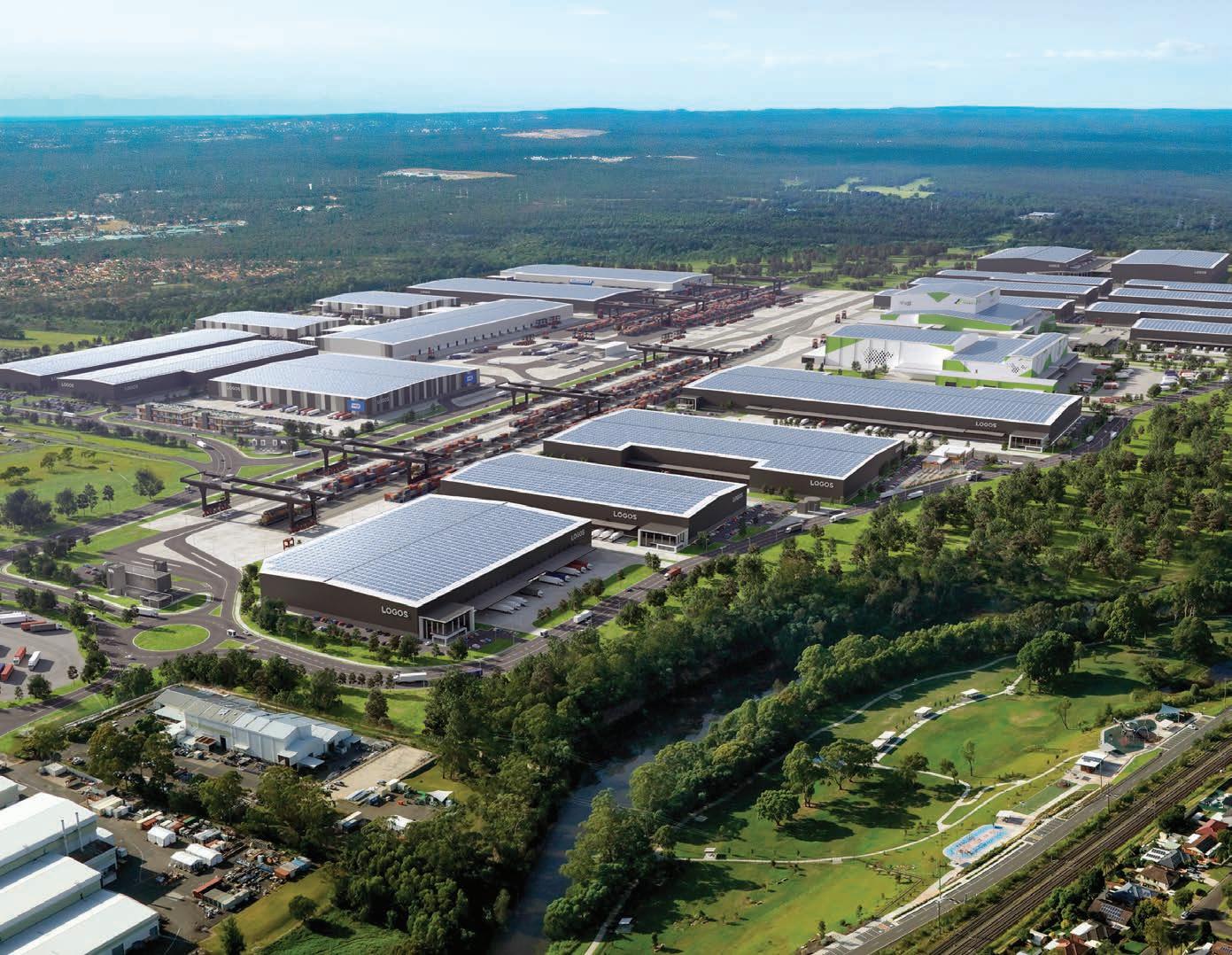
“It’s not yet too late to invest into the smart supply chain, but time is running out.” ■

34 | MHD AUGUST 2023 MHD SUPPLY CHAIN
the full Körber’s
Download
2023 Shipping and Returns Survey.
Nikki Jones, Marketing Director at Körber.



+ 243 ha + 1,550,000 TEU + 850,000 sqm + 60 MW Prime Logistics and Intermodal Precinct A year across the IMEX and Interstate Terminals Onsite large format warehousing Of rooftop solar across the estate Trevor Lee 0404 829 067 Danielle Eloss 0405 996 623 For more MIP leasing information call our team, or alternatively visit our website moorebank.au Now Leasing 20,000 – 100,000 sqm The Future of Australian Logistics
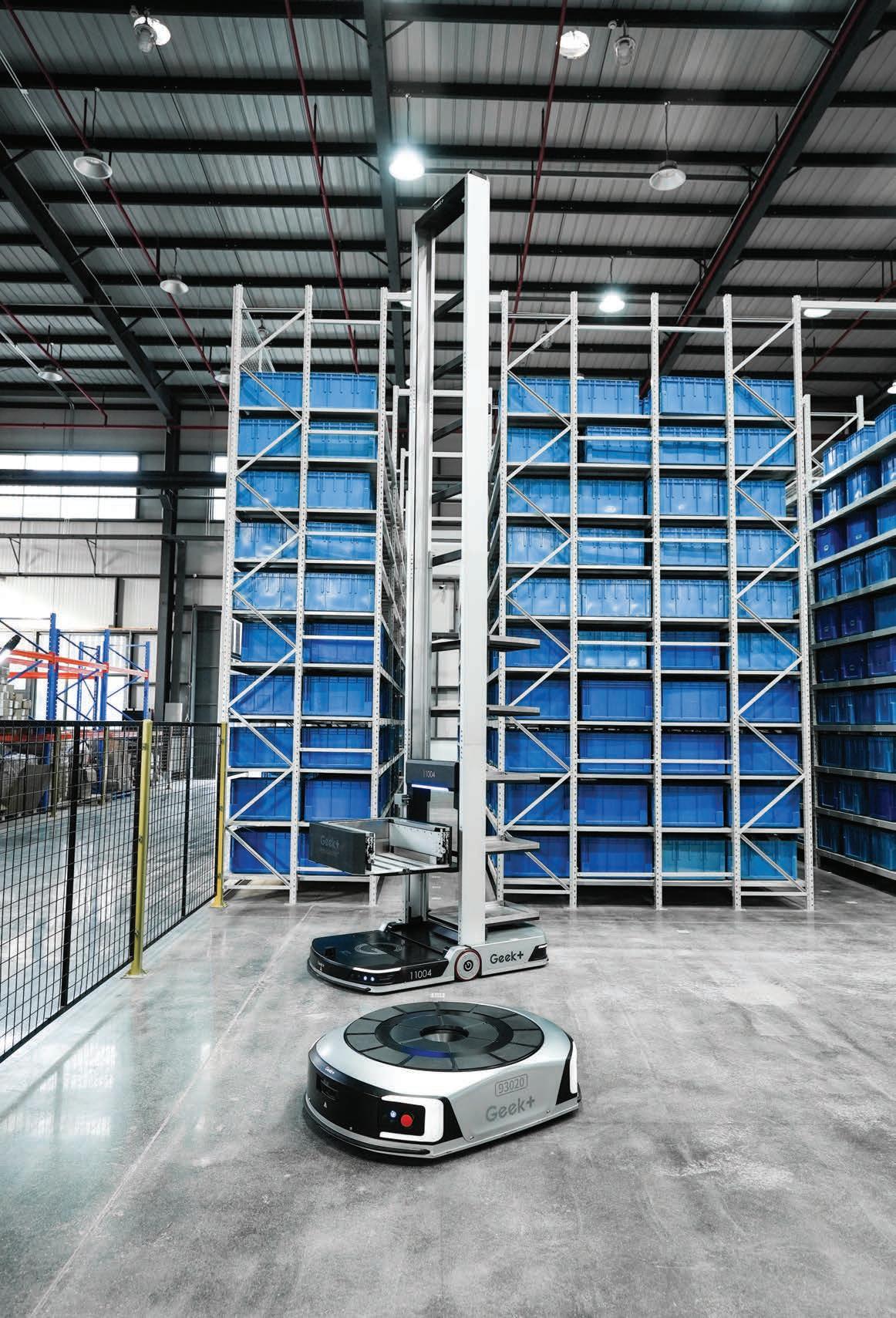
Flexible Automation Solutions www.conveyorlogistics.com.au sales@conveyorlogistics.com.au
TALKING TECHNOLOGY
workforce, who are used to and seek out more complex systems to pique their interest in their daily work. Hai Robotics solutions appeal to a younger workforce, who find an attraction to working with modern technologies, and autonomous robotics fit well within that category. Additional to this, the efficiencies that our customers gain through improved throughput with lower headcount reduce the workforce stress related to availability of resourcing.
What drew you to work for Hai Robotics?
I have worked in the supply chain industry for more than 20 years, primarily working with customers to find solutions to improve their business using technology. Having implemented a variety of technologies from simple RF Scanning, to Voice Picking through to complex AMR solutions, I was attracted to Hai’s innovations in the Case Handling Robots (ACR) space. What appealed to me in particular, was Hai’s focus on being the best at ACR Solutions with a laser focus on this specific technologyand how it can be applied to many industries. Hai’s commitment to using robotics in supply chain to empower and move forward the progress of humanity appealed to me with my passion for technology and working at the forefront of innovation, all in the service of trying to make our customers’ businesses better.
Can you describe your role at Hai?
I joined Hai as Solutions Director in 2022, then in early 2023 I was given the opportunity to lead the team in ANZ. In my current role as General Manager ANZ, I am responsible for the day-to-day operations from solutions, sales, project delivery and finally ongoing support. However, my focus still is in the solutions space, leading the team as we develop innovative solutions to meet the variety of projects where ACR provide benefits to our customers.
Why is Hai Robotics a good fit for the Australia and New Zealand market?
We have seen coming out of the COVID years that there is a shift of mindset in the workforce in Australia. Businesses are no longer able to easily retain skilled staff and generate interest in supply chain roles for the emerging workforce. Employees are no longer a commodity. However, technologybased solutions appeal to a younger
Availability and the increasing cost of real-estate is another growing business concern that we can overcome with ACR technology. With high density capacity, and flexibility to scale with ease, ACR is ideal for customers looking to achieve a higher throughput in a limited space with a medium cost capital solution. We see customers now using ACR as a temporary solution to cater for business growth, without the need for significant investment in greenfield sites and the operational impacts that come with site relocations. Then when a customer is ready for a new site, we can very quickly, with limited business impact, move and expand the solution and resume operations.
Can you talk to some of the market feedback for the Hai proposition so far in Australia?
We have received positive feedback from many customers in many market segments, with a number of projects now underway in Australia and New Zealand. Customers and Integrators have very quickly recognised that the cost, flexibility, and scalability of the Hai ACR
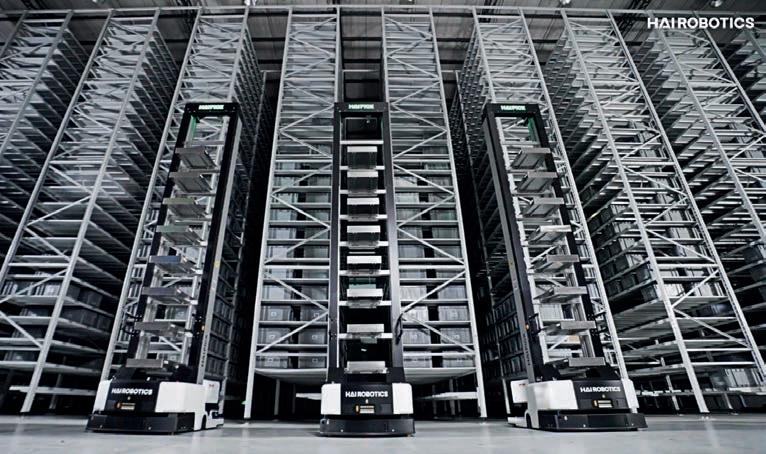
MHD AUGUST 2023 | 37 MHD SUPPLY CHAIN
MHD Supply Chain Solutions sits down with Paul Phillips, General Manager ANZ at Hai Robotics, to discuss the changing needs of the younger workforce, the vast appeal of cost-effective automation solutions in Australia, and his motivation behind joining Hai Robotics as General Manager this year.
Hai Robotics’ ACR solution is ideal for customers looking to achieve a higher throughput in a limited space with a medium cost capital solution.
solution has vast appeal to ANZ supply chain industry. We have projects underway across B2B/B2C consumer goods, Grocery and General Merchandise, Automotive Spare Parts, and Micro-Fulfilment Solutions in retail. Our time to market for delivery of solutions inside of six months is a big appeal to customers looking to make meaningful change, without the long lead-times for more complex fixed-in-place robotic solutions.
Can you discuss any recent success stories in the Australian market?
Harvey Norman Commercial is the first customer in Australia to implement our flagship A42G ACR Robot with our HaiPORT solution, which allows us to handle up to 600 totes per hour to the picking workstations. Implemented by BPS Global Australia at Harvey Norman Commercial’s new facility in Casula in NSW, the operation is seeing significant improvements to their operations. We are currently implementing our first site in Australia with our recently announced combined solution, which encompasses Hai’s flagship HaiPick ACR along with the HaiFlex AMR solution for larger items. This solution will allow our customer to pick items from the totes that have a maximum capacity of 50kg, along with large bulky items which can be up to 1 – 1.5m in length. These can

all be picked at the same workstation, allowing orders with items of variable size to be picked and consolidated together, reducing the cost to serve.
What sectors is the Hai solution best suited to?
We see that ACR can be applied to most industries with our primary focus on e-commerce, apparel, small electrical/automotive, and pharmaceutical. With Australian supply chain having a large focus on “less than case picking”, we see opportunities to apply the Hai solutions across most market segments in supply chain. Hai has very strong partnerships with many 3PLs who have recognised the benefits that the Hai solution can bring to multi-tenant operations.
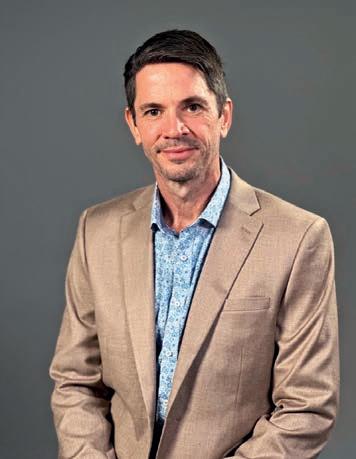
What kind of commitment does Hai demonstrate to R&D and innovation? With more than 1600 staff across 20 offices globally we are an engineering focussed organisation. Over 50 per cent of Hai staff are engineers who collectively have worked with Hai to lodge more than 1500 patents globally. As the pioneer of ACR Solutions, Hai continues to lead the field in Autonomous Case Handling robots. More than 1000 projects have launched since Hai Robotics was launched in 2016, where we invented what
are now commonly known as ACR solutions.
What new developments is Hai set to launch in the Australia market?
At CeMAT in July at the Sydney’s Olympic Park “The Dome”, we demonstrated our newly launched A42TD ACR Robot, which is capable of tote storage to 10 metres, utilising a double deep solution, which allows for increased tote storage density with no impact to operational performance. Along with the A42TD, we will be showcasing our HaiFlex AMR robots simultaneously handling both tote and pallet picking functions. The CeMAT solution will then find a permanent home at our new offices in Gladesville where we will be hosting in-person demonstrations for our customers and partners.
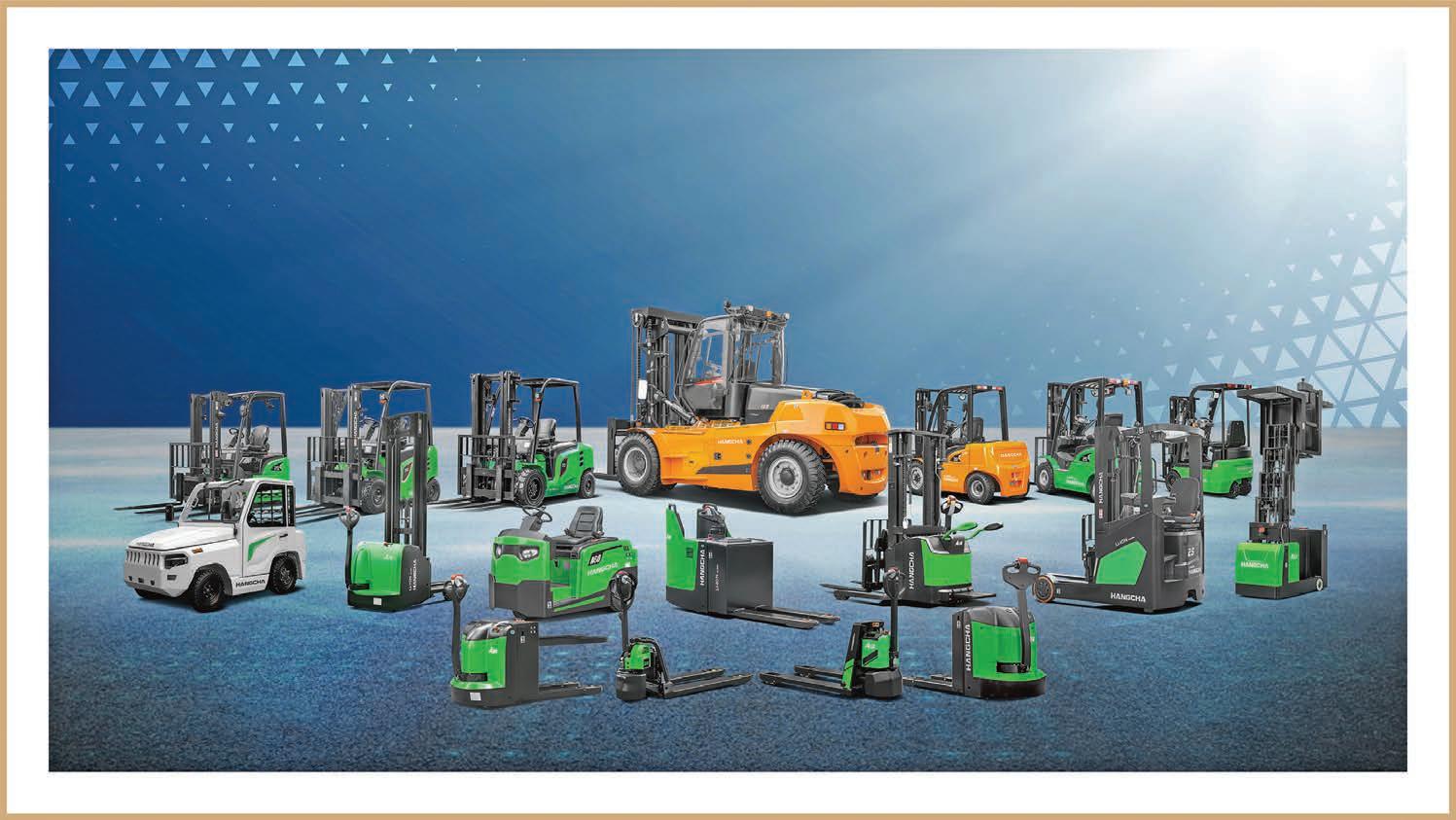
In terms of competition with other robotics providers, what’s Hai’s point of difference and why would you recommend a customer choose Hai over other providers?
Hai has a primary focus on tote and case solutions that work with adjacent solutions like AMR. Our focus is on picking solutions that take advantage of the space available that we see in warehouses today. We do not lose focus on designing material handling solutions that sit outside of this focus. As the inventor and largest supplier of ACR solutions globally, we are many times more technologically advanced than any other ACR/AMR provider in the market. ■
38 | MHD AUGUST 2023 MHD SUPPLY CHAIN
Paul Phillips – GM at Hai Robotics ANZ.
Harvey Norman Commercial is the first customer in Australia to implement Hai’s flagship A42G ACR Robot with its HAIPORT solution, which allows it to handle up to 600 totes per hour to the picking workstations.
NEW ARRIVAL: LITHIUM 0.2T A SERIES STORAGE ASSIST VEHICLE
We are happy to announce the launch of our new 0.2t A series lithium storage assist vehicle. This is a compact and flexible vehicle that is perfect for picking small goods in warehouses, hardware stores, supermarkets etc. The unit has a 100kg hydraulic powered picking table, and also 115kg capacity lower storage tray.

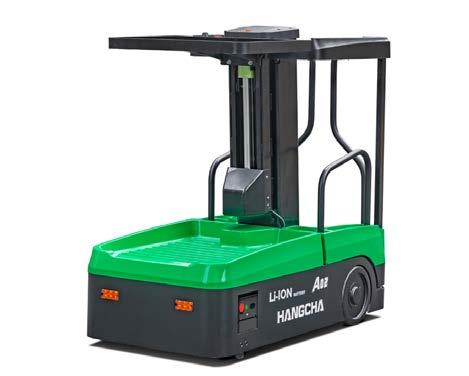
The 24v/125ah lithium has fast and opportunity charging which greatly improves working efficiency.
Safe & Reliable
Even at great heights, the operator feels confident thanks to the all-around safety protection, such as automatic closing doors, right and left hand sensing, front and rear flashing lights, tilt switch sensor etc. All these will help ensure operators are in the correct position as they operate the equipment, resulting in fewer injury risks and less potential downtime.
Easy Maintenance
The AC motor significantly reduces the maintenance costs and downtime. Maintenance free lithium batteries reduce downtime and provide greater life span than traditional wet cell or gel batteries.
With over 200 units in stock and a new spare parts division our dealer network can support all your needs.
Hangcha Forklifts Australia has been set up to support our national dealer network. Call 1300 399 687 to be put through to your nearest local dealer.
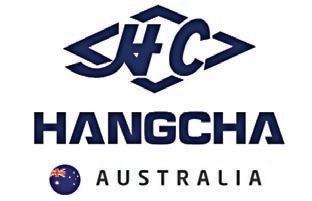

sales@hcforkliftau.com
www.hcforkliftaustralia.com
Manufacturing forklifts since 1956
HANGCHA IS RANKED AS THE 8TH LARGEST FORKLIFT COMPANY GLOBALLY
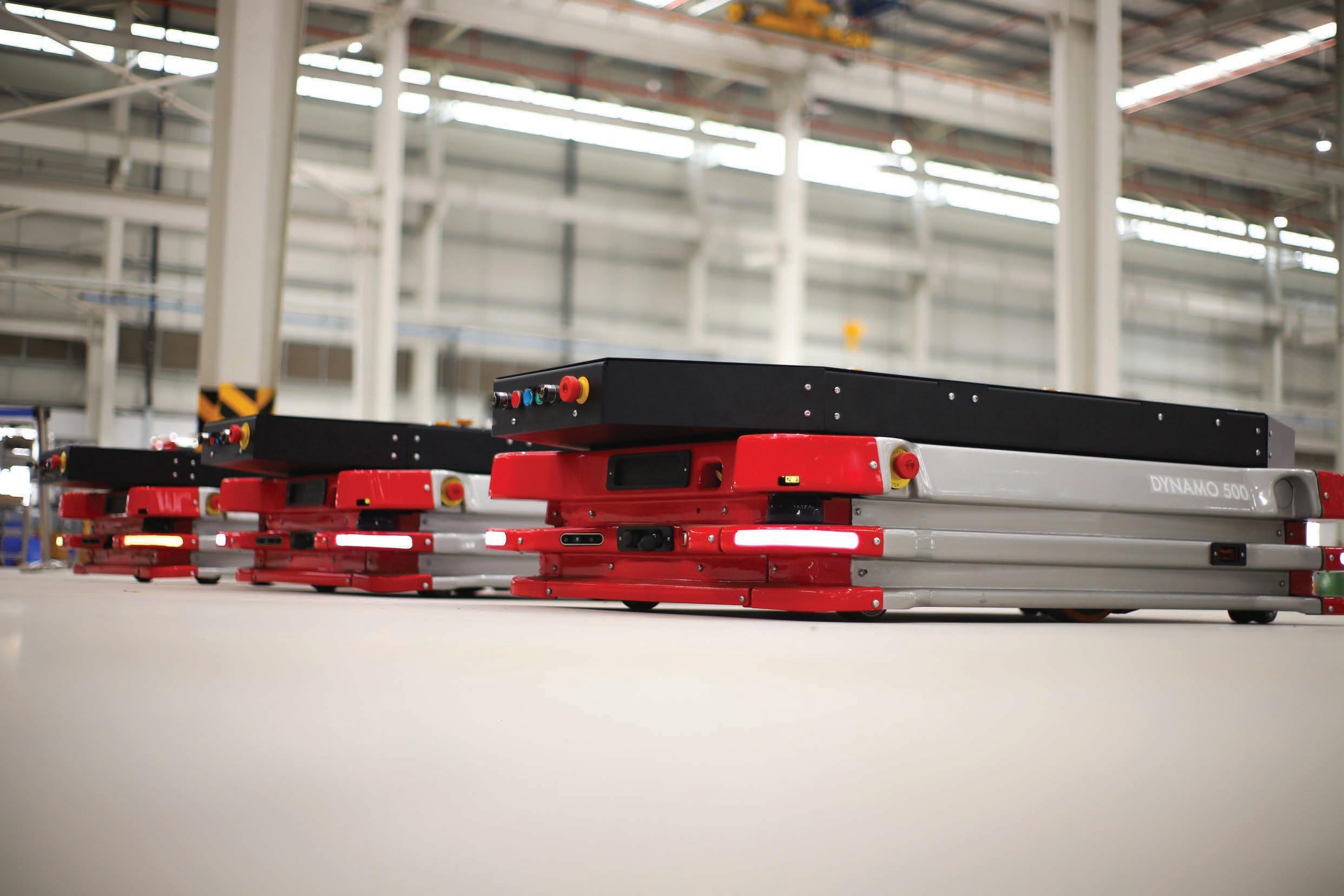
AUTOMATION SOLUTIONS THAT DELIVER VALUE automate@addverb.com addverb.com
DIGITISING WAREHOUSES WITH CONFIGURABLE SOLUTIONS
Tompkins Robotics has developed a configurable software solution that can be easily integrated with Warehouse Management System applications and hardwarebased products. MHD sat down with Rick Kaminska and Matt Toburen from the robotics company, who explained how this sophisticated piece of technology can conveniently be fitted into and optimise a warehouse’s operations.
A WMS is usually at the top of the system stack of various applications in a warehouse or distribution centre. Below the WMS is an execution system layer, which is where tWES sits. Below the execution system are automation
“We receive SKU and customer order data, product information and characteristics – whatever we need to sort individual products out to either customer orders, or SKUs in the case of a returns solution,” explains Rick Kaminska, EVP at Tompkins Robotics.

“Software integrations are important for automation success because the systems need to be able to communicate with one another seamlessly,” explains Matt.


“If they can’t do this, it results in misalignment, which much of the industry has experienced as they continue to put in more automation. Stressful and risky go-lives can be a
thing of the past with solid software platforms and well thought out interconnectivity between these various systems.”
“We now have to integrate with so many third-party systems, including picking arms, goods-to- person systems, and more with our own solutions that we’ve built up a centre of excellence just for integrations,” says Matt.
“It all comes from the requirement of connecting and moving the data to the right subsystem at the right time to maximise the impact of using automation. Whether it’s our own hardware solution or integrating with other vendors’ systems, the automation footprint continues to expand and drive software complexity higher.”
“That’s exactly where Connext was born from,” says Rick. “We saw the need in the market to have a standalone integration platform that
MHD AUGUST 2023 | 41 MHD WAREHOUSING
Rick Kaminska, Executive VP of Software Product Management
Matt Toburen, Product Management Leader at Tompkins Robotics.
could help our customers integrate, with anything, and we combined it with our years of experience to make robotics automation easier.”
SIMPLIFYING AUTOMATION WITH TOMPKIN’S SOLUTION SETS
tSort does single unit sortation by putting product on a robot and establishing where it needs to go based on customer requirements.
“This is where tWES can transform the same hardware footprint and make it work for various warehouse types”, explains Matt.
“The tWES software is configurable and extendible to enable various sorting solutions that we refer to as ‘Solution Sets’, such as central fill pharmacy, store replenishment, e-commerce, and discrete picking operations, returns logistics, and tSort can also be used as a shipping and parcel sortation system. The variance that Tompkins can deliver to the market is all because of the software platform it has created.”
“You see these robots flying around these tables and it’s like magic,” notes Matt. “There’s a lot of intelligence behind the scenes that you just can’t see by looking at the hardware alone – this is the special sauce that a lot of these execution platforms have versus a WMS, which is controlling a business’s inventory and upstream processes.”
“This secret sauce,” Matt adds, “is truly being able to create these five to 10 industry solution sets for varying customers with software and all using
the same cost-effective hardware. tWES is the configurable brains that create these solutions and Connext is the expressway allowing data to go where it needs to.”
The value provided to this market is related to the solution sets Tompkins has to offer. Store replenishment, e-commerce order consolidation, picking, shipping sortation, and returns processing represent areas of the industry that still need more automation.
By combining the hardware, configuring the software, and integrating with existing systems, customers can create the ideal solution for their operations.
“A business may have a small set of SKUs or products that they sell, in which case a lot of customer orders will see the same products being ordered, or it may be a large retailer with general merchandise, and they have hundreds of thousands of SKUs,” adds Rick.
“There’s a broad variety of different products that you’re sorting from one day to the next, and a lot of variability comes with that and brings a different set of requirements. This is why adaptability in software is crucial to success.”
EXPANDING AUTOMATION’S FOOTPRINT
As the industry evolves, the technology in it also evolves. Robotics has entered this space in the past five to ten years and made some drastic changes.
Tompkins is getting involved in not only sortation robotics with tSort,
but also complementary robotics innovations, such as automating the feeding and takeaway of product to and from tSort. In addition to having a leading single unit sortation solution, Tompkins is also launching additional robotics solutions in 2023 and beyond.
“We’re automating the takeaway of completed orders from tSort with our xChange solution,” explains Rick. “We also integrate with pick and place robots to induct products to tSort.“And there are other automated packaging solutions that will be fed from a tSort unit sort solution, and then the bagged order can be inducted to another tSort for parcel sortation. are becoming available such as automated bagging machines. Every step of the workflow is becoming automated in one way or another.”
Tompkins connects and communicates with a variety of technologies with its Connext platform and while tSort is fed items to sort, tWES orchestrates the entire process.
“Where tSort’s software may have received product induction from humans in the past, we’re now getting inputs from other robots,” notes Rick.
“We need our platform to communicate with those other robotic technologies to exchange that vital information to allow that process to flow smoothly.”
tSort started as a sortation solution but now it along with Connext integration platform enables Tompkins to expand its automation footprint both upstream and downstream from its core sortation offering.
Matt concludes: “We are now able to look at automation across a much wider footprint for our customers’ warehouses by combining the additional innovations coming from our robotics team and our tWES and Connext software platforms.” ■
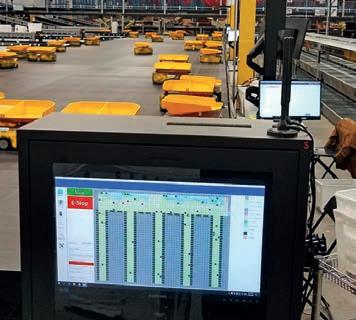
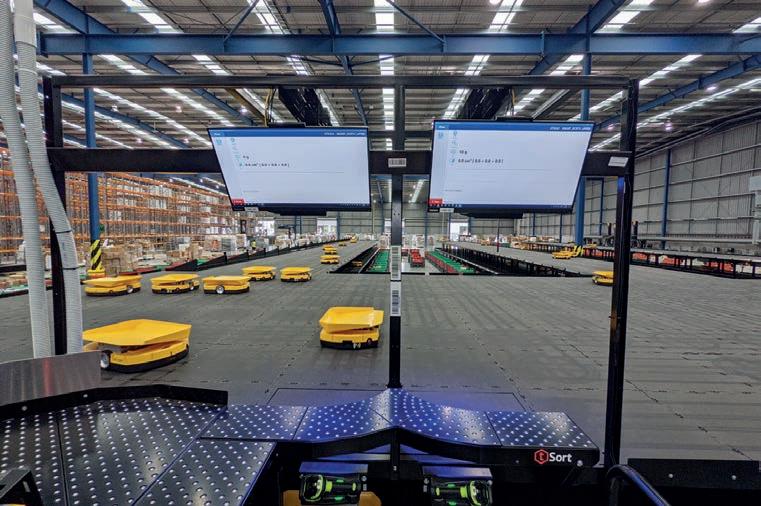
42 | MHD AUGUST 2023 MHD WAREHOUSING
Tompkins connects and communicates with a variety of technologies with its Connext platform.
tSort does single unit sortation by putting product on a robot and establishing where it needs to go based on customer requirements.
Benefits to
One
Fund
Enjoy
Pay less in the beginning and pay more near the end of the term, pay more during peak season or delay payments to meet potential budgeting constraints.
Improve
Utilise external funding to drive significant improvements in ROI and recognise an immediate positive cash flow impact.

Obtain
Easily add new equipment under the master lease agreement by simply adding a new lease schedule. Pre-approved funding facilities available with no undrawn line fees to improve speed.
Conserve
Simplify
DLL – Your finance partner on your journey to automation This document is provided for general information only. You should seek independent legal, financial and tax advice that takes into account your individual circumstances. While every effort has been made to verify the accuracy of the information contained in this document as at the date of publication, to the extent permitted by law, DLL disclaims all liability arising from any reliance on this document. 7/23 Contact us! Reach out to Steven Davey to see how DLL can help you on your journey to automation. T +61 413 892 725 E steven.davey@dllgroup.com www.dllgroup.com
Simple Payment Solution
monthly
the cost of the project with one simple
payment, including equipment and soft costs like engineering fees, installation and software. Milestone and supplier payments included.
Payment Flexibility
&
Payback Time
ROI
Reduce
Operational Flexibility
Business Capital
with a specialist equipment finance lender, you can
cash
credit lines intact for important business initiatives —
headcount
improvements.
By engaging
keep your
and
expansion,
and
Equipment Upgrades
replace it with newer, more efficient models,
with one manageable monthly payment. End of contract asset management
seamless
Return used equipment and
while continuing
support available to ensure
transition.
your
automation finance specialists
organisation of partnering with supply chain and
DELIVERING NEXT GEN ROBOTS
Richmond Rolling Solutions announces exclusive distribution deal with ForwardX Robotics company.
Richmond Rolling Solutions is partnering with ForwardX Robotics, a global leading person-to-goods Autonomous Mobile Robot (AMR) solutions provider, to distribute its next generation products across Australia and New Zealand.
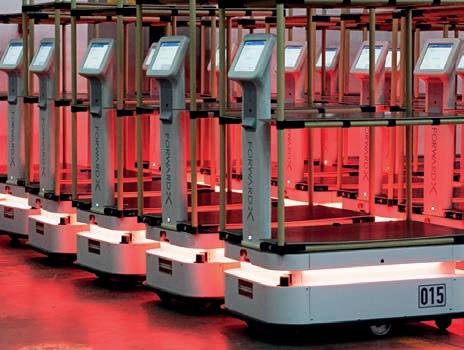

ForwardX Robotics, a global leader in vision-based AMR technology, is revolutionising the industry with its AMR solutions, designed to enhance operational efficiency while signifcantly reducing costs.
Its state-of-the-art robotic fleet, developed by a team of more than 250 world-class computer vision scientists and robotics experts, represents the pinnacle of technological advancement.
WHAT DOES THIS PARTNERSHIP MEAN FOR BUSINESSES?
Richmond’s new distribution deal gives Australian and New Zealand businesses the opportunity to keep pace with global trends and future-proof their operations with access to ForwardX’s global leading products, backed by the local support, knowledge and engineering that Richmond Rolling Solutions has been known for since 1958.
To ensure key decision makers
understand the capabilities & benefits of AMRs, there will also be Australia’s first fully functioning demonstration centre in Melbourne. The full suite of products will be on display for customers to trial and test, giving them a firsthand, risk-free experience that they won’t find anywhere else.
ForwardX develops the world’s largest array of AMR products including autonomous forklifts, tugger AMRs, conveyors, and more. Using its sensor fusion and unmatched vision capabilities, ForwardX has garnered an impressive track record, serving more than 150 reputable customers worldwide including esteemed brands such as DHL, IKEA, TCL, and UNIQLO with more than 3000 AMRs in operation across four continents. Its end-to-end solutions cover a wide range of applications including material handling, picking, docking, and storage management,
transforming warehousing and manufacturing operations globally.

TAKE ADVANTAGE OF THE WORLD’S SMARTEST MHE
Richmond’s long-standing commitment to provide the very best materials handling solutions includes everything from manual equipment to the most cutting-edge robotics.
“Our exclusive partnership with ForwardX represents a unique opportunity for businesses to invest in the latest equipment to improve their processes and transform the way they operate,” says Breon Winslow-Moore, CEO of Richmond Rolling Solutions.
“It’s an exciting time for our team and we can’t wait to deliver these AMR products to companies throughout Australia and New Zealand.”■
For more information visit richmondau.com and forwardx.com
44 | MHD AUGUST 2023 MHD WAREHOUSING
Richmond’s new distribution deal gives Australian and New Zealand businesses the opportunity to keep pace with global trends and futureproof their operations with access to ForwardX’s global leading products.
To ensure key decision makers understand the capabilities & benefits of AMRs, there will also be Australia’s first fully functioning demonstration centre in Melbourne.
MEGATRANS is Australia’s largest integrated conference and exhibition dedicated to the logistics industry. MEGATRANS will showcase the latest in artificial Intelligence (AI), robotics, automated racking, telematics and route optimisation, warehouse automation, intelligent fleet systems, blockchain, Internet of Things, big data and advanced analytics.
 Melbourne Convention and Exhibition Centre
Melbourne Convention and Exhibition Centre
REIMAGINING THE SUPPLY CHAIN MEGATRANS returning 18-19 September 2024 BOOK YOUR STAND TODAY IN CONJUNCTION WITH
megatrans.com.au
EARLY FINANCING FOR AUTOMATION SUCCESS
Businesses in the logistics industry are constantly searching for ways to improve efficiency, and supply chain automation is on the rise, but one of the main barriers holding businesses back from automation is investing equity. So, as a manufacturer or integrator, what is the best way to provide a finance solution for end users automating a warehouse?

U NDERSTAND WHY THE CUSTOMER IS AUTOMATING
Warehouse automation enables operations to be more responsive to shifts and increases in demand, gives them the flexibility required to handle specialised tasks, and provides more certainty of the continuity of processes. It can also help a business to accomplish processes with existing staff more efficiently and maintain a competitive advantage through adopting the latest technologies.
Logistics businesses are looking for innovative products and services, such as equipment tailored for picking systems, automated storage solutions, conveyor, and automated guided vehicle (AGV) systems, automated sorting solutions, robot palletising systems, baggage transport, and sorting solutions. However, whether a business
is booming, or struggling, financing automation in logistics can be daunting.
CONSIDER SPECIFIC REQUIREMENTS
Each customer will have their own specific requirements. That is why DLL financial solutions are all tailored to suit each individual business. However, many businesses will be drawn to solutions that provide them with some of the following:
• Calculations based on different possible scenarios. We provide this to help the end user consider a complete picture with different options and determine the best possible opportunities for development.
• A one-stop shop solution for the entire project. It is much more appealing for the customer to
manage all assets under one plan than to have to deal with multiple parties. With DLL, businesses can finance the entire project including automation equipment, software, consultancy, training and installation
• Support for a manageable installation. To ease the burden on the end user, with DLL it’s possible to finance all progress payments during the installation period.
• Appealing and realistic payment plan. We work with customers to create a payment agreement that suits the project timeline. Generally, they only have to begin principle repayments, after the installation
46 | MHD AUGUST 2023 MHD SUPPLY CHAIN
Each customer will have their own specific requirements, and DLL tailors its financing solutions to meet them.
is up and running, helping support cashflow.
• Purchase and leasing options. Does the customer require products for operational lease or ownership? Do they want to explore pay-per-use? We can provide options for their business, to help them identify the right match.
OPEX RATHER THAN CAPEX
Some businesses traditionally expect to own equipment but switching to a usage based rather than an ownership model can often be more flexible, and more financially viable. Leasing solutions may make automation costs OPEX costs, making the transaction more attractive. Many businesses
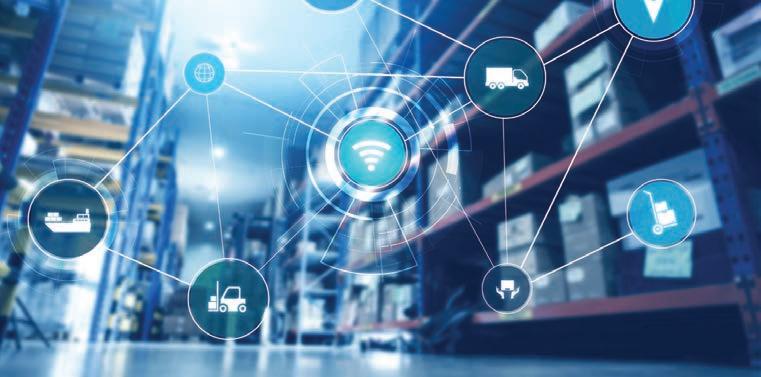

also find it easier for the spend to be approved internally when it’s a monthly OPEX cost.
BRINGING INVESTMENT FUNDING INTO THE PLANNING PHASE
The earlier an asset finance solution can be introduced within the planning process, the more likely the end user will be able to progress with the investment in automation, and development of their business. Bringing asset funding into the planning and consultancy phase enables customers to understand their ideal business scenario with a more accurate idea of future costs.
Financing should be an integrated
part of the logistics planning process. Integrating logistics planning and smart financing helps to break down some of the common barriers to automating logistics processes. It provides a total package, securing a solid foundation for long term optimization of logistics processes. This ultimately enables future growth for the business, pushing forward innovation in intralogistics.
LEARN MORE ABOUT FINANCING AUTOMATION SOLUTIONS
In the end, the right financial product, contract structure, and terms depend on the individual customer’s requirements. However, integrated logistics planning and smart financing can help end users to invest, and ultimately achieve efficiency gains and reduce their Total Cost of Operation. ■
Use the QR code to find out how DLL can help with funding your specific warehouse automation project.
Contact Steven at +61 413 892 725 or steven.davey@dllgroup.com
MHD AUGUST 2023 | 47 MHD SUPPLY CHAIN
The earlier an asset finance solution can be introduced in the planning process, the likelier the project is to progress.
Financing should be an integrated part of the logistics planning process.
MOOREBANK INTERMODAL PRECINCT
The Moorebank Intermodal Precinct is more than a decade in the making and offers unprecedented connectivity, functionality, and sustainability benefits to tenants –current and prospective. MHD caught up with LOGOS’ Trevor Lee to learn more.
Located 32 kilometres southwest of Port Botany and Mascot Airport, the Moorebank Intermodal Precinct is a boon for supply chain managers and logisticians as they face a new era characterised by surging e-commerce and shrinking industrial vacancy rates.
According to Trevor Lee, Senior Development Manager at LOGOS, the prime location and dedicated freight rail line from Port Botany to Moorebank will drastically slash the time taken for containers to transit from the port to Moorebank’s import-export (IMEX) rail terminal.
“Moorebank is a very quick journey for a freight train for the containers to go from the port, much quicker than going by road via truck due to traffic,” Trevor says. “The process at the port itself is also quicker and more efficient than the traditional method.”
Currently, with a ship carrying between 5000 and 10,000 containers, it takes about four days from port arrival for a container to reach a warehouse in Western Sydney. With Moorebank’s
dedicated freight rail linkage direct from port, the process is far more efficient.
“A whole train arrives at port and can take 80 containers at once,” he says. “So, a ship comes in, they take the containers off the ship, and they put them on the train that’s waiting there. As soon as that train is full of 80 containers, that train then leaves and heads out to Moorebank.”
Compared to trucks lugging containers off individually, occupants of Moorebank can expect this to halve the transit time of goods.
The efficiency doesn’t stop at the port. Once the container arrives at Moorebank, it’s handled by the dedicated IMEX terminal with automated cranes for rail servicing.
“At Moorebank the IMEX terminal operator, Qube, can unload the train and then take your container from the terminal and deliver it straight to the backdoor of your warehouse,” says Trevor. This streamlined operation ensures tenants can focus on their core business operations within the warehouse.
“At full capacity we estimate that Moorebank will take about 3000 trucks off the road every day by moving containers via train,” he says. “This not only reduces traffic congestion but significantly cuts carbon emissions.
“That whole process of a container coming in, going to the dock door, being picked up from your dock door, brought back to the terminal then taken away again, is much faster, more efficient, ultimately cheaper and more sustainable.”
STRATEGIC LOCATION AND DESIGN
Moorebank is strategically located in south western Sydney, close to the connection of the M5 and M7 motorways which services the growing number of major importers both already established and locating to this broader region of Sydney away from the direct port environs. Moorebank is a purposebuilt, master-planned terminal built from the ground up, creating a statesignificant dedicated freight logistics precinct combining leading edge

48 | MHD AUGUST 2023 MHD INDUSTRIAL PROPERTY
Moorebank’s sheer size has allowed LOGOS and its partner Solar Bay to install and operate significant solar power, leveraging the 850,000 square metres of warehouse floor space for solar panels.
rail servicing and warehousing. The advantages of this, according to Trevor, are many.
“There are other rail intermodal terminals in Sydney, but nothing of the same size, scale or with a master planned layout that we have here,” he says.
The genesis of the precinct traces back to an announcement by Anthony Albanese, the then Infrastructure Minister, in 2012. “The entire site was previously a Defence facility, right next to the largest army base in Sydney,” Trevor notes. “Backed by a significant Commonwealth Government investment and after a period of careful planning and development – the precinct began its operations in earnest around 2019.”
Aside from rail connectivity and locational advantages, Moorebank sets itself apart for efficient land use.
Traditional methods that involve trucks and massive amounts of hardstand concrete are replaced with automated cranes servicing rail and direct transfer to warehouse by straddle carrier or combi-lift. These dedicated vehicles move the containers from the IMEX terminal to the warehouses, freeing up substantial space on-site.
While big players such as Qube Logistics and Catch.com.au are up and running, and major tenants, Woolworths (Primary Connect) and Mainfreight, are due to commence operations over the coming 12 months, Trevor notes that “there’s still much untapped potential at Moorebank”.

“There are 850,000 square metres of warehouse floor space that we’re planning approved to build in the precinct,” Trevor says. “There’s about 250,000 square metres which are built and occupied currently. That leaves us 600,000 square metres. So, there’s about one third that’s built and occupied at the moment.”
This means that Moorebank Intermodal Precinct is far from reaching its capacity. With two thirds of the site still awaiting development, the precinct presents an immense opportunity for potential tenants seeking efficient and effective logistics solutions.
A SUSTAINABLE SOLUTION
“Like everyone, we utilise solar power – but we’ve taken it to the next degree,” Trevor says. “It’s a huge part of our development and perhaps the
defining feature.”
The project’s sheer size has allowed LOGOS and its partner Solar Bay to install and operate significant solar power, leveraging the 850,000 square metres of warehouse floor space for solar panels.
With the ability to generate a minimum of 60 megawatts, the precinct produces “more solar power than we will ever use within the estate”. This means every tenant can power their operations with renewable energy. Furthermore, the surplus power isn’t wasted. “We’ll also export solar power back into the Sydney electricity grid.”
LOGOS is looking at incorporating large-scale batteries into the estate. This would allow the tenants 24-hour access to solar power, irrespective of the weather or time of day.
Unlike many other estates, the tenants at Moorebank Intermodal Precinct don’t have to rely on offset credits from external sources – they can be entirely powered by renewable energy produced on-site.
This carbon-neutral operation extends to the entire estate, including the IMEX terminal and crane automation systems servicing the rail. As electric vehicle technology becomes more prevalent, the precinct will have ample power left over to charge these vehicles.
The sustainability of the precinct is further reinforced by the protection of approximately 100 hectares of land surrounding the precinct. Managed by National Intermodal Corporation, these biodiversity areas will provide ongoing habitat to a range of plant and animal species in the area.
Looking ahead at the vast potential that the Moorebank Intermodal Precinct still holds, it’s an exciting prospect for prospective tenants and businesses. “What we’re really looking for are businesses that will get the most benefit from using the rail, and companies that have lots of containers.”
Businesses that heavily rely on container shipments, whether inbound from overseas or distributed interstate, can greatly benefit from the precinct’s efficiencies. These businesses generally fall into three categories: retailers, third party logistics companies, and materials suppliers.
“So, we have Woolworths (Primary Connect, Catch.com.au (a Wesfarmers e-commerce brand), Mainfreight, Qube Logistics, ATS Timber, PCA Express, and Caesarstone, who import all their stone benchtops from overseas,” Trevor says, highlighting the diversity of tenants already leveraging the unique advantages offered by Moorebank Intermodal Precinct.
“Freight forwarders, who manage container freight for others and distribute it – they will find Moorebank to be a great proposition, too,” Trevor adds. These businesses align well with the precinct’s mission and stand to gain the most from its facilities.
“We have minimum warehouse sizes of about 20,000 square metres, and we can build up to 200,000 square metres for a single tenant. These are big warehouses. This means that large businesses that can utilise these vast spaces, alongside the precinct’s unique logistical efficiencies, are ideal for this amazing development.” ■
MHD AUGUST 2023 | 49 MHD INDUSTRIAL PROPERTY
Moorebank Intermodal Precinct was purposebuilt as a freight logistics precinct combining leading edge rail servicing and warehousing.
KEEPING IT COOL WITH DEMATIC’S AGVS
Cold chain storage facilities can be extremely dangerous places for operators to work in. Tony Raggio, General Sales Manager, and Wade Adams, Group Manager at Dematic, explain to MHD why the company’s third-generation freezer rated automated guided vehicles are suitable solutions for smoother and safer operations.
Dematic is renowned for designing, building, and providing intelligent automated solutions.
Its latest innovation is the third iteration of its freezer rated automated guided vehicles (AGVs) – driverless robotic forklifts that operate autonomously to transport a wide range of materials within a facility – for cold chain storage environments. This is the only one of its kind available on the Australian market, and one of few available worldwide.
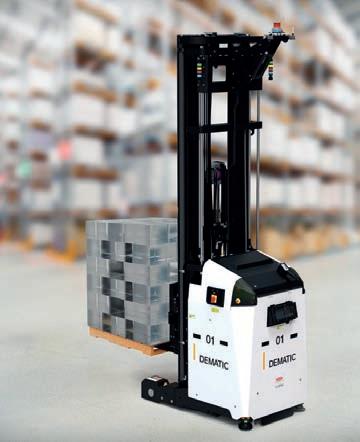
When working on these newest AGVs, Dematic’s local Sydney-based operations, had to meet the new global safety standard, which requires any type of AGVs or AMRs (autonomous mobile robots) to include certain safety sensors, devices, and safe program logic to avoid and proactively minimise risks in the workplace
The third-generation freezer rated AGVs feature advancements in both sensor and navigation technologies, on both the high-reach and counterbalance models, and has been entirely designed and built in Australia where it’s being deployed.
PRIORITISING SAFETY
Cold storage facilities pose occupational health and safety risks, which can lead to injuries in the workplace. A range of safety checks and restrictions are required to protect operators.
According to SafeWork NSW, working in extremely cold environments increases risk to worker health and safety.
A list of potential harms from prolonged exposure to cold stress includes fatigue, mild to serious health issues (increased risk of incident/injury, hypothermia, and frostbite/trench foot), and long-term health effects (arthritis, rheumatism, breathing difficulties, and heart disease).
Workers in manual warehouse freezer operations need frequent breaks from the cold – every hour worked in the freezer requires 10 to 20 minutes out of the freezer. An AGV system minimises these risks and increases productivity because it can pick and transport products full-time in -25°C environments automatically and can be controlled remotely if required.
AGVs operating in Australia are covered under the recently updated Australian Standard – AS 5144-4 (equivalent to the International Standard – ISO 3691-4), which specifies clear procedures for achieving safety for both manufacturers and operators.
Dematic AGVs are designed to meet the Australian safety standards. Some of the safety features include: 360° safety scanning system with automatic slowing and stopping; easily accessible emergency stop buttons; visual and audible warning and alarm lights; redundant and safety-rated features; and compliant system and solution design.
Food & beverage and grocery supply chains operating cold storage facilities will find AGVs can help them overcome the complex challenges compounded by occupational health & safety and labour shortages. This solution can
perform in these harsh cold chain environments 24/7.
“Our design team paid a lot of attention to detail when redeveloping the latest AGVs,” says Wade Adams, Group Manager (Mobile Automation) at Dematic. “They looked at serviceability, usability, and operability. These operators can’t be inside these cold storage facilities for long due to the potentially hazardous conditions.”
While AGVs overall run predictably, the in-built safety sensors ensure that on the rare occasion when something doesn’t go to plan – such as an unexpected hazard (material or human) getting in the path of an AGV –the AGV will stop and avoid any incidents with items in their field of view.
These AGVs are not only less likely to cause harm, injury or damage to workers, products, or warehouse infrastructure, they’re also capable of
MHD AUGUST 2023 | 51 MHD SUPPLY CHAIN
Dematic’s third-generation freezerrated autonomous guided vehicles.
increasing productivity and efficiency gains. Dematic’s AGV safety package includes both in-depth personnel training and environmental awareness.
“This isn’t a common application,” explains Tony Raggio, General Sales Manager – Dematic ANZ Mobile Automation. “Dematic is one of only a handful of automation companies globally creating these freezer rated solutions.
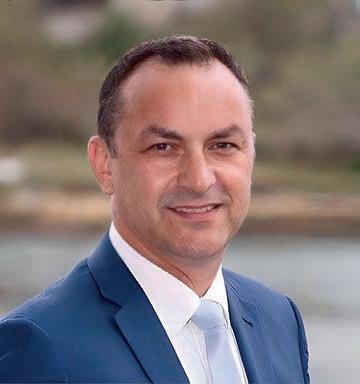
“We have 10 years’ worth of experience in this field. One of the things that’s changed during this time, is that we now have access to freezerrated components whereas a decade ago we had to work with non-freezer rated components.”
AUSTRALIAN MADE AND OPERATED
Freezer applications are usually in remote areas such as rural parts of a state or territory. This coupled with harsh working conditions usually deters potential operators from applying for cold chain-related roles.
AGVs suit the cold storage facilities because – unlike workarounds such as regular forklifts with an enclosed and heated cab – they don’t impact the environment’s regulated subzero temperature that they’re operating in.
An AGV solution remains in the freezer where it can sort several thousand pallets. By moving the AGV in and out, it means there’s no need to open doors frequently, and it makes it easier to control the room’s temperature.
“AGVs don’t have heated cabins that create excessive heat,” Tony says. “That would then require us to add more energy to keep the freezer cold.”
Two committees – one from Dematic’s parent company, KION Group, called Global Safety Committee – and Dematic’s own Local Steering Safety Committee, reviewed the global standard and developed a program off the back of it. This involved a full risk assessment and implementing the controls. It was executed locally and supported globally.
“We’re the only AGV company that has a design and software team based in Australia, which is unique for this market,” notes Wade. “We can install the AGV and provide local support for the system. We have service teams in the major capital cities, and they’re all trained specifically on these AGVs.”
The freezer rated components used in

the AGVs are from Dematic’s suppliers. AGVs have replaced the human element in the harsh refrigerated environment with a machine that is only removed from there when it needs to be serviced. An operator rarely needs to go into the freezer; they can simply handle all the operations on the other side of the wall.
“There are always operational reasons for people to go into the cold storage facility, but this new generation minimises the duration the personnel needs to spend in those environments,” explains Wade. “By minimising exposure to the cold, you can minimise risks.”
Manual labour in refrigerated environments and using a freezer forklift is gruelling, says Tony. “Operators don’t need to be a mechatronics engineer to monitor a Dematic AGV. Forklift drivers can operate these solutions. While the technology’s hardware and software are complex, the interface has been designed to be simple and easy to use.
“Our AGVs don’t require full-time attention. The operator only needs to spend a small percentage of their time monitoring the AGV, which means they can focus on other tasks and the business can save on costs.”
INCREASING PRODUCTIVITY AND ROI
To help customers with operating Dematic’s AGVs, the company offers mentoring and training programs. This involves onboarding and equipping operators with the skills required to use the solution when its system goes live without needing a Dematic technician in the facility.
“I use the phrase predictable logistics,” Tony says. “If you’re trying to run a business at 100 pallets an hour, and all of a sudden four forklift drivers don’t turn up for work, then you can
only run 50 pallets an hour.
“If an AGV solution is designed to run at 100 pallets an hour, you can count on it to run at 100 pallets an hour, 24 hours a day, seven days a week. And with labour, you can’t do that, so you don’t have the reliability in your business of knowing what you’re going to be able to produce because you don’t know who’s going to turn up to work in the morning.”
He notes many of Dematic’s customers are saying they are currently experiencing high staff turnover and a competitive landscape when it comes to wages.
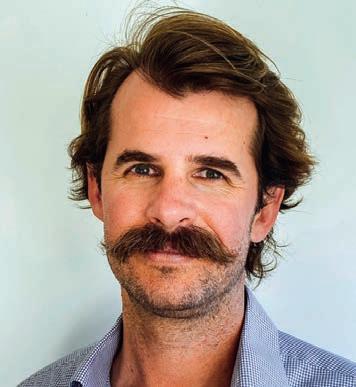
“For example, five people may turn up for an interview. They’ll be offered a job then when Monday comes around, only two people will show up. This is often due to the fact that the roles require working in cold storage facilities where the conditions are tough and very unpleasant.”
For those running multi-shift operations, Dematic AGVs can provide extremely short ROIs.
“One person per shift can monitor and support 15 AGVs,” explains Wade.
“In most safe work method statements or risk assessments, there’s a risk matrix, which works on the premise of consequence versus probability or likelihood. By removing team members from the operation or lowering their duration in the cold environment, you can work to lower the risk of incidents.”■
For a free site assessment or a tour at the Dematic Manufacturing Facility in Belrose, NSW, please contact:
Tony Raggio
0403 222 697
Tony.Raggio@dematic.com
Tony Raggio, General Sales Manager – Dematic ANZ Mobile Automation.
MHD SUPPLY CHAIN 52 | MHD AUGUST 2023
Wade Adams, Group Manager (Mobile Automation) at Dematic.

GIVING FOOD A VOICE
food they send out from despatch to destination.
Escavox’s solution is comprised of smart hardware IoT devices and intelligent software.
“We send out a tracking device – about the size of a small mobile phone – to food producers,” Luke says. “It uses phone technology to communicate; it’s completely independent and runs by itself. The producer then drops the device in at the point of the pack – normally one per pallet – before it goes out the door.”
These devices register time, temperature, location, humidity, light and motion, reporting data to the producers every half an hour.
“Right now, we lose between five and 30 per cent of our horticulture to waste, and between three and five per cent of our meat,” says Luke Wood, CEO of Escavox, a company specialising in supply chain visibility provision for food producers. “We are paying to throw away perfectly good food that doesn’t need to be discarded, simply because we lack the information to manage and control it.”
That there should be more waste in fresh food supply chains than in others isn’t surprising when you’re dealing with a perishable good. But that just means the stakes are higher for food producers sending products through the supply chain. It’s a challenge compounded, Luke says, by the fact that food supply chains aren’t vertically integrated.
“What we have are many producers, multiple carriers and logistics providers, and several retailers,” he
says. “This forms a complex, manyto-many-to-many relationship. Food is also distinct in that its value changes in the supply chain because it physically changes properties. A pair of jeans remains a pair of jeans no matter where it is in the supply chain, and we’re just debating cost as we go along.”
Thus, when something goes wrong –a strawberry turns into goo somewhere in its journey – it’s difficult to discern why, and who’s responsible.
“The food world is littered with this shell game of accountability – who created the problem, who can be held accountable for the problem, and who can be charged for the problem?” Luke says.
If only the food could speak for itself.
Enter Escavox, whose name roughly translates to the “voice of the food”, which offers producers an easy-toimplement means of tracking the
The data is easy to access through Escavox’s browser-based platform, although it can be adapted by tech savvy users, too.
“If you’re a top-end user, you can access via API and extract the data into your platform. If you’re a regular user, you go onto our web service and have a look at the data. We’ll be sending alerts out, updating you in real time.”
For a low profit margin industry, where there is an in-built incentive to shift the blame for spoiled produce, Escavox’s visibility solution is a boon.
Like all great ideas, it seems obvious in retrospect. How did Luke and the Escavox team come up with it?
“Much of my career has been spent in the supermarket sector –first at Sainsbury’s in the UK, later at Woolworths in Australia,” he says. “At one point I was leading a supply chain system redesign at Woolworths, overseeing warehouse systems, transport systems, inventory control, automation, on a large scale.

When food spoils before it can even reach the customer, everybody suffers –especially suppliers who spend so much time, energy, and resources putting out the product to begin with. Luckily, Escavox’s food visibility solution is here to help.
54 | MHD AUGUST 2023 MHD SUPPLY CHAIN
MHD caught up with CEO Luke Wood to learn more.
Luke Wood, CEO of Escavox.
Woolworths are known as “the fresh food people”, and we wanted to get products to the shelf quicker and in better condition. We started working on how long it takes to get berries through the chain and realised that we didn’t really know. The more we dug, the more we realised nobody actually knew.”
The hardware to track the data existed, but the data itself didn’t. And as receivers of goods rather than producers, the incentive structure wasn’t there for supermarkets to devise such a solution themselves.
Luke was working with Nicola Sanderson and they decided to set out on their own to create the solution. As it happened, Chris McLoghlin – 2018 Horticulture Australia’s Young Grower of the Year – was independently working towards the same end.
“We had a meeting and realised we were all exhausting ourselves working towards the same goal, and that we could achieve it if we worked together.”
While retailers might benefit from the data, it’s producers who sorely need it, as they need a way of assuring the quality of their product and proving it to other stakeholders in the supply chain.
“It all starts with risk mitigation,” Luke says. “The first thing is making sure the load arrives at the customer in the right way. If it’s a retailer, it’s about preventing rejection. If it’s an exporter, it’s about making sure it gets accepted at the port and secures the expected price.”
Having access to the right tertiary data also means that producers can make informed and provable claims about their responsibility within the supply chain.
“It really empowers producers and allows them to hold their own in an often-tough industry,” Luke says.
Beyond solving a tangible, on-the-ground problem that has long plagued producers, Escavox’s visibility solution is a plus for the environment, economising not only on food waste but also on wasted mileage transporting defective products.
In June, the International Fresh Produce Association (IFPA) released its Future Trends Report for Australia and New Zealand at Hort Connections in Adelaide, identifying six challenges which, if not addressed, will cause
significant negative outcomes for food producers in the next five years: climate change, food loss and waste, supply chain issues, labour costs and availability, water availability and sustainability of inputs.
To address these challenges, the report recommended the uptake of several technologies. Among them was “real time tracking and traceability”, which it defined as the “Use of digital technologies to monitor the movement of produce as it travels through the supply chain to its destination and beyond to a customer [and that] provides end-to-end oversight and transparency of products.”
Which is precisely what Escavox is offering. Happily, it’s an instance of traditional economic incentives aligning neatly with sustainability incentives.
“Today we face both price pressures and environmental pressures,” Luke says. “But by managing one, we can reduce the other. We have the ability to do better, and we have a window of opportunity where nobody has to lose by doing it because there is so much waste baked into the system. It’s not a zero-sum game.”
Proof of Escavox’s success is in the pudding, with the company quickly gaining both clients and new team members to service producers acrossAustralia.
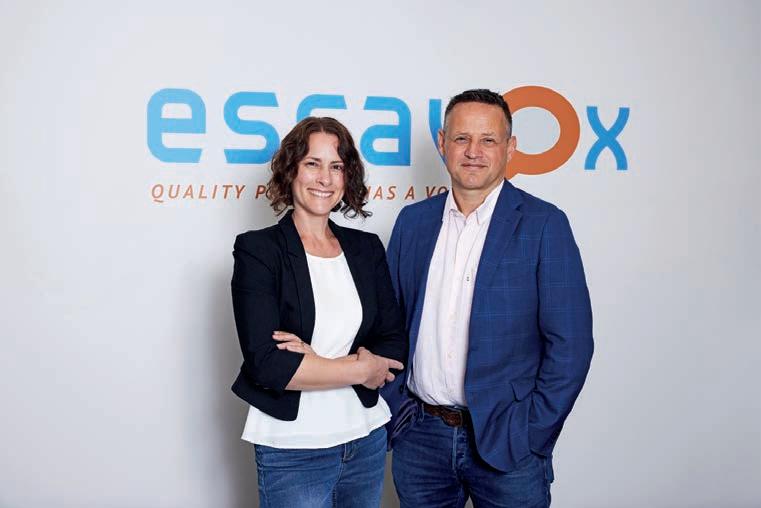
“We now have more than 150 clients, most of whom are producers,” Luke says. “We have working relationships with all the retailers here in Australia. And we’ve developed a whole logistics network around our devices to ensure our own sustainability.”
Escavox has built a strong reputation among producers because they’re delivering something no one else is.
“We don’t have direct competitors,” Luke says. “There are many device companies out there, but they’re all trying to build a very generic device for many different purposes. None of them are really suited to food and its unique needs – so we built our own.
“There are many software solutions out there that can help you manage your assets for a supply chain. Everyone can tell you how the asset is working, but nobody is optimising for the product. We don’t see anyone else in the world doing what we’re doing.” ■
“
” MHD AUGUST 2023 | 55 MHD SUPPLY CHAIN
The food world is littered with this shell game of accountability – who created the problem, who can be held accountable for the problem, and who can be charged for the problem?”
Nicola Sanderson, Chief Customer Officer, with Luke Wood, CEO.
INTRODUCING MUSHINY
In the high-octane world of global logistics, where efficiency and innovation are the keystones of success, one company stands out for intelligent warehousing systems: Mushiny.
Founded in 2016 by Lui Ming – also known as ‘K2’ – Mushiny was born out of an obsession to master the nuances of warehouse operations and fine-tune them with cutting-edge technology. K2’s story begins at Amazon, where his warehouse – the fifth most productive of Amazon’s warehouses worldwide –demonstrated his expertise in the field. Yet, K2 was not content with being fifth; he sought to understand what the top three had that he didn’t.
The answer? Automation, properly orchestrated with the right software.
Thus, Mushiny was conceived with a vision to leverage automation in the realm of warehouse operations, particularly Autonomous Mobile Robots (AMRs).

Initially, K2 eschewed the idea of manufacturing hardware. In his perspective, hardware was a relative commodity, whereas the real key to ushering in a new era of warehouse automation lay in the realm of superior software.
So, he created the software he wanted to see in the world.
The triple-layered Mushiny software suite is a comprehensive and customisable open system designed to meet the specific operational requirements and diverse scenarios of customers’ warehouse operations.
The first layer, referred to as the R-WMS module, serves as an interface between the customers’ ERP or WMS system. It offers a complete solution for warehouse operations, encompassing tasks such as receiving, replenishment, picking, packing, cycle counting,
and more
The second layer, known as the Robot Management System (RMS), provides advanced functionalities for complex path planning, traffic management, and map management. It enables efficient control of multiple types of robots within the same facility.
The third layer consists of the Business Intelligence (BI) module, which offers powerful dashboards and analytics to empower end users with actionable insights, facilitating operational efficiency improvements.
Importantly, the software suite includes an emulator that accurately replicates the real-world behaviour of the robots including simulating battery status and charging, which allows Mushiny to optimise the robot grid and overall solution design before deployment. The emulator also enables planning for system modernisations without disrupting ongoing operations.
Facilitated by a unified interface, the entire Mushiny software suite is seamlessly integrated and accessible through a single sign-on process. This enhances usability and streamlines operations across all
functions of the warehouse.
But K2 discovered that most customers wanted to buy hardware and software together – so Mushiny began manufacturing robots, too.
Today, the company is not just a software powerhouse but also a distinguished manufacturer of reliable, cost-effective hardware. Its considerable human, physical, and intellectual resources underscore its commitment to manufacturing excellence. Mushiny offers a full suite of autonomous robots ranging from its standard AMRs, singleor dual-cell pedestal sorters, shuttle ACRs, and has recently launched the M Series, which is tailored for greater interaction with people.
INTERNATIONAL EXCELLENCE MEETS LOCAL EXPERTISE
While 2023 isn’t the first year Mushiny’s solutions have been available in Australia, it is the first time Mushiny has an official presence on Australian shores – setting up a new office and Australian team and bringing the best local personnel available into the Mushiny family.
Peter Ramsay, Director of Mushiny
56 | MHD AUGUST 2023 MHD WAREHOUSING
From its ambitious beginnings to its strategic expansion into the Australia-New Zealand market, learn how Mushiny – and its new local team – is shaping the future of warehouse operations, one robot at a time.
Mushiny was born in 2016 out of an obsession to master the nuances of warehouse operations and fine-tune them with cutting-edge technology.
Australia, says Mushiny decided to invest in a local presence to better serve what it sees as a key market. “Our initial strategy was to wholesale into this market through local agents,” Peter says. “However with five existing sites and strong demand Mushiny believes Australia and New Zealand has significant potential, and deserves the best in on-the-ground service supporting the leading technologies available internationally.”
The core of Mushiny’s strategy isn’t merely about selling equipment, it’s about delivering comprehensive solutions, Peter says. Establishing a local presence in Australia was a crucial step in achieving this vision: “The best way to serve customers is to understand their specific operational needs, and to deliver elegant solutions that are business accretive.”
And it isn’t just about maintaining customer relationships or facilitating transactions; it’s about providing a complete suite of services which drive sustainable benefits.
“Our new Australian Mushiny team means we can provide a full service, from design through to implementation, commissioning, maintenance, and support for the entire lifecycle of the installation,” Peter explains. “In short, if you deal with Mushiny you are assured of a turnkey solution that works and will keep working.”
Peter leads – alongside fellow Mushiny Australia Director Byron Patching – a team of experts with deep
experience implementing warehousing and automation solutions.

Peter himself has spent decades in the industry – from his time at Woolworths driving Project Refresh to transform its supply chain, to founding and running XAct Solutions for 15 years.
However, it was a particular kind of technology that captured his interest and redirected his career trajectory towards Mushiny Australia.
“I have worked in logistics my entire life,” Peter says. “During that time, I encountered many automation projects, which were invariably challenging due to their extensive lead times, capital requirements, and integration complexity.”
When he discovered AMR-centric technology, he found it “refreshing”, noting its flexibility and growth potential. “The scalability of the technology allows its adoption by companies for whom automation was not traditionally accessible. Being able to deploy in months as opposed to years, and only needing to size for current operational volumes and then incrementally invest in additional capacity to cater for actual business growth, provides a compelling proposition.
“Mushiny’s intelligent approach, commitment to quality, and customer focus is why I am delighted to join Mushiny. Byron is of very similar mind, and so we are excited about Mushiny’s future in Australia.”
In addition to Peter and Byron, the
team includes Scott van Munster, the General Manager of Solutions, Grant Beringer, the General Manager of Operations, and Stephen Su, their Senior Robot Engineer. The local leadership has the access and full support of roughly 200 specialist resources globally to facilitate the comprehensive approach Mushiny takes in offering fully integrated solutions. From planning and implementation to operational oversight and technical expertise, Mushiny Australia encapsulates the company’s global vision and dedication to local market needs.
JUST THE BEGINNING
Mushiny has an impressive R&D program powering an ambitious product development road map. Leveraging its core AMR technology, Mushiny launched its MIX system at LogiMAT in Stuttgart in April, which offers greater storage density and utilisation of available warehouse height, and is capable of supporting higher volume operations. Another ground breaking product will be launched in October 2023 at CEMAT Asia, Shanghai.
In essence, Mushiny’s DNA is a blend of solution-focused strategies, software-enabled systems, innovative hardware, and a strong dedication to the Australia-New Zealand market. Its mission in Australia is to provide customised, turn-key solutions that exceed customer expectations, offering consistent support to ensure long-term efficiency and success. ■
MHD AUGUST 2023 | 57 MHD WAREHOUSING
Mushiny offers a full suite of autonomous robots that coupled with next generation software delivers operationally effective turn key solutions.
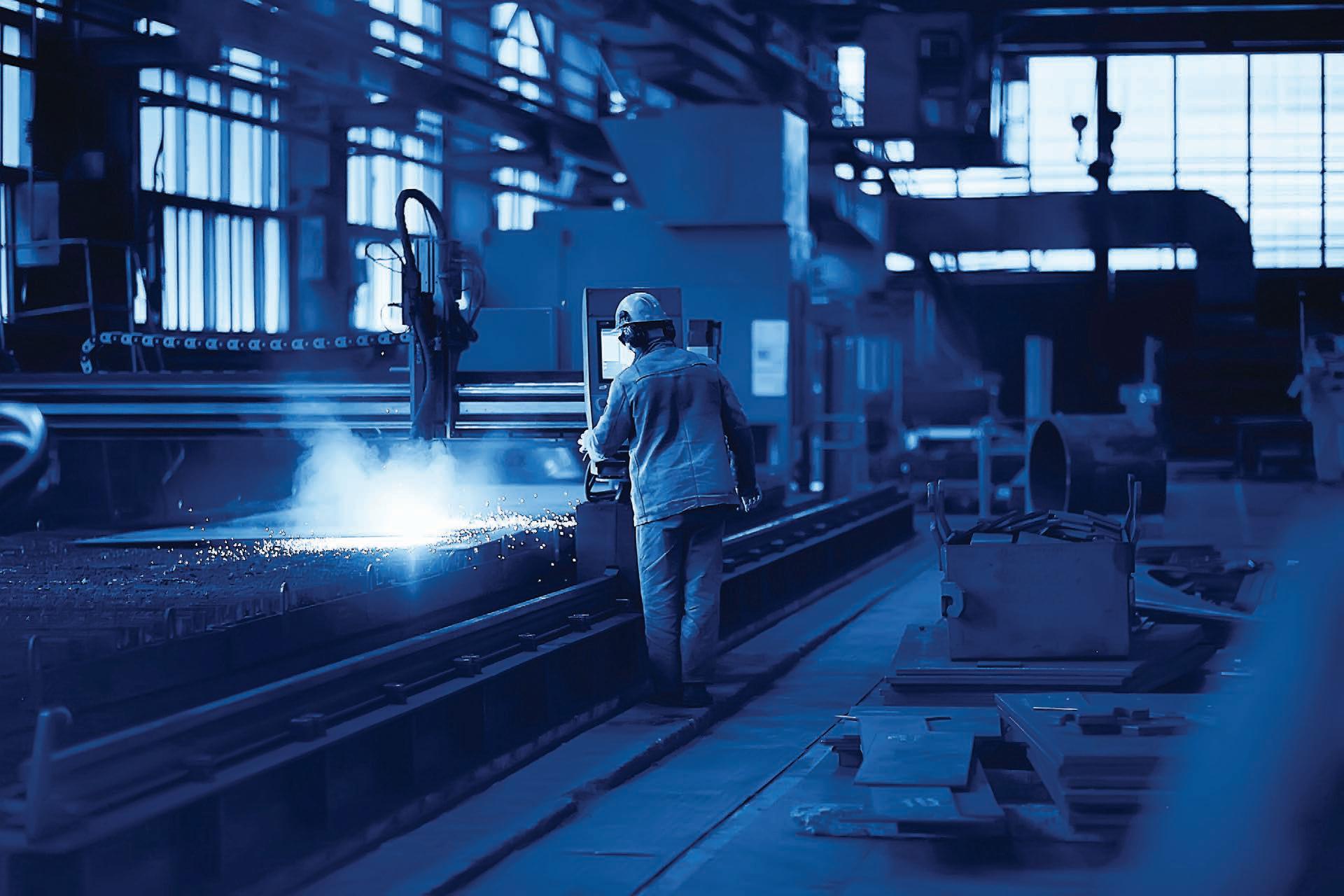




3 NOMINATIONS NOW! OPEN AUSTRALIA’S LEADING MANUFACTURING AWARDS endeavourawards.com.au IN PARTNERSHIP WITH
READY FOR THE FUTURE OF WAREHOUSING?
n an era where disruptive events have become the new normal for supply chains, warehouse management professionals are confronted with an increasingly challenging landscape.
Every year brings about major disruption, and every few months minor disruptions occur that test the resilience of warehousing and supply chain operations. At the same time, these disruptions also present opportunities for growth.
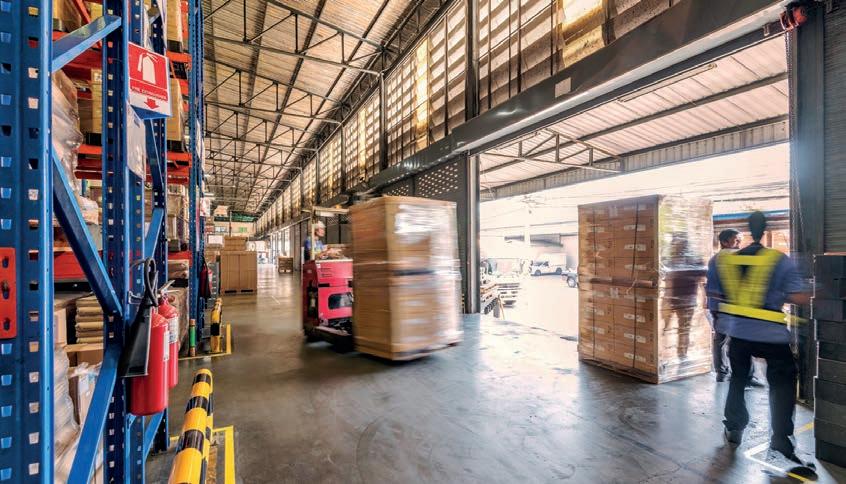
It’s this latter point that Sam Dawson, Partnerships and Business Development Manager at Microlistics, emphasises.
“Continuing supply chain threats and opportunities are the new normal,” Sam says. “Supply chain professionals can now expect a major disruption every year or so, with minor disruptions occurring every few months. It’s imperative to remember that some of these disruptions also come
with opportunities for growth.”
THE FUTURE OF WAREHOUSING
There is a gradual transformation occurring in warehouses across the globe. Warehouses are transitioning from an RF-connected workforce to one where warehouse worker performance is maximised through voice recognition and wearables.

“Voice recognition eliminates the need for keystrokes and reduces manual data entry errors,” Sam says. “Wearable technologies enable pick-by-voice and pick-by-vision, offering even greater resource optimisation.”
The future of warehousing also lies in artificial intelligence (AI) and machine learning, which build on the foundations of advanced business intelligence tools.
“Bridging from advanced business intelligence tools to AI and machine learning will apply past lessons to
future warehouse performance,” says Michael Weir, Managing Director at Microlistics. “This is a key aspect of the warehouse of the future.”
While warehousing may appear quite simple – boxes in, boxes out – Michael says in future WMS must move away from over-centralisation to decentralisation and flexibility.
“Running a busy warehouse operation efficiently, accurately, and effectively requires managing a large number of constantly changing variables,” he says. “Current advanced WMS centralise decision-making, systemising minute-by-minute decisions to prevent worker errors. As we look to the future, we expect systems to be able to dynamically assess variables in real time, learn from past performance, recognise patterns, and make quick determinations on how to handle exact scenarios at hand most effectively.”
These variables include best use of labour, Sam adds.
“At Microlistics we’ve been working on labour planning analytics to project how long certain tasks will take,” he says. “This is a guide for warehouse managers and supervisors to help them plan for the next day.”
Changes to how material handling equipment operates are also coming thick and fast.
Old-school conveyors and vertical carousels are fitted with scanners to make decisions based on scanned products, and the advent of automatic guided vehicles (AGV) signals a change in how material handling is approached in warehouses.
“When a specific activity can be closed off from the rest of the warehouse, it can be more fully
MHD AUGUST 2023 | 59 MHD WAREHOUSING
Microlistics’ Michael Weir and Sam Dawson discuss the future of warehousing, the “evolutionary” approach to adaptation, and why a cloud-based WMS is part of the solution.
With labour availability an ever-present concern, Microlistics has been working on labour planning analytics to help warehouse managers better plan.
automated,” Sam says. “AGVs are an excellent example of this, as they travel along a wire running under the concrete warehouse floor. In both these cases, these technologies free up human resources for higher-value tasks.”
THE EVOLUTIONARY APPROACH
To adapt to the future warehouse, Michael says, companies must move from a “revolutionary” approach to an “evolutionary” one.
Understanding the difference between an evolutionary and a revolutionary approach to warehousing is crucial in navigating the rapid advancements in technology and shifts in market trends.
Michael explains the difference.
“Taking an evolutionary approach –rather than a revolutionary approach –means accepting that things are moving too fast for you to update and change your warehouse systems in one go,” he says. “Instead, you really need to build a solid foundation because tomorrow will be different from today. Trying to cater for every possible future solution and implement it all at once can lead to an overly complex project, and it may take a long time to see any benefits.”
Michael advocates for an iterative approach to warehouse change, building on a solid foundational platform.
“Our suggestion is to start with a solid foundation, reap the benefits from that, whether it’s extra efficiencies or freeing up cash for reinvestment,” he says. “These resources can then give you the opportunity to tackle the next change, the next improvement, or the next unforeseen challenge. Once you have that good platform, you can iteratively add in automation and other advanced operations like voice and RF.
“Embracing an evolutionary approach emphasises speed-to-benefit, flexibility, and adaptability,” he says. “This approach can deliver faster time-to-benefit and more immediate ROI from changes. That ROI can then be reinvested into continuous improvement.”
WHY EVOLUTION NEEDS THE CLOUD
Cloud-based WMS technology presents a compelling case for futureproofing warehouses in an iterative, evolutionary manner.

“Cloud-based WMS technology scales to handle processing needs without capacity over-compensation,” explains Sam. “It has ready integrations with existing supply chain and business management systems, takes a modular approach to functionality, and gives you access to a constantly evolving product that is continuously improving.”
When asked about the unique strengths of Microlistics’ cloud-based WMS, Michael highlights scalability and flexibility as crucial advantages.
“The scalability allows you to build for today’s needs and ties back to that evolutionary approach,” he says. “You don’t have to overcompensate today for what the future might look like. It’s a system that will be able to scale up fairly easily, providing extra capacity and resources as needed.”
This flexibility extends to the system’s modularity and integration capabilities.
“It’s about having a modular approach to the needs, knowing that there are additional modules that can be turned on, there are different features within a cloud-based WMS that you can easily enable when
you’re ready for them,” Michael says. “Likewise, it comes with the ability to connect to other supply chain systems, automation, transport, freight management systems, and business intelligence places. Modularity and connectivity are hugely beneficial.”
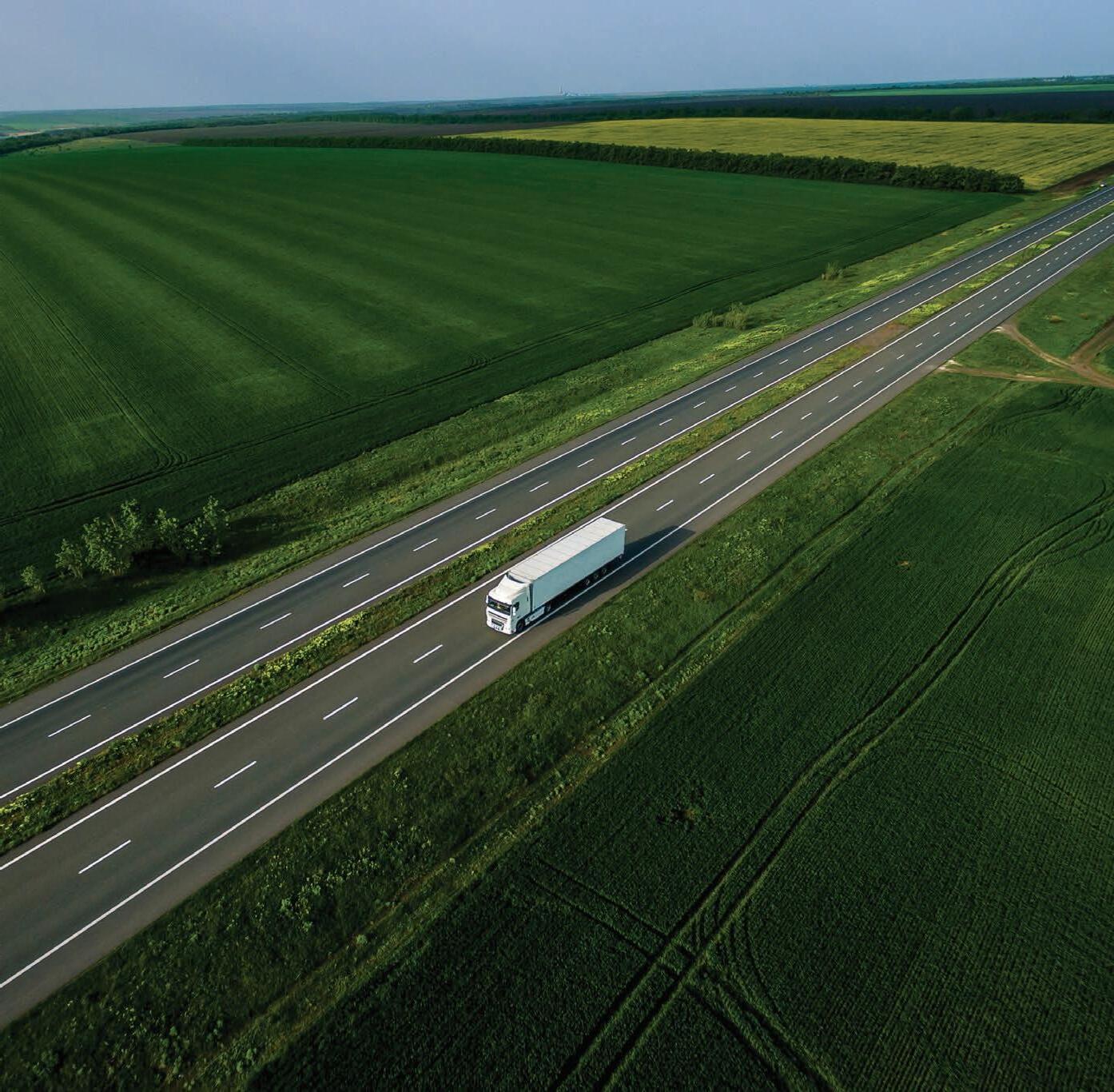
Beyond the flexibility and scalability, Microlistics’ cloud-based WMS stands out for its continuous product improvement.
Michael notes that the system provides “access to evolving products and functionalities as new technologies emerge … Microlistics WMS connects those external technologies, building on internal capabilities. It’s a much more rapid way to provide those benefits to your business.”
Sam Dawson, reinforcing the benefits of the cloud-based system, draws attention to the consistency it offers, particularly in terms of support and deployment.
“As our client base transitions to Microlistics Cloud, it makes things very consistent from a support perspective,” Sam says. “When we go to upgrade in the future, we know exactly what we’re dealing with.”
In considering investments in cloudbased WMS technology and other advanced operations, the underlying principle should be consistent returns on investment.
“These systems are expensive,” Sam says. “So, if you don’t see a quick return on investment, your leadership is going to be less inclined to invest in this next-generation technology. But if you continuously demonstrate ROI, then it’s going to be much easier to take that next leap.
“In other words, the adoption of Microlistics’ cloud-based WMS should not only be seen as a step toward modernisation but also as an investment with tangible, continuous returns.” ■
Microlistics WMS is available as part of CargoWise Warehouse solutions, which also includes Bonded Warehouse, Transit Warehouse, and Product Warehouse. The CargoWise Warehouse Solutions’ WMS products provide intermediaries and other warehouse operators with the accuracy, efficiency, visibility, and flexibility they need to maximise order throughput, improve operating margins, and profitably expand business.
60 | MHD AUGUST 2023 MHD WAREHOUSING
To achieve the warehouse of the future, an evolutionary approach must be taken – and a cloud-based WMS helps you get there.




GPC’S BRAND NEW DC
GPC Asia Pacific’s cutting-edge Melbourne Distribution Centre at Broadmeadows is the newest linchpin in its ambitious growth strategy. With innovative technology and advanced logistics operations, the centre is poised to revolutionise automotive parts supply, boosting efficiency, speed, and customer satisfaction across Australia and New Zealand.
Less than two years after plans for it were announced, GPC Asia Pacific’s new Broadmeadows, Victoria distribution centre has opened for operation, radically improving GPC’s service and network capabilities for the automotive aftermarket.
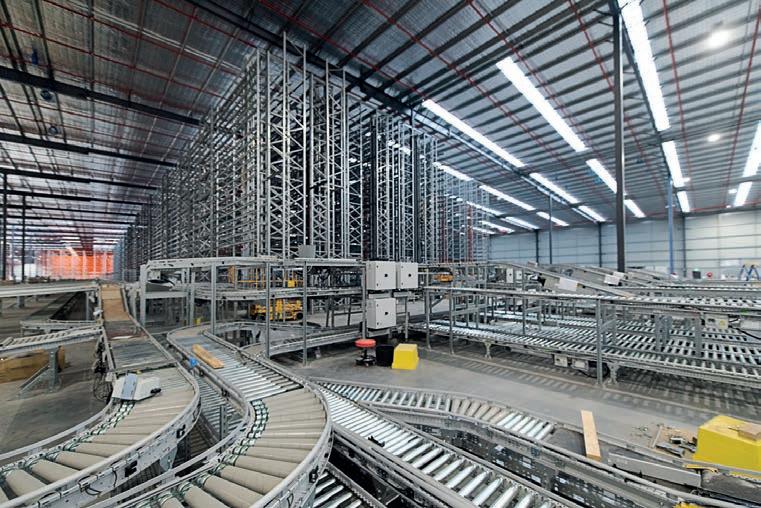
“The Goods-To-Person [GTP] system is a game-changer, handling a large number of SKUs consolidated within one warehouse,” says Tim Heptinstall, Distribution Centre Manager for GPC Asia Pacific. “The system factors in data about the weight, size, and velocity of items, determining the most efficient distribution order.
“A generous proportion – about 70 per cent – of our volume will go through GTP, reducing wait time and increasing efficiency,” he says.
The GTP system also offers the flexibility of operating on a flexible amount of time during the day. With a range of 16 to 24 hours per day, the stations stay active without being limited by the cadences of the human eight-hour workday and accommodating flexible worker schedules. “People can work two hours, three hours, four hours, five hours, providing real flexibility for the workforce,” Tim adds.
The warehouse also utilises VNA (Very Narrow Aisle) racking at the back of the DC for slower-moving items. It’s a consolidated pick system, but unlike the GTP, it’s driven by value rather than volume.
“The VNA operation is at back of the warehouse, so we can zone the warehouse off to make the best use of space incorporating what needs to be near the dock doors and what needs to
be in the back,” Tim says.
DESIGNING DCS WITH DATA
Comprehensive data analysis and a unique approach to automation proved key in designing the layout and operations of the DC.
Jon Longbottom, Chief Supply Chain Officer at GPC, says, “We didn’t specify the type of system that we wanted to use. Instead, we consolidated all our operational data – including all delivery models to customers – and presented it to automation vendors. Among these vendors was Schaefer, who eventually helped to create the optimal solution for GPC’s business needs.”
GPC was supported on the property development side by LOGOS and on the supply chain consultancy side by TMX. Working together, they sifted through potential vendors until they landed on Schaefer to provide
optimised automation.


“The Schaefer system that we’ve currently got allows us a number of advantages,” says Jon. Key among these is space consolidation, housing up to 100,000 SKUs in the goods-toperson system in a relatively small footprint. More than space efficiency, the technology accelerates the processes of intake and distribution. “The most important thing is the ability to get the product in and out of that and to our customers very quickly.”
GOING FOR GROWTH
The Melbourne DC at Broadmeadows is a key part of GPC Asia Pacific’s ambitious growth plans.
“Our business certainly has plans to grow from where we are now exponentially over the course of the next three or four years,” Jon says. This facility, he says – with its growth
MHD AUGUST 2023 | 63 MHD WAREHOUSING
GPC was supported on the property development side by LOGOS and on the supply chain consultancy side by TMX.
capabilities stretching over the next 10 to 15 years – forms a crucial platform for such an expansion.
“Previously, we didn’t have a replenishment facility in Melbourne, so we actually replenished Melbourne from Adelaide,” Jon says. “With the new distribution centre now servicing Victoria, Tasmania, South Australia, and the Northern Territory, GPC Asia Pacific is fortifying its logistical network and improving its ability to efficiently reach its customers in these regions as well as reducing kilometres travelled.”
Setting up the Melbourne DC at Broadmeadows, like any large-scale project, was not without its hurdles. “We built this facility during COVID,” Jon explains. “So, you can imagine the challenges associated with the supply of materials like steel, wood, semiconductors, all the component parts that came from Europe and Asia.”
Despite these obstacles, the GPC team, along with its partners, managed to stay on course. “Despite all that, we’re pretty much on time, and despite a few increases in international freight charges, we’re pretty much on budget,” Jon reports, attributing this success to the collective efforts of LOGOS, Schaefer, and GPC. He further emphasises that GPC’s extensive international shipping capability played a significant role in the project’s success. “Globally, we managed to collaborate with Schaefer and with our other partners to ensure we had a robust process to get the products into Australia on time
and on budget.”
The effort has certainly paid off. Tim says the consolidation of operations is radically streamlining processes and enhancing efficiency.
“By consolidating into this format for GPC, the benefits become selfexplanatory,” Tim says. “We have a longer working day available to us. We have a multi-task workforce that can move between business units, which means you can adjust according to the seasonality of things.
“GPC can now better optimise our workforce deployment, adapting to peaks at different times of the week, the day, the season, the year.”
Jon underscores the significance of this consolidation. “This is the first time we’ve consolidated our motorcycle division with our automotive division under one distribution footprint,” Jon states. This facility will now be distributing to all 27 AMX stores across the country, as well as to GPC’s wholesale customers and retail stores, including Repco & Napa stores across South Australia, Victoria, Tasmania, and the Northern Territory.
HAPPY CUSTOMERS
The Melbourne DC at Broadmeadows’ positive impact on GPC Asia Pacific’s store network and customer experience is undeniable. The benefits derived from the facility’s state-of-the-art systems and consolidated operations will directly translate into improved service to the end consumer.
“By having a longer working day and the fit-for-purpose facility,
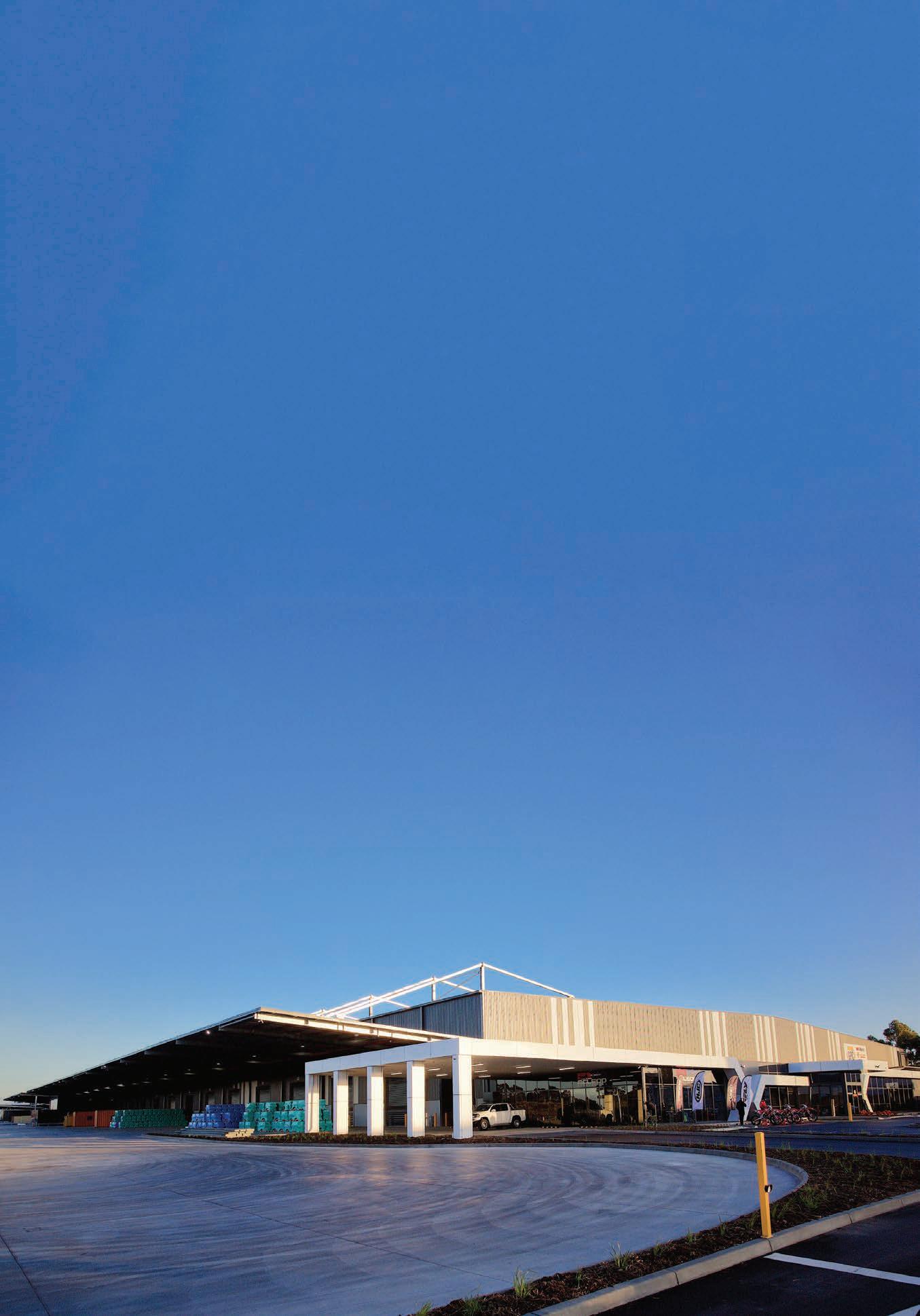
we’re able to fulfill all our orders straightaway and are also able to process international containers straight from the docks much quicker,” Tim says.
This efficiency in handling incoming stock translates to faster turnaround times and quicker deliveries to customers.
“We’re getting the product out quicker to the customer. If we give that confidence to the buyers and merchandise teams further upstream that we can keep that momentum going, then their buying power changes too, as their lead times change.”
“For the customers in this part of the world, it means quicker and more efficient service, and that should translate all the way down to the actual end user or consumer,” Jon says.
The Melbourne DC at Broadmeadows stands as a significant investment in the future of the automotive aftermarket, streamlining not only GPC’s operations but also – most importantly – the speed and quality of service to customers.
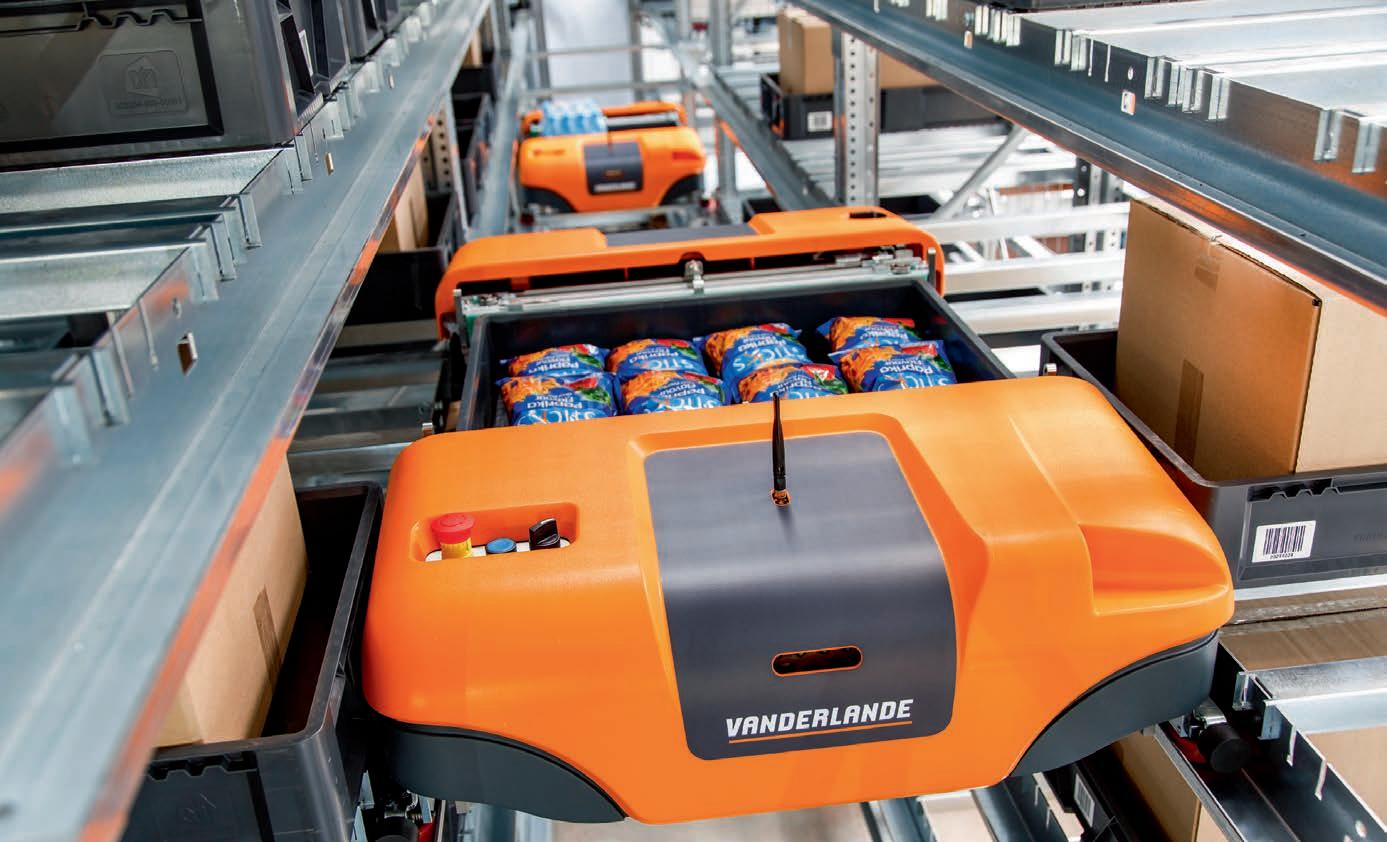
“Now, with the advent of this new DC, when a person takes their vehicle to the local mechanic, we can push the product out to the local mechanic – as well as our larger contract customers and to the consumer more broadly – at greater speed.
“At the end of the day, it’s all about faster and better service. That’s what GPC’s new Melbourne DC at Broadmeadows means for our customers.” ■
64 | MHD AUGUST 2023
MHD WAREHOUSING
The benefits of the Broadmeadows DC’s state-of-theart systems and consolidated operations will directly translate into improved service to the end consumer.


FASTPICK
operator efficiency and easily scalable for unpredictable growth Through multidirectional movement and sequencing, Vanderlande’s shuttle-based automated storage and retrieval system (AS/RS), ADAPTO, delivers goods fast and accurate in the appropriate order, enabling same-day deliveries. Learn how Vanderlande customers benefit from FASTPICK to efficiently handle both their e-commerce and store orders. > vanderlande.com Learn more:
High
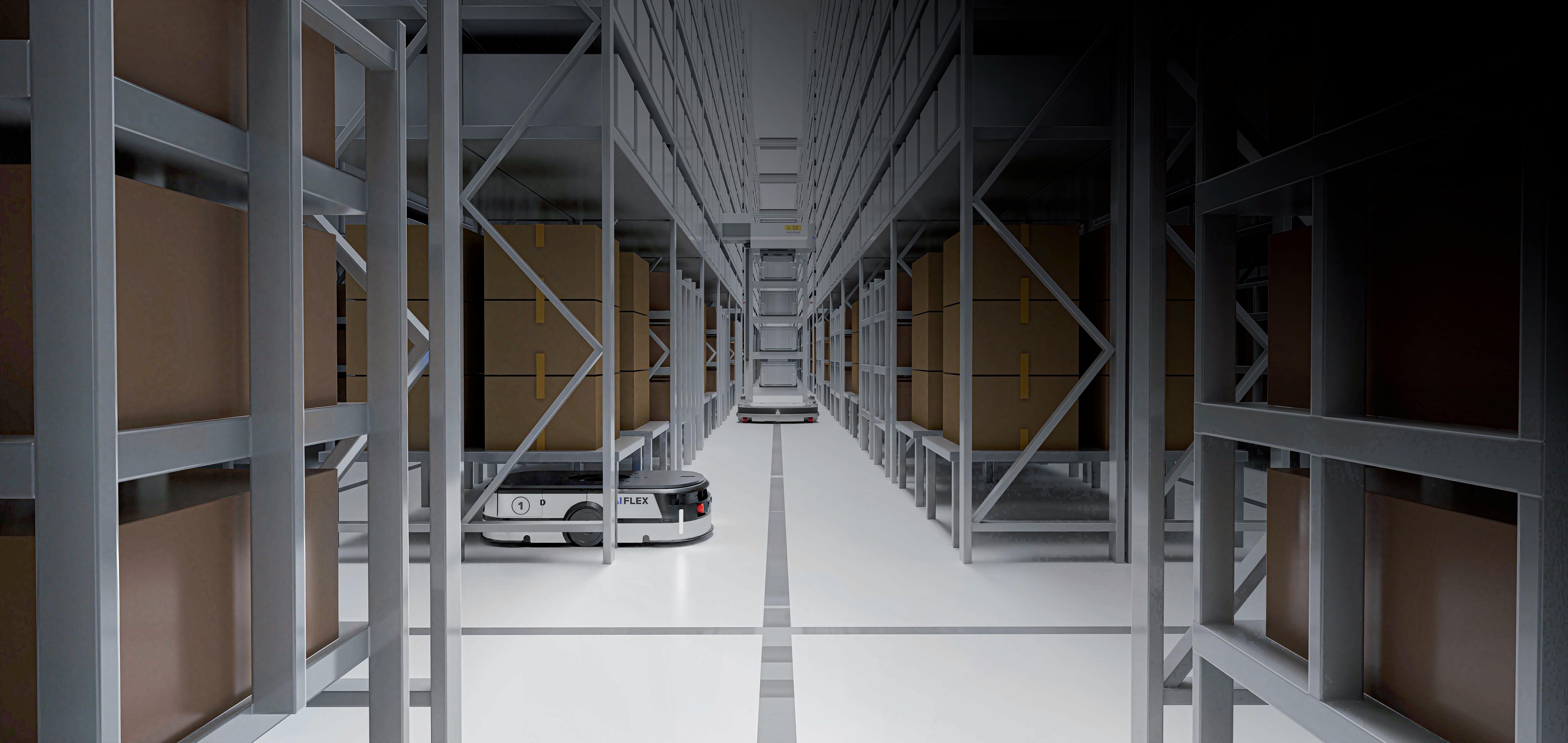


UNVEILING THE LATEST AUTOMATION COMBO WITH HAIPICK AND HAIFLEX Unit 10, 43-51 College Street, Gladesville, NSW, 2111 Australia www.hairobotics.com Scan to learn more and book a personalised demo

As ADAPTO links to a single order picking station, it forms part of a total solution, FASTPICK, that steers towards delivering in full sequence to a pick station.
Having a solution built around ‘lean’ infrastructure is also beneficial, and the strength of ADAPTO is that sequencing and sorting capabilities are in-built without having to install additional equipment later.
ADAPTO can also be scaled in throughput or storage locations independently. In terms of availability, each lift serves only one pick station, rather than all lifts being connected to all pick stations. Each storage location is also reachable by multiple shuttles.
These examples highlight the two single points of failures inherent to traditional shuttle systems, which are eliminated when using ADAPTO.
DRAWBACKS OF FOLLOWING THE ‘ABC’ METHOD
In traditional retail warehouse operations, stock can be divided into different categories based on demand. This is referred to as either the ‘Pareto’ or ‘ABC’ classification method, and encompasses fast- (A), medium(B) and slow-moving (C) SKUs.
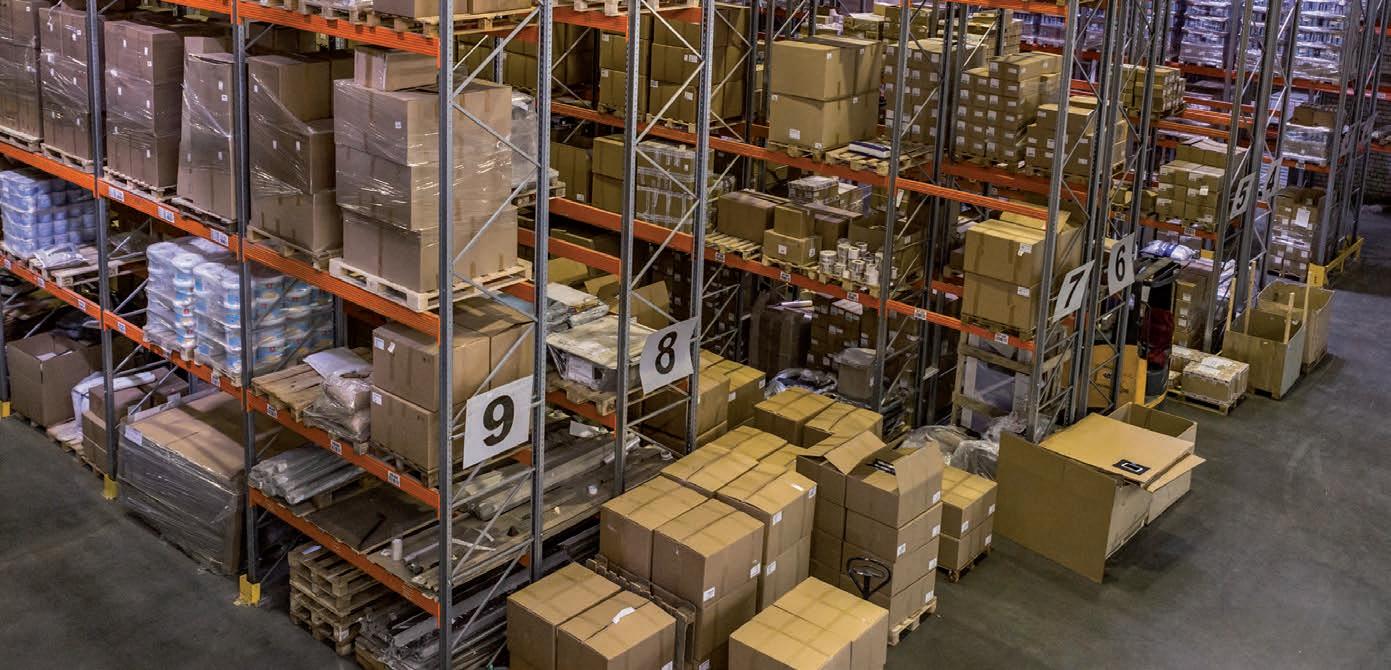
The main concern in the e-commerce market is that the
ABC method struggles to cope with unpredictability. For example, the ‘slow mover’ of today can easily become the ‘fast mover’ of tomorrow, and vice-versa.
The biggest drawback of solutions that rely largely on the ABC method – such as ‘cube storage’ systems – is that they soon become ineffective if there are changing item profiles. The methodology is only supportive if a company is handling fixed profiles.
In addition, totes inside this dense storage concept are not directly accessible at the surface and are therefore time-consuming to retrieve.
ROOM FOR MANOEUVRE
Another disadvantage is that shuttles only manoeuvre on a single plane and are not fully 3D like ADAPTO shuttles. This means cube storage only works when there are a minimal number of shuttles (throughput) compared to totes (storage volume).
There is also a question about scalability when it comes to matching future demand – particularly if warehouse space is at a premium. With FASTPICK, ‘fast movers’ do not need to be kept in a designated area, because the shuttles permit access to any product tote at any time.
For these reasons, it is better to
invest in a solution that does not rely heavily on the ABC methodology. Indeed, the method is obsolete with automation that offers immediate access to all locations.
A PLATFORM FOR THE FUTURE
It’s hard to predict what will happen in the future, but when market behaviour changes, it should be accommodated by an AS/RS solution such as FASTPICK. In an ever-changing world, the real value for a warehousing company is in securing a partner that can grow alongside it and understands the complexities of solution design.
Vanderlande is that partner with extensive experience in FASTPICK solutions including ADAPTO for the Fashion, General Merchandise and Parts & Components sectors, and is working on various projects in Australia at the moment that includes this technology.
That same ADAPTO is also part of STOREPICK solutions for the FOOD industry. In an unpredictable world, setting a platform for the future is more important than ever, and retaining as much flexibility as possible results in scalability and peace of mind. ■
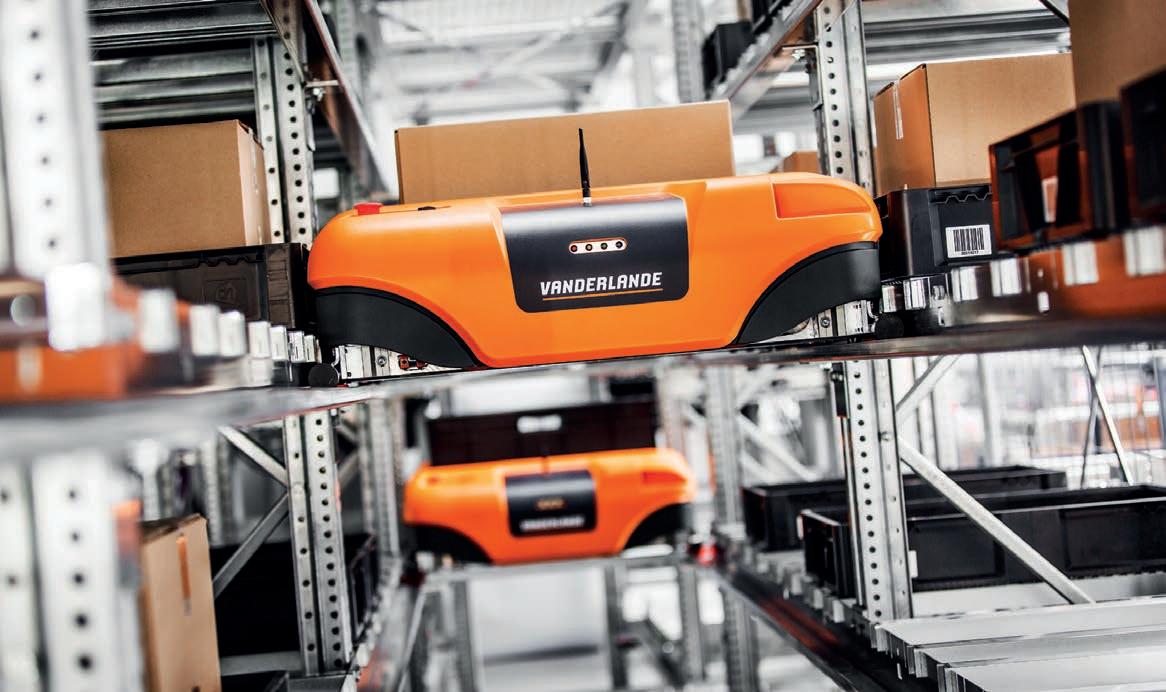
68 | MHD JULY 2023 MHD WAREHOUSING
Watch the
The strength of ADAPTO is that sequencing and sorting capabilities are in-built without having to install additional equipment later.
No obligation, FREE Site Survey to identify the best solution for your application. Wide range of Articulated Forklifts available. Maximise storage, efficiency and safety of your warehouse operations.

www.bendi.com.au
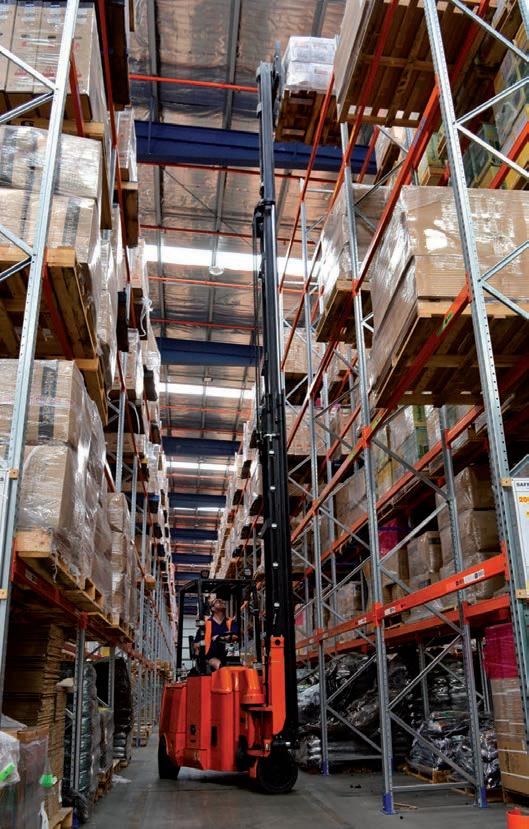
Bendi
With warehouse space at a premium, making the most of your current space is essential.
•
Watch the Bendi in action • •
•
Increase storage or floor space by up to 50% in your existing building without the need for costly extensions.
SCAN HERE TO GET YOUR FREE TICKET
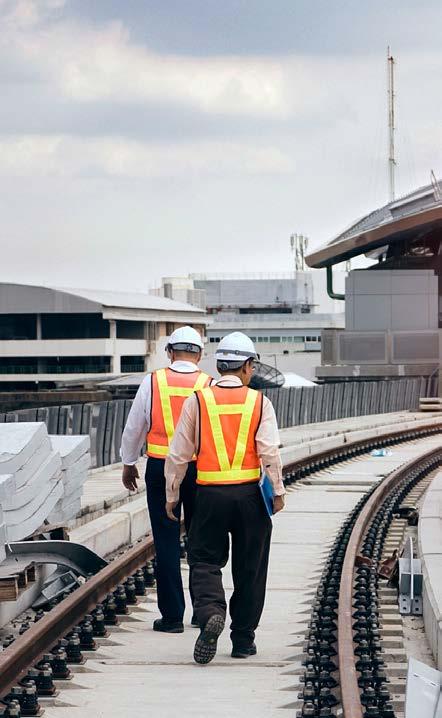
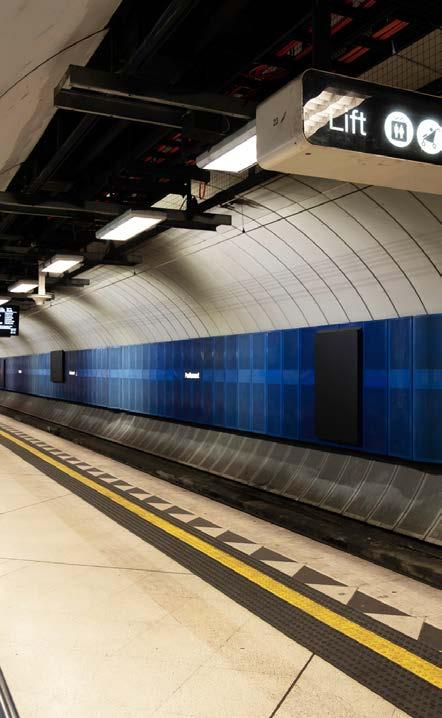
SUPPORTING SPONSOR

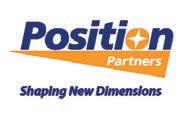
CONFERENCE SPONSORS

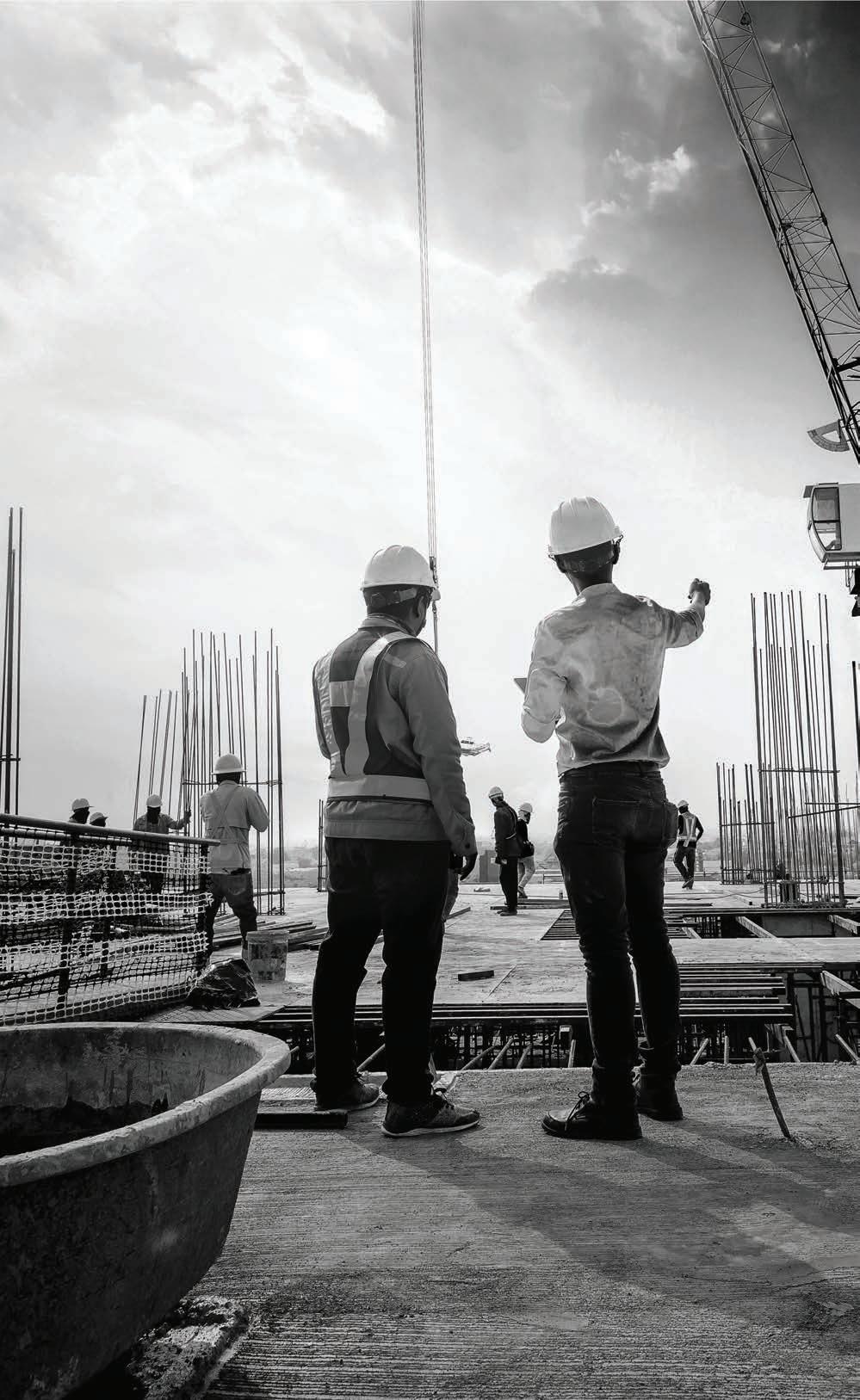






insideconstructionexpo.com.au/register Visit Melbourne’s leading construction and major infrastructure event Featuring: 15,000sqm of trade show, showcasing the latest innovations for the construction sector 150+ speakers across four stages discussing • health and safety • recruitment, careers and training • digital connectivity • construction productivity • sustainability • major projects
GET YOUR FREE TICKET NOW
ASSOCIATION PARTNERS
20-21 Sept 2023
Melbourne Convention and Exhibition Centre
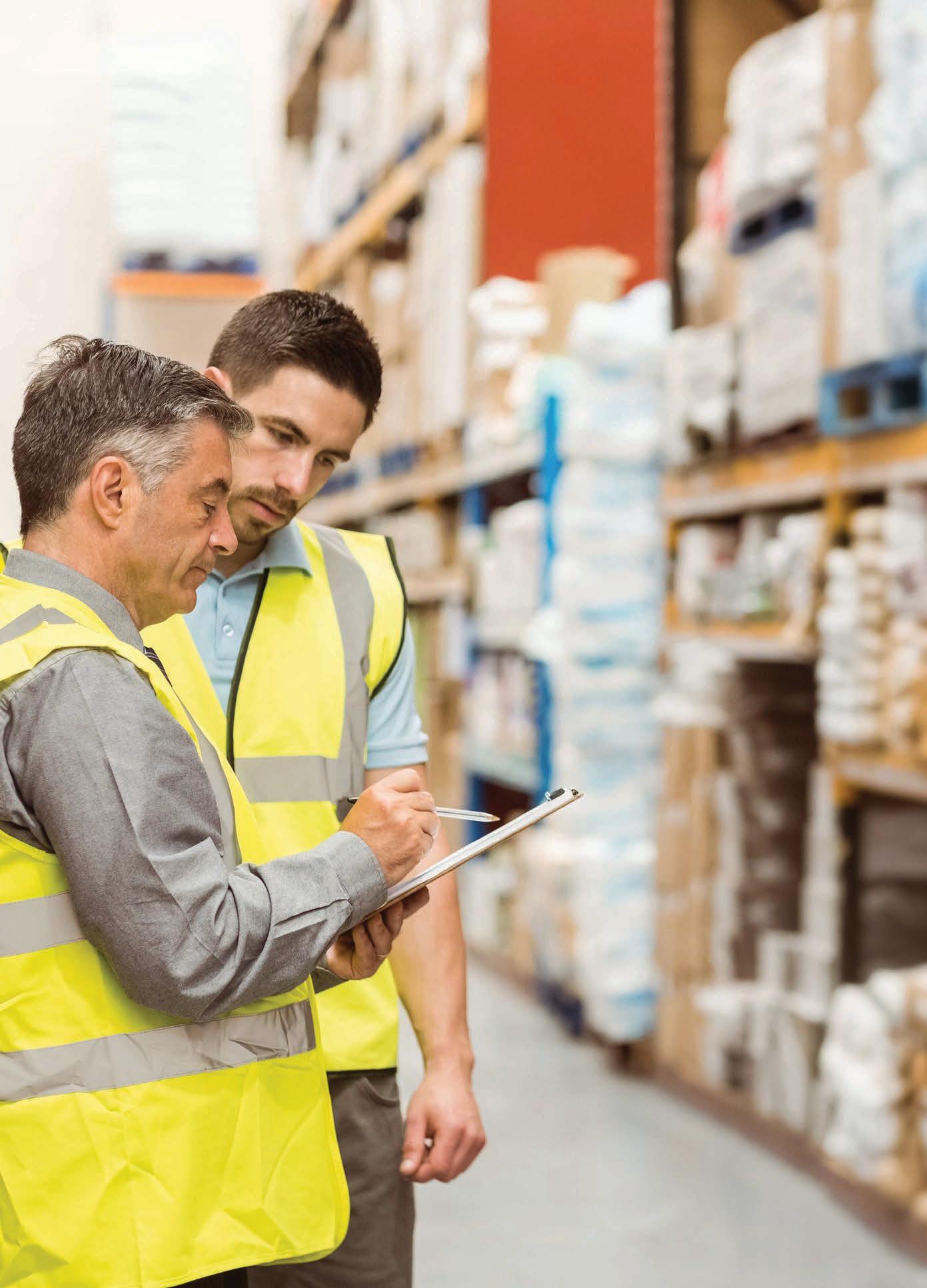
AUSTRALIA’S FIRST EVER ONLINE PORTAL DEDICATED TO BUYING, SELLING, AND HIRING LOGISTIC & INTRALOGISTICS EQUIPMENT. From mining companies looking to upgrade their portable generators, to waste treatment centres looking to hire a fleet of forklifts, MHD Marketplace will be the one-stopshop for equipment to support supply chains across Australia. For advertising opportunities, contact ben.coleman@primecreative.com.au or call 0466 545 664 BUY. SELL. HIRE. Scan the QR code to find out more.
MARKETPL ACE
ENTER THE BOT-VERSE
In a remarkable feat, Addverb, a leading global robotics and automation company, achieved a significant milestone as the company inaugurated its state-of-the-art manufacturing facility called “Bot-Verse” in Greater Noida, India. MHD finds out the details on what this means for the global robotics manufacturing giant as it sets its sight on further global expansion.
The factory, constructed in a record time of one year with a remarkable investment of 30 million USD, marks a significant milestone for its global expansion plans. With a sprawling area of 60,700 square metres, Bot-Verse is positioned to become one of the world’s largest mobile robot manufacturing factories, an exciting development with positive ramifications for the robotics industry, employment opportunities, and sustainability.
TRANSFORMING THE ROBOTICS INDUSTRY
Bot-Verse represents a significant stride in transforming the robotics industry. With its manufacturing capacity of
100,000 robots per year, the facility will cater to the increasing global demand for automation solutions. The diverse range of robots produced, including Autonomous Mobile Robot (Dynamo), Robotic Sorter (Zippy), Multi-Carton Picking Robot (Veloce), Carton Shuttle (Quadron), Pallet Shuttle (Cruiser), Vertical Sortation Robot (SortIE), Multi-Level Shuttle (Medius), and Collaborative Robots, will address various industry needs, spanning sectors such as e-commerce, logistics, manufacturing, and healthcare.
Addverb’s commitment to delivering cutting-edge hardware and software solutions ensures that the factory will be at the forefront of technological advancements, providing customers

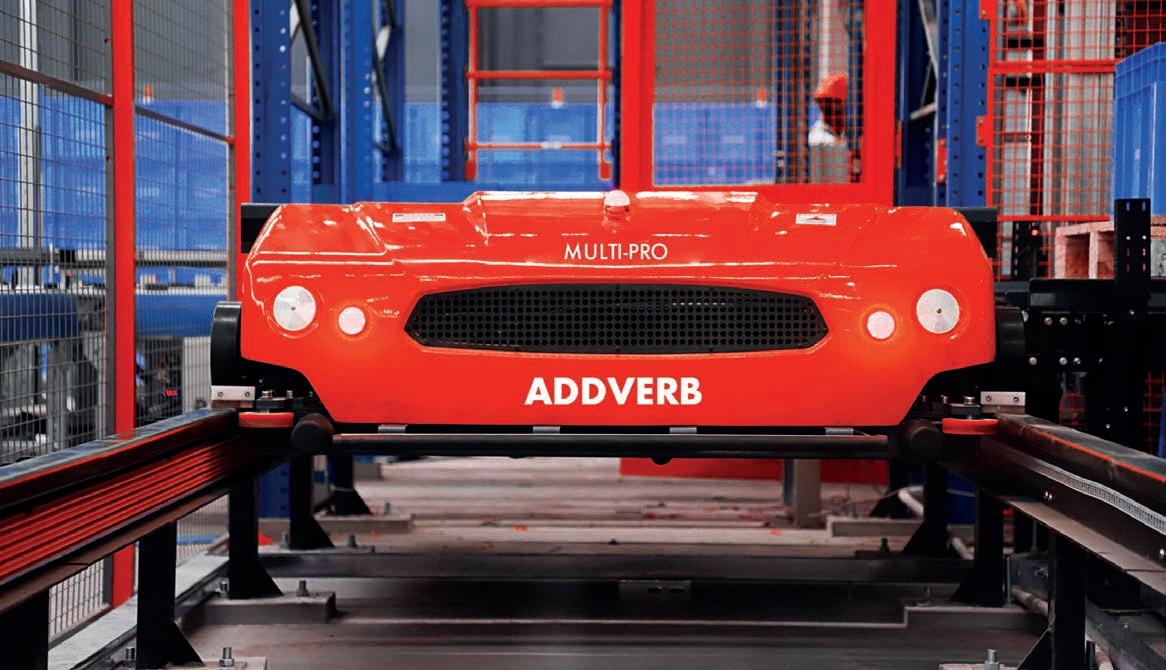
with innovative fixed and flexible automation solutions.
Moreover, the establishment of BotVerse is a testament to the Indian government’s commitment to fostering a favourable business environment and attracting investment. The ease of doing business reforms, along with initiatives to improve infrastructure and logistics, contribute to making India a competitive destination for global companies seeking to expand their manufacturing operations.
FOCUS ON EMPLOYMENT AND SKILL DEVELOPMENT
In addition to its impact on the robotics industry, Bot-Verse will generate more than 3000 highly skilled jobs,
MHD AUGUST 2023 | 73 MHD SUPPLY CHAIN
Addverb has already established a strong presence in the global robotics market.
contributing to the socioeconomic development of the region. By providing employment opportunities to the youth of the nation, Addverb aims to harness local talent and expertise, fostering innovation and technological advancements within India. These skilled jobs will not only elevate the workforce but also contribute to the growth of the local community, stimulating economic prosperity and social well-being.
As part of the giant leap undertaken by Addverb in establishing Bot-Verse, the company will dedicate efforts to collaborate with local educational institutions to tap into their talent pool. Such collaborations will provide the company access to a pool of motivated and qualified individuals who would contribute to the company’s growth and technological advancements. By actively participating in the state’s Chief Minister internship or Prime Minister internship schemes, Addverb will continue to attract young talent and offer them valuable work experience in their manufacturing facility.
The active measures that Addverb is set to undertake to collaborate with educational institutions and engage with government schemes marks a big step for the company towards a forward-thinking approach to talent acquisition and youth empowerment. Through active higher-education
support and participation in internship schemes, Addverb endeavours to empower individuals and foster a culture of continuous learning and skill development. This alliance between the company, educational institutions, and the government will set the stage for Bot-Verse to become a beacon of skilled talent and a thriving ecosystem for technological innovation.
SUSTAINABLE MANUFACTURING PRACTICES
Bot-Verse sets a new standard in sustainable manufacturing practices. The factory’s green cover of 20,000 square metres showcases Addverb’s commitment to environmental safety. It includes a micro forest area of 900 square metres, which will house over 100 native species, promoting biodiversity conservation. Furthermore, the bio-retention pond, with its capacity to harvest 800 kilolitres of rainwater, not only reduces water waste but also serves as a habitat for flora and fauna. By incorporating sustainable design principles, Bot-Verse showcases the company’s dedication to minimising its ecological footprint and contributing to a greener future.
GLOBAL EXPANSION AND FUTURE PROSPECTS
Addverb’s plan for global expansion further strengthens with the
establishment of Bot-Verse. With its headquarters and manufacturing facilities in India, as well as research and development centres in both India and the US, Addverb has already established a strong presence in the global robotics market. The company’s subsidiaries in Dubai, Australia, Singapore, the Netherlands, and the United States have allowed it to serve a diverse range of international clients. With Bot-Verse’s manufacturing prowess and capacity, Addverb is set to consolidate its position as a global leader in robot manufacturing while continuing to develop innovative software and hardware solutions to meet evolving industry demands.
The inauguration of Bot-Verse is a significant milestone for Addverb and the global robotics industry. With its world-class manufacturing capacity, sustainable practices, and emphasis on employment and skill development, the facility promises to reshape the landscape of robotics automation. The company’s dedication to technological advancements, customer satisfaction, and global expansion positions the company as a key player in the robotics industry. As Bot-Verse pioneers the manufacturing of mobile robots, it paves the way for a future where automation plays a pivotal role in driving efficiency, productivity, and sustainable development. ■

74 | MHD AUGUST 2023 MHD SUPPLY CHAIN
Bot-Verse represents a significant stride in transforming the robotics industry.
Industrial Real EstateIndustrial Real Estate









everyone is moving forward together, then
care of
At Leedwell, our team work proactively together to support and partner our clients in achieving their property needs. Henry Ford’s words resonate with our philosophy of achieving results for our clients. Experience our approach to property. leedwell.com.au → Leasing & Sales → Investment Sales → Development Expertise → Asset & Property Management RLA
If
success takes
itself” - Henry Ford
222531 Steve
Smith
Partner 0410 532 022 steve.smith@ leedwell.com.au Andrew
Gerlach
National Director 0410 312 116 andrew.gerlach@ leedwell.com.au Renee Ferraro Senior Executive 0490 865 820 renee.ferraro@ leedwell.com.au Will
Goode
Senior Executive 0430 407 793 will.goode@ leedwell.com.au Anthony
De Palma Senior Executive 0423 568 771 anthony.depalma@ leedwell.com.au
Henry Treloar Director Industrial 0412 404 426 henry.treloar@ leedwell.com.au Jamie
Forwood Senior Executive 0450 959 032 jamie.forwood@ leedwell.com.au
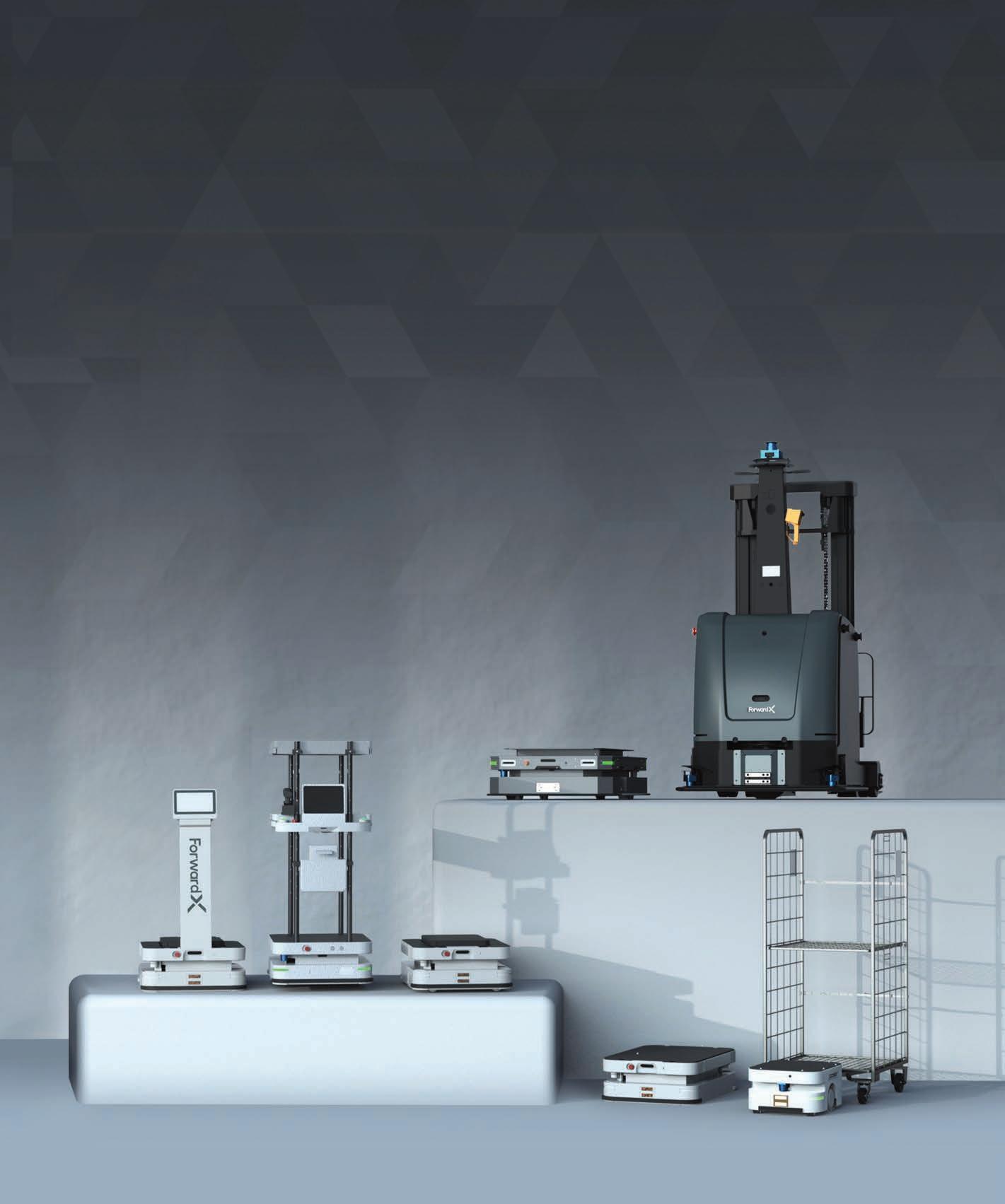

MOVING REFRIGERATED GOODS WITH HUBTEX’S BENDI
Bruce Peatman, Managing Director at Hubtex Australia, tells MHD all about the materials handling company’s Bendi Articulated Forklift, which can increase storage capacity plus save time and money in cold storage facilities.
Hubtex is no stranger to dealing with the cold chain sector. Over the past 20 years, it has been providing unique materials handling solutions to operate in challenging cold store freezer environments. Its range of Bendi Articulated Forklifts and Very Narrow Aisle machines can operate in cooling rooms with temperatures of minus 30 degrees.
Cold storage facilities by nature are expensive to build and operate, especially as the cost-of-living crisis continues, and the effects of increasing inflation and interest rates are felt worldwide.
As these energy, land, and labour costs rise, refrigerated warehouse and DC owners are looking for ways to maximise their cubed capacity with dense storage. The versatile Bendi Articulated Forklift operates in aisle widths similar to turret trucks but doesn’t require special floor flatness or expensive wire guidance.
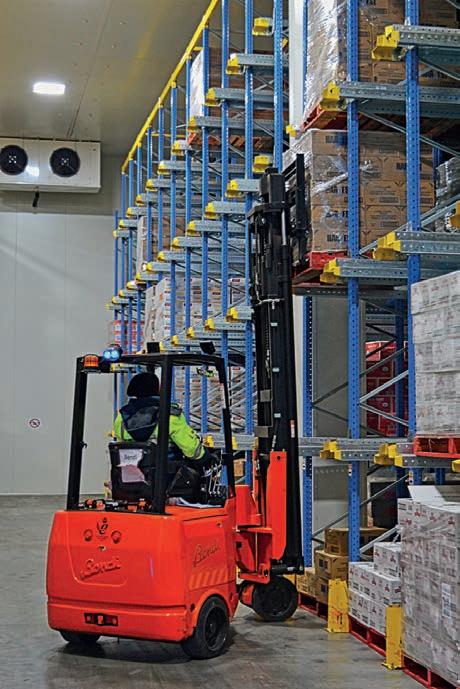
By reducing the aisle sizes in a warehouse, from a 3300mm clear aisle with a typical reach truck, to 1800mm clear aisle, operators can potentially fit 30 to 40 per cent more products within the same cubed area or reduce the storage space required. In a cold store this results in significant cost reduction, saving a business money.
BENEFITTING FROM BATTERY-RUN SOLUTIONS
Freezer room facilities need clean, low emission handling equipment.
Battery-powered electric forklifts like Bendi provide this with the use of energy efficient AC technology which help extend battery life in these low temperatures.
Hubtex uses the latest Curtis Electronics controllers, which are the most efficient on the market, and don’t affect the regulated temperatures in the freezers. It mainly uses lead acid batteries and some lithium-ion batteries –with none of these causing heat generation.
“There are multiple benefits to using battery-electric machines like the Bendi Articulated Forklift,” explains Bruce Peatman, Managing Director at Hubtex. “The equipment has low operating costs; a longer life and the batteries are recyclable.
“The batteries we use in our materials handling solutions are recycled by the manufacturer in Germany, and this is part of our effort to contribute to our sustainability goals. While we source some of the components used to build our machines from smaller, bespoke manufacturers – most are from the industry’s major players.”


In cold storage facilities, Hubtex uses special hoses and freezer-compatible lubricants and oils. Bendi Articulated Forklifts have low temperature specific components specific to cold store environments to protect the forklift without impacting the refrigerated environment.
DELIVERING SAFETY THROUGH DESIGN
Key features of the Bendi are designed with safety in mind. Bendi’s unique twin rear wheel drive has been developed to ensure traction and braking is optimised in slippery or icy conditions, minimising the risk of accidents or damage to products and racking. “Unlike other forklift types, the Bendi has soft compound rubber tyres which results in higher grip –further improving safety,” says Bruce.
MHD AUGUST 2023 | 77 MHD MATERIALS HANDLING
The Bendi Articulated Forklifts are designed to operate in cool rooms with temperatures of minus 30 degrees.
Driving a Bendi is very intuitive, and with all the truck’s movement occurring in front of the operator, safety is greatly improved compared to most other forklift types. The Bendi doesn’t need to turn through 90 degrees so there is no ‘rear end swing’ which reduces the risk of damage to product and racking.
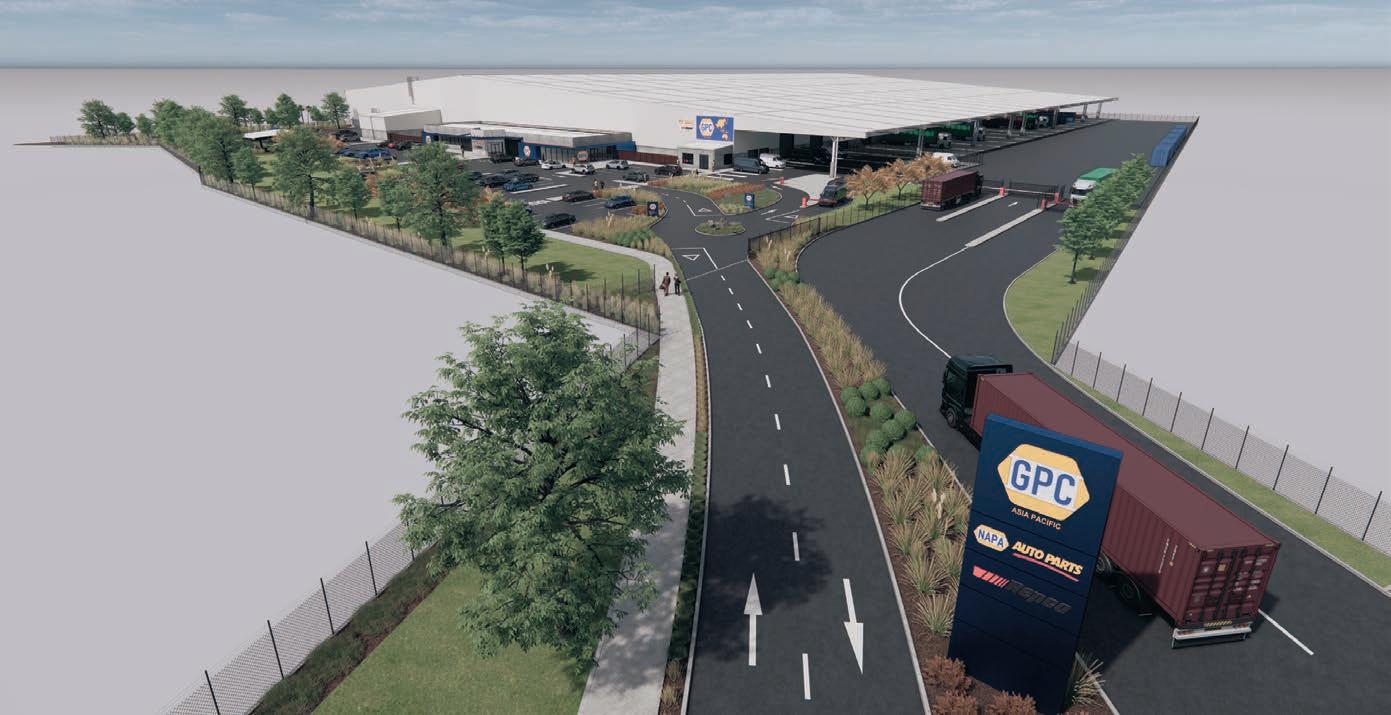
The front mast assembly is the only part of the forklift that turns giving the operator clear visibility of the load because it is handled to the side of the forklift, unlike other forklift types
where the operator is looking through the mast. Whilst forklift operators are soon at ease working at heights of nine metres plus, for taller lift heights visual aids such as cameras are available.
For lower height storage areas another Bendi machine that Hubtex offers is capable of driving into the back of a truck or a container then straight into a cool room and lift it up to 6.3 metres in height. This is ideal for smaller facilities where it isn’t possible to have too many machines in the limited space.
SERVICING AND SUPPORTING NATIONWIDE
Hubtex offers 24/7 after sales and service support to its customers. Where Bendi Articulated Forklifts are operating in harsh freezer environments, having a strong support service is paramount.
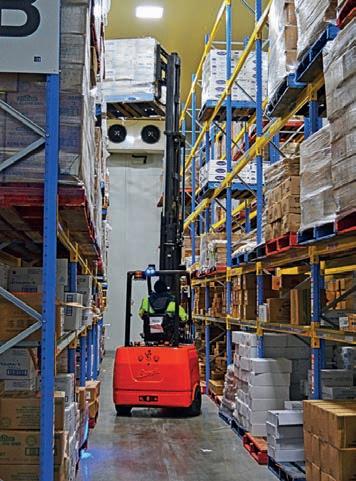
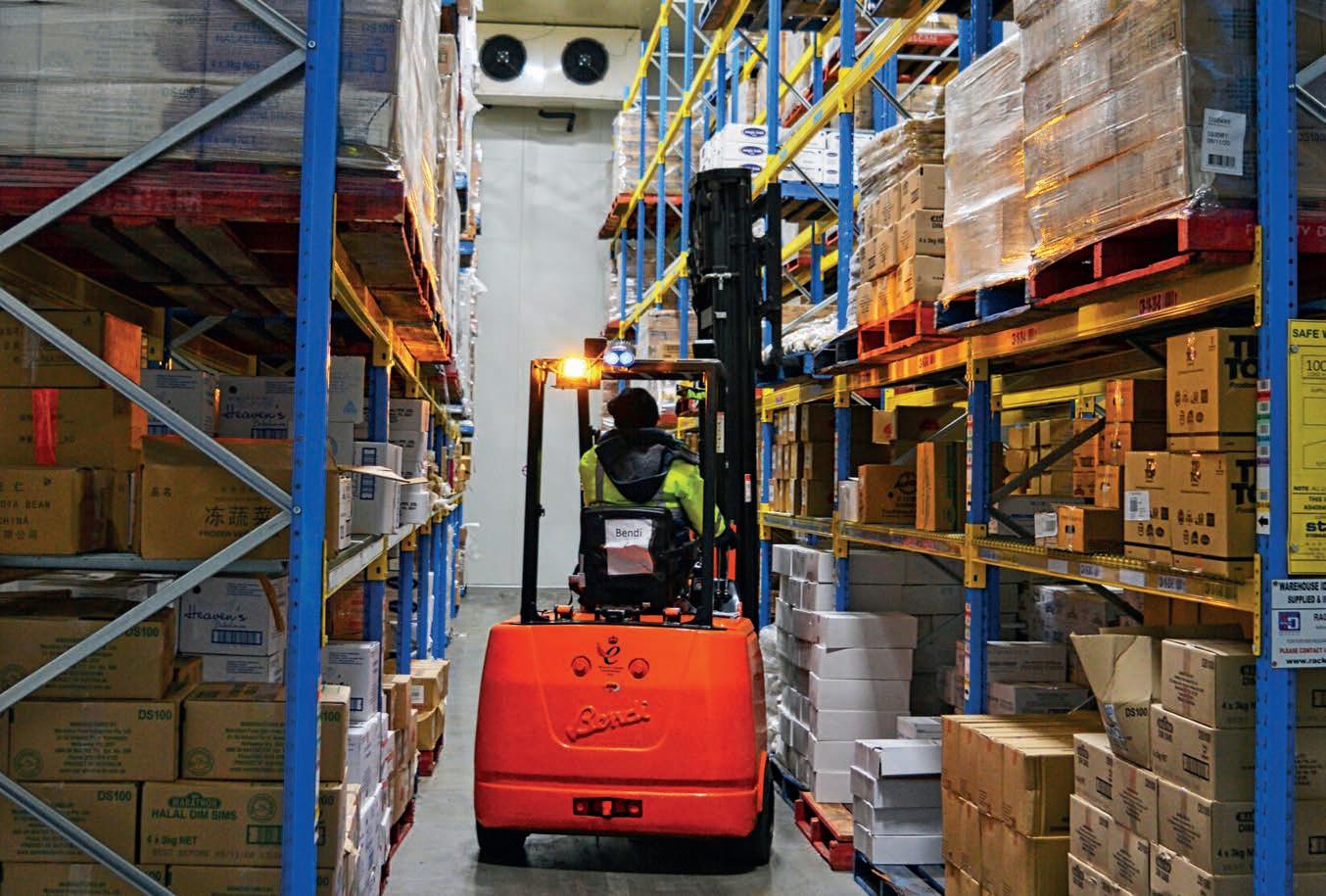
Spare parts are readily available to replace faulty or worn-out components. As a specialist in narrow aisle forklifts, the company’s technicians are highly trained to deal with any eventuality from Hubtex-owned facilities in Sydney, Melbourne, Perth, Adelaide, and Brisbane.
“It’s in our core philosophy – to ensure our after sales support is on standby,” notes Bruce. “Being a specialist supplier of Bendi articulated forklifts we can deliver a rental replacement at short notice if a machine breaks down.
“Our technical support networks are well developed in Australia. Senior technical specialists from our branches in the major Australian capital cities provide support to technicians any time of the day or night. Service partners are used in areas outside the major cities to assist customers with warehouses and DCs in rural and regional areas.
“Periodically throughout the year, we’ll go out to the facilities that are far afield and work with the local service partners to ensure that they’re servicing the equipment to the manufacturers requirements and to give them further training.
“Some technicians will spend a day or two travelling around, servicing the areas. It’s important to us that the level of preventative maintenance service on our machines is kept to a high standard that results in fewer breakdowns in the future.”with warehouses and DCs in rural and regional areas. ■
78 | MHD AUGUST 2023
In cold storage facilities, Hubtex uses special hoses and freezercompatible lubricants and oils.
MHD MATERIALS HANDLING
Key features of the Bendi are designed with safety in mind.
DRIVING AN INNOVATIVE FUTURE
At GPC, the leading AU & NZ automotive business, we are investing in state-of-the-art supply chain solutions to house our iconic brands such as Repco, AMX, Rare Spares and NAPA.
Leading the industry requires leading technology, that’s why we’re building a brand-new Distribution Centre. Featuring cutting edge technology and operations, the development will back a growing product range, advancing the store network and supporting Australian motorists into the future.

• 39,000 square metres of warehouse space
• State-of-the-art technology
• Faster, more accurate service for customers

• Improved distribution efficiencies
• Employment opportunities
• 5 Star Green Star Communities rating
gpcasiapac.com
INSIDE CONSTRUCTION EXPO SET TO BE LANDMARK EVENT
Melbourne’s premier construction and infrastructure event, Inside Construction Expo 2023, will amplify the transformation of the commercial and civil construction sectors. With excitement already brewing, it is time to plan your visit.
An event dedicated to major commercial and civil projects in the Australian construction industry, Inside Construction Expo is being held from 20 to 21 September 2023 at the Melbourne Convention and Exhibition Centre.
With a robust conference program featuring top-level speakers, a worldclass exhibition showcasing the latest equipment and technology, and the Inside Construction Foundation Awards celebrating talented industry individuals and businesses, Inside Construction Expo 2023 is a must-attend event.
Set to connect constructors with OEMs, sub-contractors, and operators, Show Director Lauren Winterbottom says the event is positioned to foster the successful delivery of projects in the pipeline.
“Inside Construction Expo was created to fill the gap in events targeted at major commercial and civil projects,” she says.
BACKGROUND FOR INSIDE CONSTRUCTION EXPO
In the 2022-23 Federal Budget, the Government increased its 10-year infrastructure investment pipeline to a record $120 billion. The 2022-23 Victorian Budget outlines $85.3 billion in general government spending on infrastructure over the next four years. Many projects are planned nationwide over the next decade, but considerable industry challenges remain. Inside Construction Expo 2023 will provide a platform to canvass solutions to the issues hampering the commercial and civil construction sectors.
With multiple stages across the event
focusing on Health, Safety and Wellbeing; Training, Education and Careers; Digital Transformation and Connectivity; and Construction Productivity, there will be a wealth of industry information and solutions.
“Throughout the conference, attendees can expect to hear from executive-level representatives from Australia’s major constructors and suppliers, alongside research and education bodies and government figures,” Lauren says. “The exhibition show floor will display the latest construction machinery and equipment.”
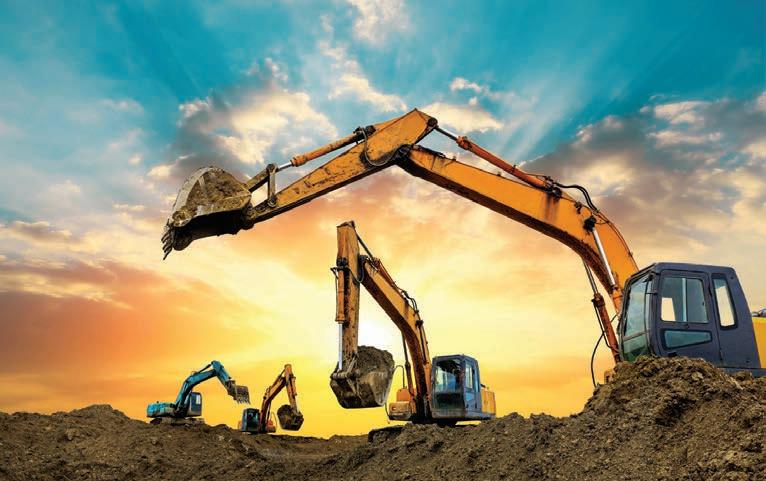
PARTNERSHIPS AND SPONSORSHIPS
Inside Construction Expo is backed by support from several valued organisations and media partners. Without this support, Lauren says, the event would not be possible.
“We’re pleased to partner with industry associations and peak bodies to bring Inside Construction Expo to life,” she says. “Specialist in assembly and fastening materials, Wurth Australia has come on board as a supporting sponsor for the Expo.”
“We are thrilled to be part of the 2023 Inside Construction Expo, which promises to be a game-changer for the industry. This event will provide an unparalleled opportunity for us to showcase our latest products and innovations, as well as to connect with fellow professionals and share insights and expertise. We look forward to a productive and inspiring event,”
80 | MHD AUGUST 2023 MHD EVENTS
Inside Construction Expo is being held from 20 to 21 September 2023 at the Melbourne Convention and Exhibition Centre.
says Serge Oppedisano, CEO of Wurth Australia
Lauren also points to intelligent positioning solutions provider Position Partners and manufacturer Komatsu as proud conference sponsors. In the lead-up to the event, over 19 industryleading publications continue to cover the latest in Expo news extensively.
“We have seen their coverage reach more than 80,000 decisionmakers across multiple sectors,” a spokesperson says.
“We’re excited to connect with delegates at Inside Construction in Melbourne this year. Events are experiencing a resurgence postlockdown, and nothing beats in-person conversations, especially when it comes to showcasing new technology!” says Gina Velde, Marketing and Communications Executive Manager of Position Partners.
Current association partners include The National Association of Women in Construction; The Working at Height Association of Australia; The Concrete Pumping Association of Australia; The Institute of Quarrying Australia; The Crane Industry Council of Australia; The Formwork Industry Association; Landscaping Victoria Master Landscapers; and The Piling and Foundation Specialists Federation.
INAUGURAL FOUNDATION AWARDS
As part of this year’s Inside Construction Expo, the Foundation Awards will be held on 20 September 2023 to celebrate the individuals, businesses, and projects championing transformation in the construction industry.
With a focus on showcasing the initiatives that seek to promote core standards around safety, diversity and environmental sustainability throughout
major and local projects, the Foundation Awards will be a premier event on the construction industry calendar.
The following awards will be given: The Rising Star of the Year category recognises an individual aged 35 years or younger at the date of nominations closing. They will have impressed their colleagues and counterparts with their contribution and impact on their organisation and excellence in service.
The Industry Leader Award recognises a leader who holds a senior position (executive, manager, director, or equivalent) in a private, not-for-profit, or government organisation. They must have effectively shaped their business’s success, delivered financial growth, significantly and positively impacted the business culture, and championed the industry widely.
The Woman of the Year category recognises a woman in the industry who has driven change and continues to do so. Their work is leading to progress in breaking down barriers and creating new career prospects for the next generation.
The Operational Excellence Award recognises an individual or team that has achieved demonstrable improvements in efficiency, best practice Occupational Health and Safety, and impeccable records.
The Sustainability Initiative of the Year category, sponsored by SAMI Bitumen Technologies, recognises a company with a product, technology, system, initiative, or project that has been developed. They could have carried out an innovative, environmentally focused, sustainable program to protect, preserve and/or rehabilitate the natural environment, contributing to decarbonisation and/or reducing waste and/or emissions.
The Safety Program Award recognises
a program, project, or initiative to promote and improve safety within a business or the broader construction industry.
The Technology Solution Award, sponsored by FRAMECAD, recognises a technology supplier to a construction business, equipment manufacturer or subcontractor. The winning solutions should improve a process, delivering tangible benefits across financial, safety or sustainability measurements.
The Major Project of the Year –Commercial category recognises the completion of a stage of a major vertical construction project or complete project delivery. It should have been delivered with a demonstrable budget, safety, social target, and sustainability results.
The Major Project of the Year –Government category recognises the completion of a stage of a state-funded project or complete project delivery. The project should have demonstrable budget, safety, social target, and sustainability results.

The Local Government Project of the Year category recognises the completion of a stage of a local government project or complete project delivery. The project should have been delivered with a demonstrable budget, safety, social target, and sustainability results.
PLAN YOUR ATTENDANCE
Whether you’re a project manager, superintendent or an engineer, all professionals in the field of construction are invited to attend Inside Construction Expo 2023. Registration is free for both the exhibition and the conference. You’re welcome to come and go as you please and curate a conference experience that suits you. ■
For more information, visit www.insideconstructionexpo.com.au
MHD AUGUST 2023 | 81 MHD EVENTS
As part of this year’s Inside Construction Expo, the Foundation Awards will be held on 20 September 2023.
PATHWAYS TO PROGRESS
At the recent Supply Chain and Logistics Association of Australia (SCLAA) event, “Pathways to Progress: Uniting Supply Chain Professionals for Career Growth and Connections,” leading figures in the industry engaged in an enlightening panel discussion. The dialogue centered around the pressing issues of workforce management, automation, diversity, and economic conditions, all of which are currently shaping the future of the Australian supply chain industry.
Moderated by Theo Pappas, Victorian
State President of the SCLAA, the discussion included contributions from Joe Sette, Managing Partner at Miller Leith, Michelle Arnold, Human Resources Manager at Saint-Gobain Abrasives, Phil Caris, VP Human Resources Asia Pacific at Lineage, and Dr. Hadi Ghaderi, Associate Professor at Swinburne University of Technology. One significant point of discussion was the evolving working conditions in the supply chain industry, including the potential for a four-day working week. Phil Caris of Lineage Logistics
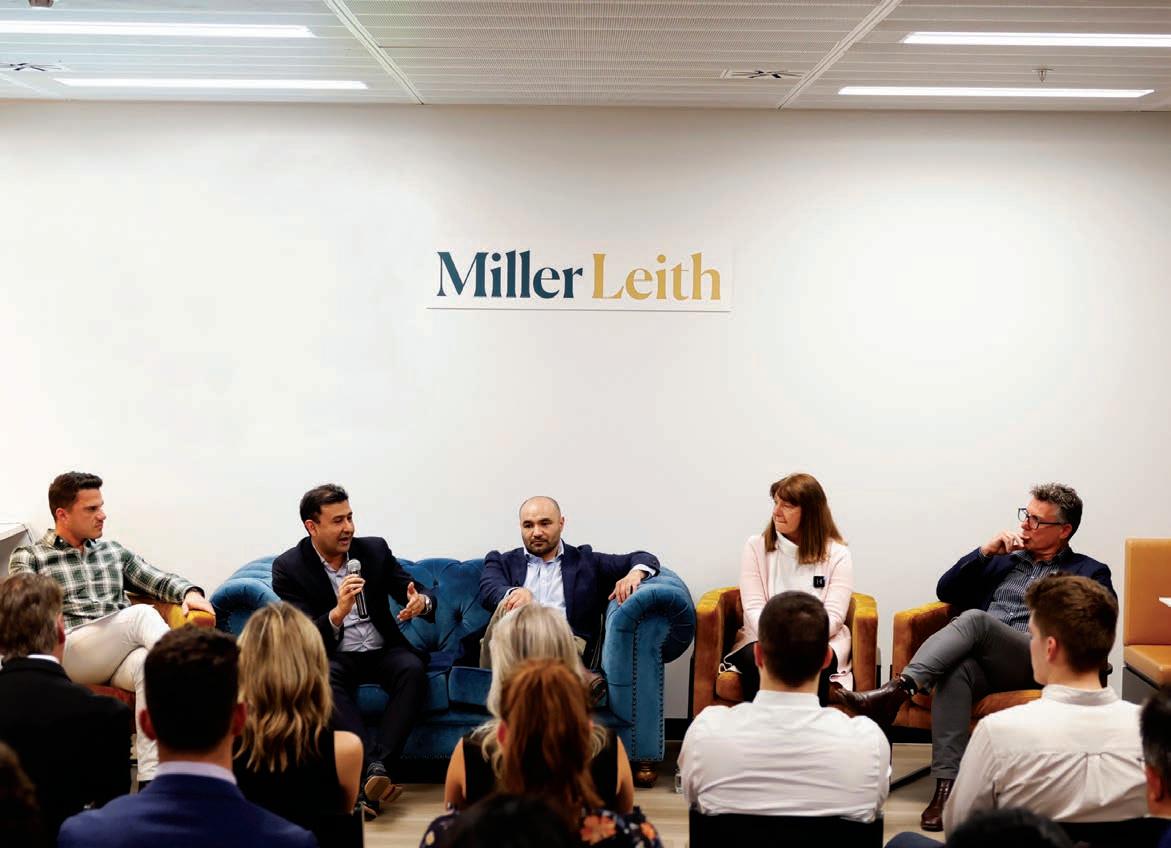
said their trial of this approach “greatly improved work-life balance,” leading him to believe this condition would become a permanent change. Echoing Phil’s sentiment, Joe Sette argued that a four-day week would “significantly boost the appeal” of businesses that adopted it early. In the academic arena, Hadi pointed out that the impact of this shift on supply chain productivity remained an intriguing point of consideration.
Another critical challenge the industry faces is attracting younger talent into
82 | MHD AUGUST 2023 MHD SCLAA
Leading industry experts shared their thoughts on the future of the Australian supply chain and logistics industry at a recent SCLAA event, discussing challenges and potential solutions to increase career growth and connections in this vital sector.
From left to right: Theo Pappas, Dr. Hadi Ghaderi, Joe Sette, Michelle Arnold, and Phil Caris.
operational roles. Joe stated the need to show millennials the potential for progression to incentivise them to enter the sector. Moreover, Hadi highlighted the importance of strategic partnerships between companies and academic institutions to develop the talent pipeline effectively.
In a rapidly evolving digital landscape, the panelists underscored the increasing importance of automation and robotics in supply chain operations. Michelle Arnold from Saint Gobain noted their output had significantly increased thanks to the replacement of outdated machinery with modern robotics. Yet, Phil Caris noted the labour shortage had forced his organisation to accelerate capital expansion plans despite automation’s challenges.
Addressing concerns over a potential skills gap as automation becomes more prevalent, Joe pointed to the growth of relevant university degrees such as mechatronics, robotics, and electronic engineering. He did, however, caution that a skills shortage may still persist for the next five years. Phil added an interesting note, discussing instances when traditional logistics knowledge became critical during system failures, emphasising the need for capacity planning and crisis management skills when automation fails.
The panelists also stressed the importance of broadening the employee value proposition to retain talent in a
competitive labour market. Flexibility, health and life insurance, and worklife balance emerged as key factors in addition to salary. As Michelle put it, “Let’s use flexibility as a tool.”
In terms of diversity, both Michelle and Phil agreed that flexible hours and a focus on skills, rather than gender as a sole criterion, were crucial to attract and retain more women in the industry.
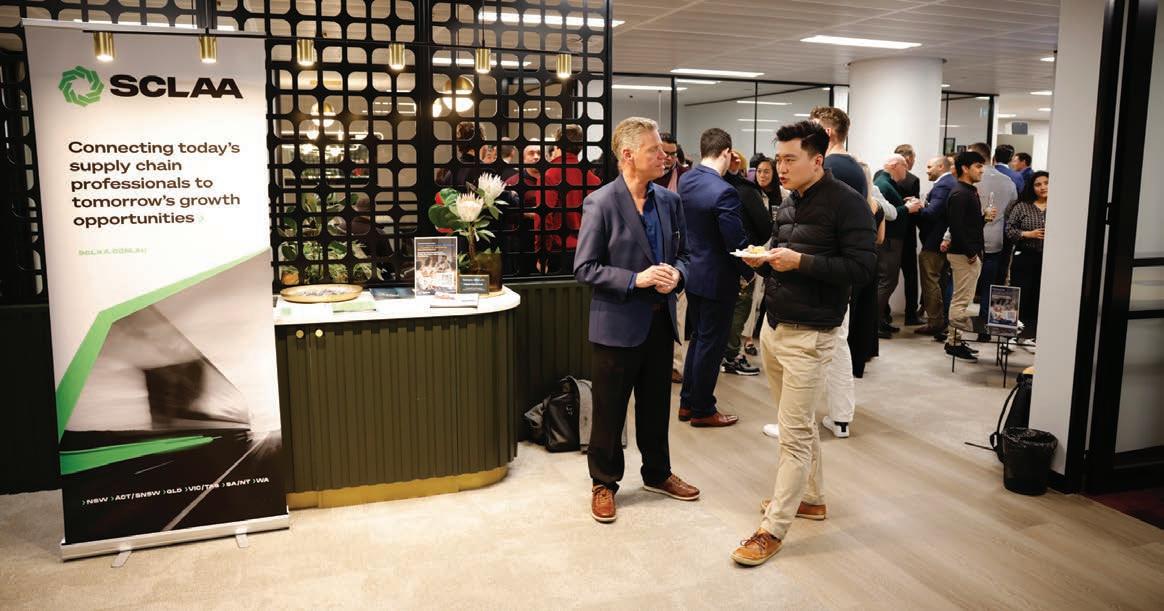
Discussing the in-demand roles and skills in the industry, Joe noted a keen interest in roles that can help reduce costs, while Michelle emphasised the importance of tradespeople for manufacturing facilities.
In closing, the panelists shared
their key takeaways. Phil emphasised adaptability and resilience, while Michelle underlined the importance of investing in people. Meanwhile, Joe reiterated the significance of a strong Employee Value Proposition that extends beyond salary.
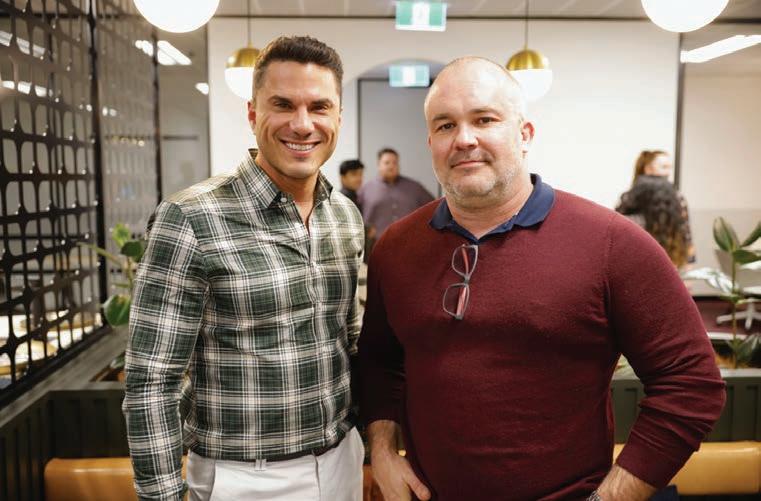
The insightful discussion at the SCLAA event underscores the dynamic nature of the supply chain and logistics industry and the need for innovation and adaptability to navigate future challenges.
Theo, concluding the discussion, noted the importance of SCLAA in promoting such discussions to help industry in their navigations. ■
MHD AUGUST 2023 | 83 MHD SCLAA
Attendees at Pathways to Progress enjoyed an evening of networking before the panel discussion.
Keep in touch with SCLAA for more exciting industry events.
HUBTEX SECOND GEN FLUX 30
HUBTEX’s FluX Electric Multidirectional Counterbalance Forklift Truck has had some significant and innovative updates. The latest generation has load capacities of up to three tonnes. It has a new central driver’s position, which provides a higher-up all-round visibility compared to its predecessor. Additionally, the patented 360° HX steering has been added to the compact three-wheel running gear for the first time, ensuring smooth changes in direction from longitudinal to transverse travel. It handles both pallet and long-load transport in a single vehicle. This hybrid used as a front and sideloader makes the new 3T FluX 30, suitable for a wide range of sectors, from the timber and metalworking industries, through to the building materials trade.

For more information visit www.hubtex.com.au
PROJECT44 OCEAN VISIBILITY
Poor ocean visibility puts a strain on global supply chains, logistics costs, and customer service. At the root of the issue is low-quality data that hinders personnel productivity, streamlined operations, and proactive exception management. Today, more than ever, shippers and 3PLs need global ocean visibility with the data quality, intelligence, ETAs, and proactive exception management that ensures efficient, costeffective, reliable, and sustainable global transportation. Project44’s Ocean Visibility solutions is here to help, with a suite of solutions that uses first-in-class data and analytics to improve personnel productivity, allow for proactive exception management, reduce logistics costs, improve customer service, and empower users for agile transport planning and procurement.
For more information visit www.project44.com
AUTOSTORE GRID AND VENDING MACHINE
Global cube storage company AutoStore introduces its latest capability, the Grid and Vending Machine solution, designed to simplify warehousing automation. The ConveyorPort is a workstation in its simplest form, where Bins are dropped on a conveyor and transferred to an opening outside of the Grid. Smart covering and sensors ensure operator safety. The CarouselPort is designed to work with the operator, in harmony with Robots to ensure the next Bin is always ready. The workstation operates with three rotating arms, each holding one Bin tray. The Vending Machine solution includes various Robots and chargers, as well as a dummy display unit, and a grid structure with 60 Bins.
For more information visit www.autostoresystem.com
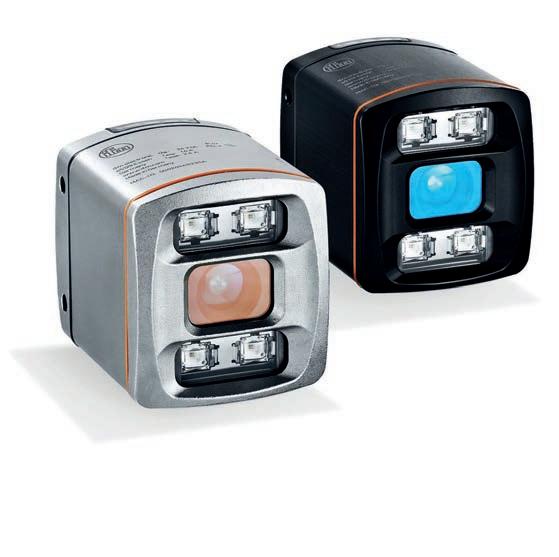
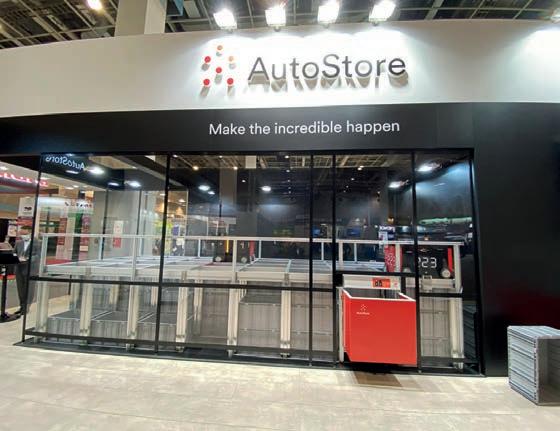
IFM’S TRACK AND TRACE GATE
ifm Track and Trace Gate is the complete solution for your automated and transparent logistics in your incoming and outgoing goods processes. By directly transferring all goods flows to the IT level, you can organise the inter-locking of production, inventory, and suppliers more efficiently than ever before.
For more information visit www.ifm.com/au/en
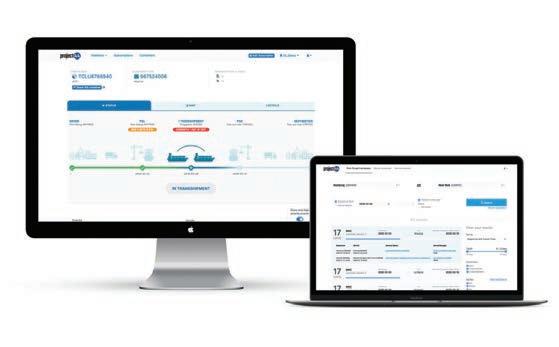
84 | MHD AUGUST 2023 MHD PRODUCT SHOWCASE
PEOPLE ON THE MOVE
A monthly wrap up of the latest appointments in the supply chain, materials handling and logistics industry.
KÖRBER INTRODUCES NEW SALES EXECUTIVE

Peter Zann recently joined Körber, bringing a wealth of experience to contribute to Körber’s rapid growth. With more than 20 years of experience in selling turnkey automated systems and software, Peter brings his knowledge in business development and a consultative approach that prioritises delivering exceptional customer experiences. His passion lies in fostering strong relationships and assisting customers.
ARGON & CO APPOINTS ANOTHER ANZ PARTNER
Colleen Grady has been appointed as ANZ Partner at global management consultancy, Argon & Co. Based in the Sydney office with a remit across the region, Colleen brings a wealth of experience from the retail and FMCG industry alongside an expansive career in consulting. After graduating from global top tier INSEAD with an MBA, Colleen built a track record of successful transformations.
COLLIERS PROMOTES FROM WITHIN

Sean Thomson was recently promoted to National Director, Industrial Capital Markets, Industrial. He will continue to add value for clients in the sales of industrial & logistics assets nationally. Sean demonstrates an exceptional work ethic, market knowledge, and has significant experience in working with corporate, private, institutional, and international investors.
REGIONAL DIRECTOR BECOMES RWTA BOARD MEMBER
The Refrigerated Warehouse and Transport Association of Australia (RWTA) welcomes Ashlee Arnall of Lineage Logistics as its newest Board Member. She is the Regional Director Operations, North. Ashlee is accountable for operational management and performance of the New South Wales and Queensland warehousing and transport businesses at Lineage.

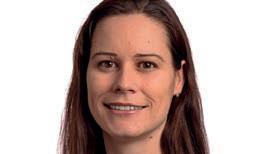
MUSHINY ENTERS AUSTRALIAN MARKET
Mushiny Intelligence, a global robotics company, has launched in Australia and appointed Byron Patching and Peter Ramsay as Directors of its Australian and New Zealand (ANZ) entity.
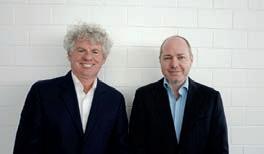
TOMPKINS ROBOTICS NAMES VICE PRESIDENT FOR PICKPAL SOLUTIONS


Tompkins Robotics has named Tony Villanova Vice President, PickPal Solutions. In this new senior leadership role, Tony will spearhead the development of the company’s flagship picking solution in support of the continued growth of its industry-leading autonomous mobile robotic (AMR) system, tSort. Tony brings more than two decades of supply chain operations expertise to Tompkins Robotics.
Do you have career news to share? Email Edward Cranswick at Edward.Cranswick@primecreative.com.au to be featured.
MHD PEOPLE ON THE MOVE
85 | MHD AUGUST 2023
Taking Intralogistics to the next level
Argon & Co ANZ’s new Intralogistics service offering will be powered by Fuzzy LogX, who fully integrated with Argon & Co in June 2023 after joining earlier this year.


Fuzzy LogX has a market leading proposition in intralogistics, with expertise in warehouse automation and technology, and proven track record of delivering large client engagements. Like Argon & Co, their in-depth market knowledge delivers process improvements and lasting results for clients around the globe.



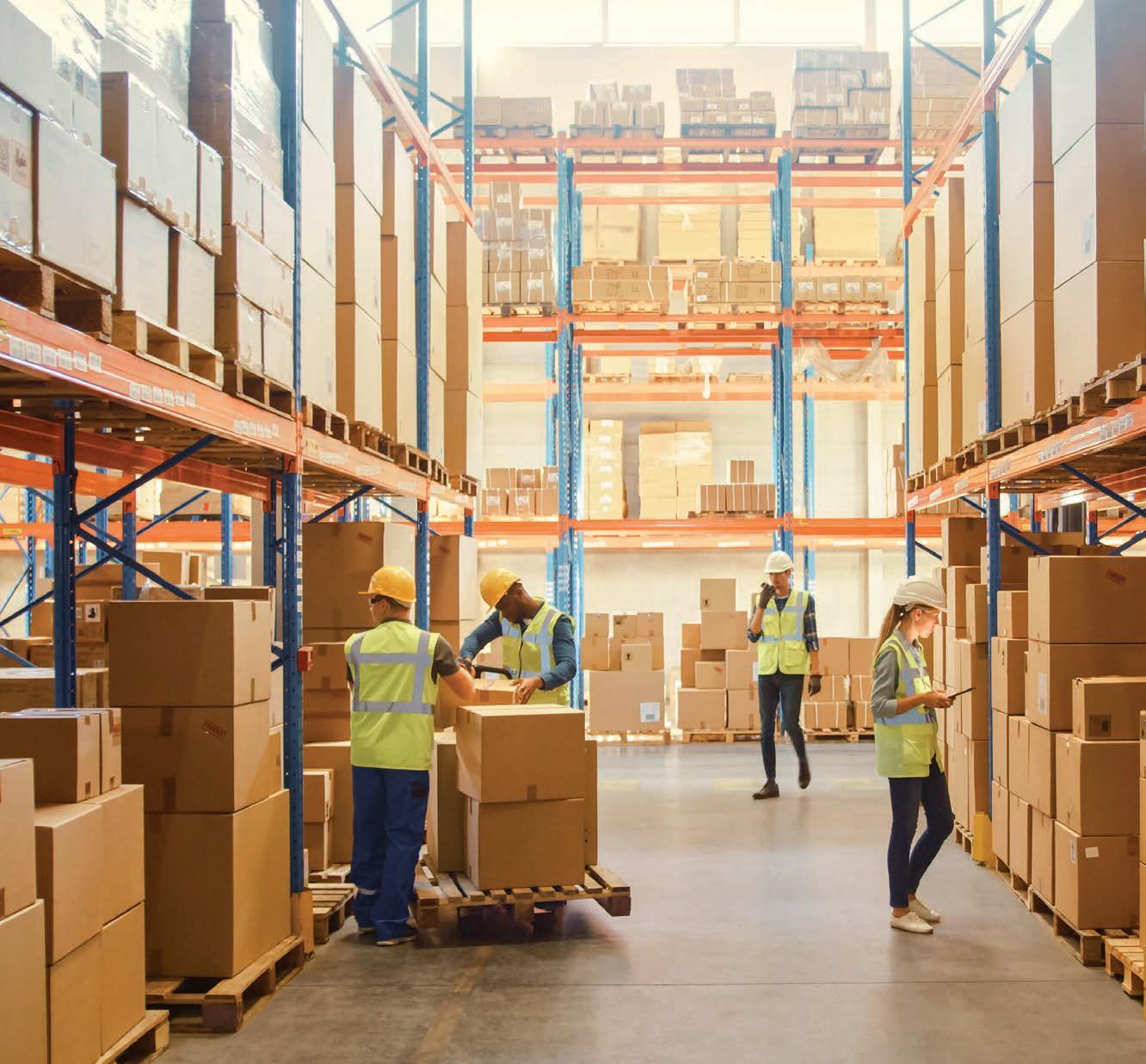
Our Intralogistics sub-services: -Intralogistics concept to go-live management -Intralogistics advanced analytics -Intralogistics process excellence benchmarking -Warehouse management and control systems -Automation health check and rescue Scan to find out more: Visit: argonandco.com/en/ services/logistics
2 5
Amazing performance, extensive battery life and unrivalled ergonomics combined with all the advantages of the Combi-CB range make the CB70E the most powerful, compact multidirectional forklift yet.
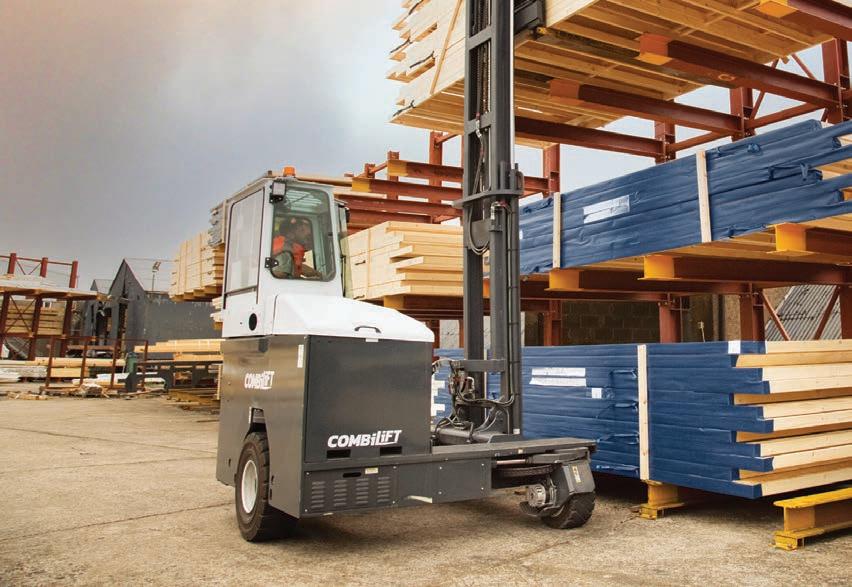
The new COMBi-CB70E electric forklift is the most compact 7,000kg counterbalance truck on the market. Multidirectional ability enables the handling of both long and bulky loads, maximising the safety, storage & efficiency of your logistics.
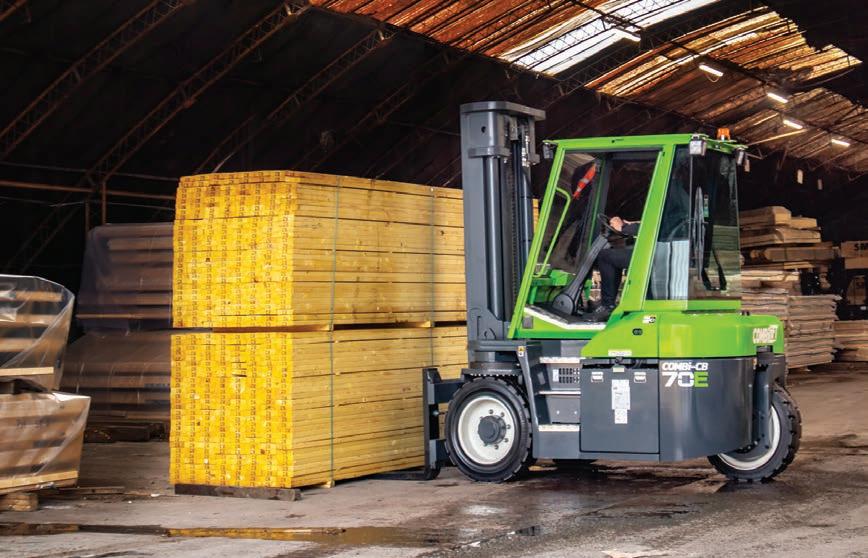
The CB70E is loaded with a host of features that greatly enhance operator comfort, including excellent all-round visibility, a spacious gas-strut suspension cab, independent electric traction and our newly developed Auto Swivel Seat which intelligently swivels 15 O in the direction of travel.
Contact Us Today
To find out how Combilift can help you unlock every inch of your storage space.

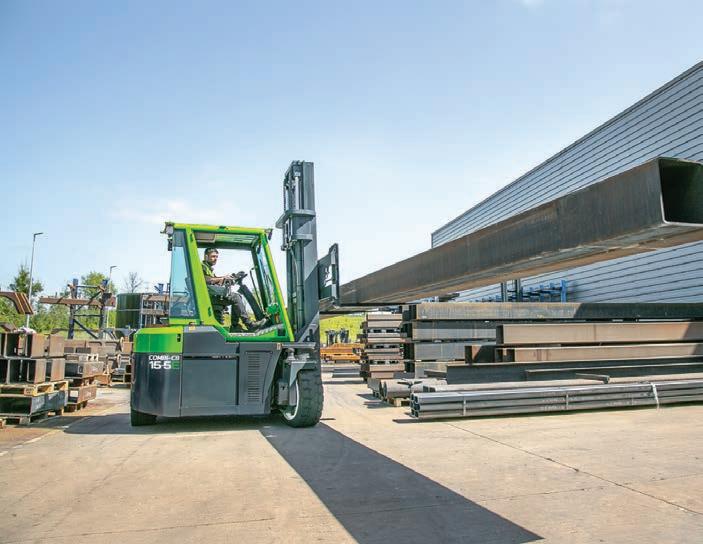
combilift.com

Introducing




































































































































































































